E-commerce success model Information 2022
VerifiedAdded on 2022/08/25
|58
|22954
|28
AI Summary
Please develop a table of at least 25 articles Citation Research objectives Methodology Findings Conclusion/Future research Find answers to these questions 1- what are the important infrastructure needed in a company and a country to make e-commerce work 2- success factors for e-commerce adoption 3- e-commerce in airlines 4- code sharing 5- competiteve advantage 6- the personalization through e- commerce all those related chapter 2
Contribute Materials
Your contribution can guide someone’s learning journey. Share your
documents today.
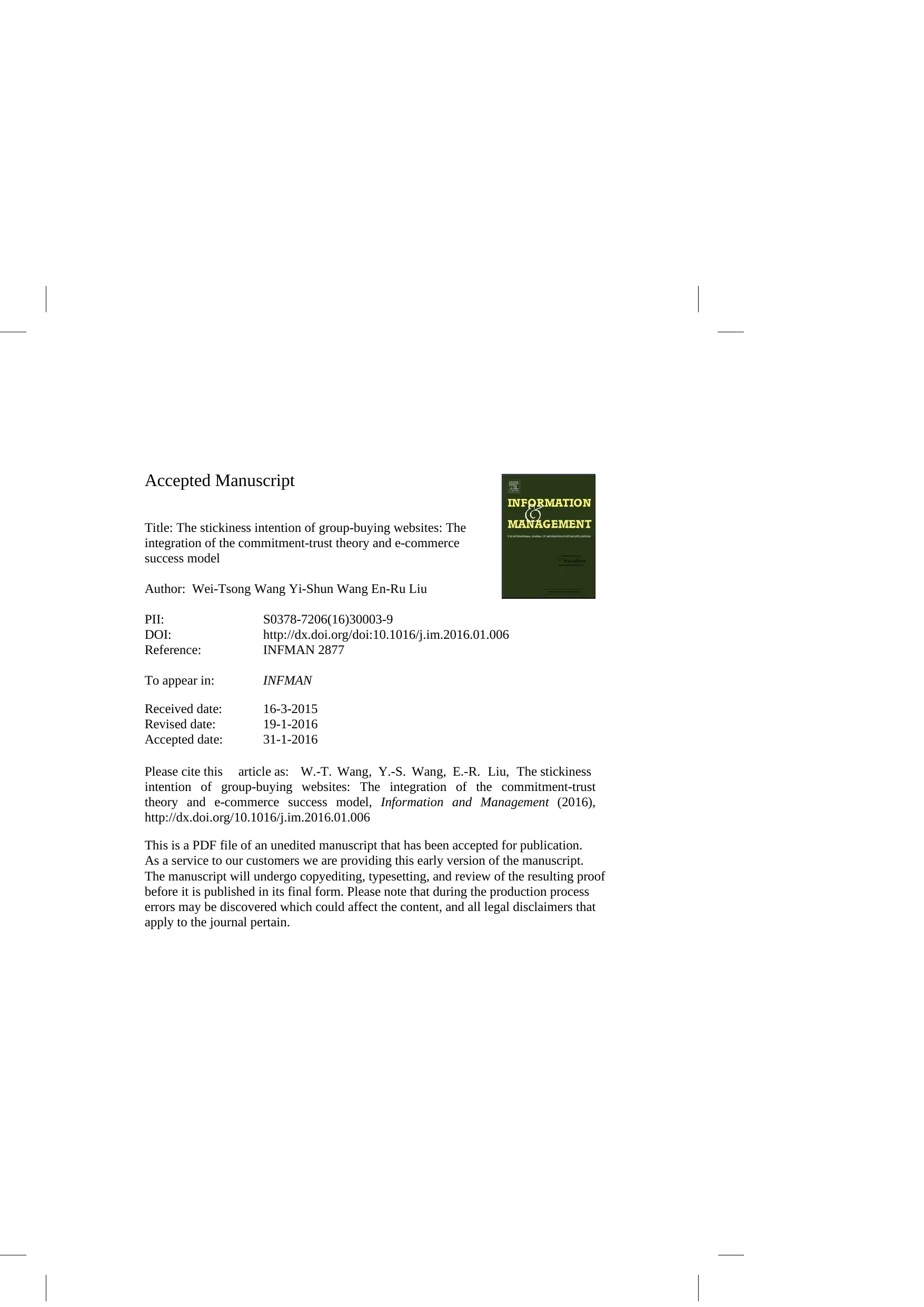
Accepted Manuscript
Title: The stickiness intention of group-buying websites: The
integration of the commitment-trust theory and e-commerce
success model
Author: Wei-Tsong Wang Yi-Shun Wang En-Ru Liu
PII: S0378-7206(16)30003-9
DOI: http://dx.doi.org/doi:10.1016/j.im.2016.01.006
Reference: INFMAN 2877
To appear in: INFMAN
Received date: 16-3-2015
Revised date: 19-1-2016
Accepted date: 31-1-2016
Please cite this article as: W.-T. Wang, Y.-S. Wang, E.-R. Liu, The stickiness
intention of group-buying websites: The integration of the commitment-trust
theory and e-commerce success model, Information and Management (2016),
http://dx.doi.org/10.1016/j.im.2016.01.006
This is a PDF file of an unedited manuscript that has been accepted for publication.
As a service to our customers we are providing this early version of the manuscript.
The manuscript will undergo copyediting, typesetting, and review of the resulting proof
before it is published in its final form. Please note that during the production process
errors may be discovered which could affect the content, and all legal disclaimers that
apply to the journal pertain.
Title: The stickiness intention of group-buying websites: The
integration of the commitment-trust theory and e-commerce
success model
Author: Wei-Tsong Wang Yi-Shun Wang En-Ru Liu
PII: S0378-7206(16)30003-9
DOI: http://dx.doi.org/doi:10.1016/j.im.2016.01.006
Reference: INFMAN 2877
To appear in: INFMAN
Received date: 16-3-2015
Revised date: 19-1-2016
Accepted date: 31-1-2016
Please cite this article as: W.-T. Wang, Y.-S. Wang, E.-R. Liu, The stickiness
intention of group-buying websites: The integration of the commitment-trust
theory and e-commerce success model, Information and Management (2016),
http://dx.doi.org/10.1016/j.im.2016.01.006
This is a PDF file of an unedited manuscript that has been accepted for publication.
As a service to our customers we are providing this early version of the manuscript.
The manuscript will undergo copyediting, typesetting, and review of the resulting proof
before it is published in its final form. Please note that during the production process
errors may be discovered which could affect the content, and all legal disclaimers that
apply to the journal pertain.
Secure Best Marks with AI Grader
Need help grading? Try our AI Grader for instant feedback on your assignments.

Page 1 of 57
Accepted Manuscript
1
Title:
The stickiness intention of group-buying websites: The integration of the commitment-trust
theory and e-commerce success model.
Authors:
Wei-Tsong Wang (Corresponding author)
Associate Professor, Department of Industrial and Information Management,
National Cheng Kung University,
1st University Road, Tainan 701, Taiwan;
Tel: +886-6-2757575 ext.53122; Fax: +886-6-2362162
wtwang@mail.ncku.edu.tw
Yi-Shun Wang
Professor, Department of Information Management,
National Changhua University of Education,
No.2, Shi-Da Road, Changhua City 500, Taiwan
Tel: +886-4-7232105 ext.7331; Fax: +886-4-7211162
yswang@cc.ncue.edu.tw
En-Ru Liu
Institute of Industrial and Information Management,
National Cheng Kung University,
1st University Road, Tainan 701, Taiwan
Accepted Manuscript
1
Title:
The stickiness intention of group-buying websites: The integration of the commitment-trust
theory and e-commerce success model.
Authors:
Wei-Tsong Wang (Corresponding author)
Associate Professor, Department of Industrial and Information Management,
National Cheng Kung University,
1st University Road, Tainan 701, Taiwan;
Tel: +886-6-2757575 ext.53122; Fax: +886-6-2362162
wtwang@mail.ncku.edu.tw
Yi-Shun Wang
Professor, Department of Information Management,
National Changhua University of Education,
No.2, Shi-Da Road, Changhua City 500, Taiwan
Tel: +886-4-7232105 ext.7331; Fax: +886-4-7211162
yswang@cc.ncue.edu.tw
En-Ru Liu
Institute of Industrial and Information Management,
National Cheng Kung University,
1st University Road, Tainan 701, Taiwan

Page 2 of 57
Accepted Manuscript
2
Tel: +886-6-2757575 ext.53120-109; Fax: +886-6-2362162
p80511427@gmail.com
ACKNOWLEDGMENTS
The authors thank the Editor and the anonymous reviewers for their valuable feedback
on this paper. The authors also thank the administrators of the online forums and websites
studied for their support and the survey respondents for providing valuable data. This
research was funded by Ministry of Science and Technology, Taiwan [grant number: MOST
103-2410-H-006-043].
Accepted Manuscript
2
Tel: +886-6-2757575 ext.53120-109; Fax: +886-6-2362162
p80511427@gmail.com
ACKNOWLEDGMENTS
The authors thank the Editor and the anonymous reviewers for their valuable feedback
on this paper. The authors also thank the administrators of the online forums and websites
studied for their support and the survey respondents for providing valuable data. This
research was funded by Ministry of Science and Technology, Taiwan [grant number: MOST
103-2410-H-006-043].
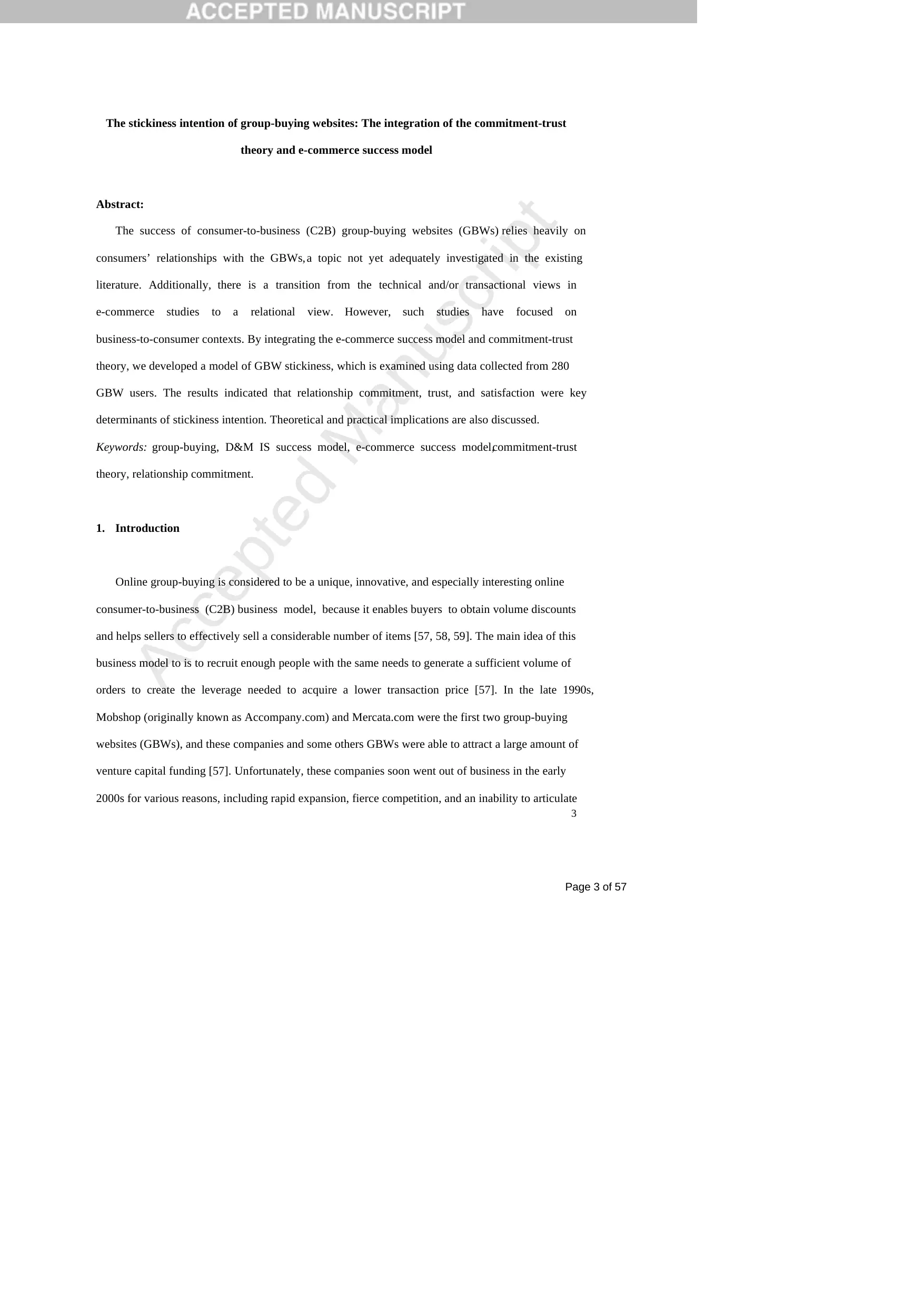
Page 3 of 57
Accepted Manuscript
3
The stickiness intention of group-buying websites: The integration of the commitment-trust
theory and e-commerce success model
Abstract:
The success of consumer-to-business (C2B) group-buying websites (GBWs) relies heavily on
consumers’ relationships with the GBWs, a topic not yet adequately investigated in the existing
literature. Additionally, there is a transition from the technical and/or transactional views in
e-commerce studies to a relational view. However, such studies have focused on
business-to-consumer contexts. By integrating the e-commerce success model and commitment-trust
theory, we developed a model of GBW stickiness, which is examined using data collected from 280
GBW users. The results indicated that relationship commitment, trust, and satisfaction were key
determinants of stickiness intention. Theoretical and practical implications are also discussed.
Keywords: group-buying, D&M IS success model, e-commerce success model,commitment-trust
theory, relationship commitment.
1. Introduction
Online group-buying is considered to be a unique, innovative, and especially interesting online
consumer-to-business (C2B) business model, because it enables buyers to obtain volume discounts
and helps sellers to effectively sell a considerable number of items [57, 58, 59]. The main idea of this
business model to is to recruit enough people with the same needs to generate a sufficient volume of
orders to create the leverage needed to acquire a lower transaction price [57]. In the late 1990s,
Mobshop (originally known as Accompany.com) and Mercata.com were the first two group-buying
websites (GBWs), and these companies and some others GBWs were able to attract a large amount of
venture capital funding [57]. Unfortunately, these companies soon went out of business in the early
2000s for various reasons, including rapid expansion, fierce competition, and an inability to articulate
Accepted Manuscript
3
The stickiness intention of group-buying websites: The integration of the commitment-trust
theory and e-commerce success model
Abstract:
The success of consumer-to-business (C2B) group-buying websites (GBWs) relies heavily on
consumers’ relationships with the GBWs, a topic not yet adequately investigated in the existing
literature. Additionally, there is a transition from the technical and/or transactional views in
e-commerce studies to a relational view. However, such studies have focused on
business-to-consumer contexts. By integrating the e-commerce success model and commitment-trust
theory, we developed a model of GBW stickiness, which is examined using data collected from 280
GBW users. The results indicated that relationship commitment, trust, and satisfaction were key
determinants of stickiness intention. Theoretical and practical implications are also discussed.
Keywords: group-buying, D&M IS success model, e-commerce success model,commitment-trust
theory, relationship commitment.
1. Introduction
Online group-buying is considered to be a unique, innovative, and especially interesting online
consumer-to-business (C2B) business model, because it enables buyers to obtain volume discounts
and helps sellers to effectively sell a considerable number of items [57, 58, 59]. The main idea of this
business model to is to recruit enough people with the same needs to generate a sufficient volume of
orders to create the leverage needed to acquire a lower transaction price [57]. In the late 1990s,
Mobshop (originally known as Accompany.com) and Mercata.com were the first two group-buying
websites (GBWs), and these companies and some others GBWs were able to attract a large amount of
venture capital funding [57]. Unfortunately, these companies soon went out of business in the early
2000s for various reasons, including rapid expansion, fierce competition, and an inability to articulate
Secure Best Marks with AI Grader
Need help grading? Try our AI Grader for instant feedback on your assignments.

Page 4 of 57
Accepted Manuscript
4
promising revenue models [13]. Surprisingly, group-buying businesses have been trying to make a
comeback in recent years [58], and the number of GBWs is rapidly increasing around the globe,
particularly in East Asia [57]. Recent statistics indicate that by 2015, revenue for the online
group-buying market will reach 4.17 billion dollars in the United States. Managers of many
commercial websites have put efforts into developing their own group-buying business models by
providing group-buying functions on their websites (such as Yahoo!) or by merging with foreign
group-buying websites to pursue foreign markets (such as Groupon’s merger with Atlaspost.com to
enter the Asian online group-buying market) [16]. These developments suggestthat although this
business model has not yet proven to be a long-term success, it appears to have a bright future.
However, as the size of the online group-buying market continues to grow, the accompanying
competition has made it increasingly difficult for GBWs to retain their customers [16]. Some statistics
indicate that in the first quarter of 2012, more than 70% (approximately 4,000) of the GBWs in China
went out of business or switched to other online business models because of consumer dissatisfaction
and difficulties in building consumer loyalty. Online group-buying activities tend to face risk- and
trust-related issues that significantly affect online consumers’ participation intention to and that are
not present in other online retailing mechanisms [58]. For example, compared to other online
transaction mechanisms, consumers of online group-buying activities are more uncertain about the
final purchasing price or whether the group-buying initiatives will succeed, because an insufficient
number of group-buying participants may lead to a relatively higher purchasing price or even a failed
group-buying initiative. Participants may also suffer from financial losses because of the
incompetence of the online group-buying intermediaries in preventing deceitful behaviors.
Consequently, the risk and trust issues related to online group-buying deserve close examination from
a relational perspective.
Despite the practical relevance outlined above, the findings of the extent information system (IS)
literature are insufficient in terms of offering a holistic theoretical ground for understanding consumer
intentions regarding the use of GBWs. While electronic commerce (e-commerce) professionals find it
Accepted Manuscript
4
promising revenue models [13]. Surprisingly, group-buying businesses have been trying to make a
comeback in recent years [58], and the number of GBWs is rapidly increasing around the globe,
particularly in East Asia [57]. Recent statistics indicate that by 2015, revenue for the online
group-buying market will reach 4.17 billion dollars in the United States. Managers of many
commercial websites have put efforts into developing their own group-buying business models by
providing group-buying functions on their websites (such as Yahoo!) or by merging with foreign
group-buying websites to pursue foreign markets (such as Groupon’s merger with Atlaspost.com to
enter the Asian online group-buying market) [16]. These developments suggestthat although this
business model has not yet proven to be a long-term success, it appears to have a bright future.
However, as the size of the online group-buying market continues to grow, the accompanying
competition has made it increasingly difficult for GBWs to retain their customers [16]. Some statistics
indicate that in the first quarter of 2012, more than 70% (approximately 4,000) of the GBWs in China
went out of business or switched to other online business models because of consumer dissatisfaction
and difficulties in building consumer loyalty. Online group-buying activities tend to face risk- and
trust-related issues that significantly affect online consumers’ participation intention to and that are
not present in other online retailing mechanisms [58]. For example, compared to other online
transaction mechanisms, consumers of online group-buying activities are more uncertain about the
final purchasing price or whether the group-buying initiatives will succeed, because an insufficient
number of group-buying participants may lead to a relatively higher purchasing price or even a failed
group-buying initiative. Participants may also suffer from financial losses because of the
incompetence of the online group-buying intermediaries in preventing deceitful behaviors.
Consequently, the risk and trust issues related to online group-buying deserve close examination from
a relational perspective.
Despite the practical relevance outlined above, the findings of the extent information system (IS)
literature are insufficient in terms of offering a holistic theoretical ground for understanding consumer
intentions regarding the use of GBWs. While electronic commerce (e-commerce) professionals find it

Page 5 of 57
Accepted Manuscript
5
increasingly difficult to motivate online consumers to stick to a specific website, significant efforts
have been made to evaluate the success of e-commerce websites from technical/IS and/or
transactional perspectives [80, 109, 117]. The technical/IS view, which is also referred to as the
socio-technical view, presumes that issues related to the user adoption of IS/websites are to be
investigated by primarily considering how the design and use of IS/websites can fit with
organizational objectives by being an integral part of organizational communication, cooperation, and
operational arrangement mechanisms (i.e., the social/organizational role of IS)[50]. Additionally,
Petter et al. [94] indicate that considerations related to consumer benefits (i.e., the transactional view)
and consumer use of e-commerce systems (i.e., the technical view) are essential in assessing the
success of IS in various contexts.
However, in addition to the technical perspective, there has been a transition from a transactional
view, which emphasizes the post-purchase satisfaction paradigm, to a relational view, which
emphasizes the importance of social and psychological factors (e.g., trust and commitment), in
studies of the interactions between online consumers and e-commerce websites [72]. Satisfaction
alone may not always guarantee repatronage or the continued use of an e-commerce website [57, 93].
When consumers have convenient access to alternative online vendors that have features that are
similar to or indistinguishable from their original online vendors, satisfaction may not be enough to
prevent these consumers from switching to these alternatives [72]. Consequently, the formation of a
relational bond is critical to discouraging the switching behaviors of online consumers [16].
Additionally, Zhou et al. [119] argue that satisfaction (i.e., a transactional factor) is backward-looking
and more transitory than commitment, and reflects a response to day-to-day events and contextual
changes. In contrast, commitment (i.e., a relational factor) is forward-looking and more enduring over
time in influencing individuals’ behavioral intentions, free from the influences of short-term changes
in situational elements. To sum up, while the transactional view focuses on the one-time provision of
various benefits and favorable experiences to online consumers during the interactions they have with
e-vendors/websites, the relational view primarily emphasizes the development and maintenance of
Accepted Manuscript
5
increasingly difficult to motivate online consumers to stick to a specific website, significant efforts
have been made to evaluate the success of e-commerce websites from technical/IS and/or
transactional perspectives [80, 109, 117]. The technical/IS view, which is also referred to as the
socio-technical view, presumes that issues related to the user adoption of IS/websites are to be
investigated by primarily considering how the design and use of IS/websites can fit with
organizational objectives by being an integral part of organizational communication, cooperation, and
operational arrangement mechanisms (i.e., the social/organizational role of IS)[50]. Additionally,
Petter et al. [94] indicate that considerations related to consumer benefits (i.e., the transactional view)
and consumer use of e-commerce systems (i.e., the technical view) are essential in assessing the
success of IS in various contexts.
However, in addition to the technical perspective, there has been a transition from a transactional
view, which emphasizes the post-purchase satisfaction paradigm, to a relational view, which
emphasizes the importance of social and psychological factors (e.g., trust and commitment), in
studies of the interactions between online consumers and e-commerce websites [72]. Satisfaction
alone may not always guarantee repatronage or the continued use of an e-commerce website [57, 93].
When consumers have convenient access to alternative online vendors that have features that are
similar to or indistinguishable from their original online vendors, satisfaction may not be enough to
prevent these consumers from switching to these alternatives [72]. Consequently, the formation of a
relational bond is critical to discouraging the switching behaviors of online consumers [16].
Additionally, Zhou et al. [119] argue that satisfaction (i.e., a transactional factor) is backward-looking
and more transitory than commitment, and reflects a response to day-to-day events and contextual
changes. In contrast, commitment (i.e., a relational factor) is forward-looking and more enduring over
time in influencing individuals’ behavioral intentions, free from the influences of short-term changes
in situational elements. To sum up, while the transactional view focuses on the one-time provision of
various benefits and favorable experiences to online consumers during the interactions they have with
e-vendors/websites, the relational view primarily emphasizes the development and maintenance of

Page 6 of 57
Accepted Manuscript
6
sustainable and favorable relationships between online consumers and e-vendors/websites through
personalized social and psychological exchanges [72, 102].
Commitment-trust theory [86] enables researchers to consider the formation and the effects of
the relational bond between two exchange parties by proposing relationship commitment and trust as
key factors that influence the consumers’ attitudes toward a particular business. Commitment-trust
theory has drawn the attention of e-commerce researchers [53, 72, 87, 106]. However, e-commerce
studies that adopt the relational view primarily focus on business-to-consumer (B2C) or
business-to-business (B2B) contexts and emphasize the effects of trust on consumer behaviors [2, 62,
103]. Very few of these studies focus on C2B contexts, such as consumer-initiated online
group-buying transactions [16, 63, 104], particularly from the perspective of relationship
commitments among the various parties. Consequently, the interesting and important issue of why
some GBWs fail while others survive deserves to be investigated by specific research efforts using
theoretical analysis [15]. With that motivation, this study aims to address the following research
question (RQ):
RQ: What factors affect online consumers’ intention to stick with a specific GBW for participating in
online group-buying activities?
To answer this question, the primary purposes of this study are thus twofold. First, the transition
from the technical and/or transactional views to a relational view indicates that the key to the success
of e-commerce websites lies not only in customer satisfaction, but also in the relational attachments
of online customers to these websites. Consequently,this study develops a theoretical model to
evaluate the success of e-commerce websites by integrating the technical, transactional, and relational
views using the commitment-trust theory [86] and e-commerce success model [109] as the theoretical
basis. In addition to the emphasis on the importance of relationship commitment and trust in
predicting volitional user behavior of online services,the proposed set of antecedents (e.g., cost-,
benefits-, and value-related factors) of commitment-trust theory implicitly incorporate the notion of
the transactional view. This makes the commitment-trust theory an appropriate theory that
Accepted Manuscript
6
sustainable and favorable relationships between online consumers and e-vendors/websites through
personalized social and psychological exchanges [72, 102].
Commitment-trust theory [86] enables researchers to consider the formation and the effects of
the relational bond between two exchange parties by proposing relationship commitment and trust as
key factors that influence the consumers’ attitudes toward a particular business. Commitment-trust
theory has drawn the attention of e-commerce researchers [53, 72, 87, 106]. However, e-commerce
studies that adopt the relational view primarily focus on business-to-consumer (B2C) or
business-to-business (B2B) contexts and emphasize the effects of trust on consumer behaviors [2, 62,
103]. Very few of these studies focus on C2B contexts, such as consumer-initiated online
group-buying transactions [16, 63, 104], particularly from the perspective of relationship
commitments among the various parties. Consequently, the interesting and important issue of why
some GBWs fail while others survive deserves to be investigated by specific research efforts using
theoretical analysis [15]. With that motivation, this study aims to address the following research
question (RQ):
RQ: What factors affect online consumers’ intention to stick with a specific GBW for participating in
online group-buying activities?
To answer this question, the primary purposes of this study are thus twofold. First, the transition
from the technical and/or transactional views to a relational view indicates that the key to the success
of e-commerce websites lies not only in customer satisfaction, but also in the relational attachments
of online customers to these websites. Consequently,this study develops a theoretical model to
evaluate the success of e-commerce websites by integrating the technical, transactional, and relational
views using the commitment-trust theory [86] and e-commerce success model [109] as the theoretical
basis. In addition to the emphasis on the importance of relationship commitment and trust in
predicting volitional user behavior of online services,the proposed set of antecedents (e.g., cost-,
benefits-, and value-related factors) of commitment-trust theory implicitly incorporate the notion of
the transactional view. This makes the commitment-trust theory an appropriate theory that
Paraphrase This Document
Need a fresh take? Get an instant paraphrase of this document with our AI Paraphraser

Page 7 of 57
Accepted Manuscript
7
complements the transactional view from a relational marketing perspective. Additionally, the
e-commerce success model, by integrating the technical/IS and transactional views, depicts
individuals’ perceptions regarding their interactions with the IS/websites, which resemble their
evaluation of their relationships with the IS/websites. This feature makes the e-commerce success
model an important theoretical base for this study in terms of integrating the technical, transactional,
and relational views by complementing the insufficiency of the commitment-trust theory in terms of
capturing the antecedents of commitment and trust that are associated with online business contexts.
Second, relatively few studies have empirically examined issues related to customer retention in
online C2B contexts. Consequently, this study empirically examines the proposed model in the
context of online group-buying activities via GBWs.
This study contributes to both the emerging online group-buying literature and general
e-commerce literature in a number of ways. First, to the best of our knowledge, this study is among
the first to provide an integrated theoretical insights into understanding online consumers’ stickiness
intention regarding GBWs by incorporating antecedent and intervening factors that are critical to the
online group-buying context from technical, transactional, and relational perspectives. Second, while
the e-commerce success model has been frequently applied to studies of post-purchase adoption in
various e-commerce contexts [20, 105, 109], our findings contribute to this model by adopting and
validating it in the online group-buying (C2B) context. Finally, although the commitment-trust theory
has been partially applied to e-commerce studies [62, 72, 87, 103, 106], this study applied it to
simultaneously investigate the effects of relationship commitment and trust on consumers’ intention
regarding the use of GBWs, thus extending its applicability.
2. Theoretical Background
2.1 Online group-buying
The core concept of online group-buying is that gathering a group of consumers with the same
Accepted Manuscript
7
complements the transactional view from a relational marketing perspective. Additionally, the
e-commerce success model, by integrating the technical/IS and transactional views, depicts
individuals’ perceptions regarding their interactions with the IS/websites, which resemble their
evaluation of their relationships with the IS/websites. This feature makes the e-commerce success
model an important theoretical base for this study in terms of integrating the technical, transactional,
and relational views by complementing the insufficiency of the commitment-trust theory in terms of
capturing the antecedents of commitment and trust that are associated with online business contexts.
Second, relatively few studies have empirically examined issues related to customer retention in
online C2B contexts. Consequently, this study empirically examines the proposed model in the
context of online group-buying activities via GBWs.
This study contributes to both the emerging online group-buying literature and general
e-commerce literature in a number of ways. First, to the best of our knowledge, this study is among
the first to provide an integrated theoretical insights into understanding online consumers’ stickiness
intention regarding GBWs by incorporating antecedent and intervening factors that are critical to the
online group-buying context from technical, transactional, and relational perspectives. Second, while
the e-commerce success model has been frequently applied to studies of post-purchase adoption in
various e-commerce contexts [20, 105, 109], our findings contribute to this model by adopting and
validating it in the online group-buying (C2B) context. Finally, although the commitment-trust theory
has been partially applied to e-commerce studies [62, 72, 87, 103, 106], this study applied it to
simultaneously investigate the effects of relationship commitment and trust on consumers’ intention
regarding the use of GBWs, thus extending its applicability.
2. Theoretical Background
2.1 Online group-buying
The core concept of online group-buying is that gathering a group of consumers with the same

Page 8 of 57
Accepted Manuscript
8
needs and then leveraging their collective bargaining power to lower the prices for the products or
services of interest [57]. The bargaining power thus grows with the number of consumers in a group.
Demand aggregation and volume discounting are thus key features of this business model [3]. The
primary value proposition of online group-buying to consumers is making a deal at a lower price by
connecting and uniting individuals who share the same needs on certain products/services in a
specific timeframe via the Internet to use their collective bargaining power to negotiate with the
sellers, and thus get volume discounts that were traditionally the privilege of bulk buyers [60, 78].
Additionally, sellers who participate in group-buying activities can be benefited by creating leverage
to reduce the cost of acquiring customers, which makes it possible to create a win-win situations for
both buyers and sellers [57].
Although the online group-buying model has been used in B2B contexts, its primary use is in the
purchase activities of end consumers, and the process is mostly accomplished via online
intermediaries. Online group-buying opportunities can either be marketer-initiated transactions, which
include merchant-initiated transactions and independent-third-party-initiated transactions, or
consumer-initiated transactions [16, 58, 63]. Consumer-initiated transactions are the most popular
forms of online group-buying, and this type of transaction is considered to represent a C2B business
model [13, 14]. In a consumer-initiated transaction, a consumer (i.e., the initiator), as the
representative of a group of consumers with the same needs, must actively negotiate with multiple
sellers for a discounted price on the product of interest, which is similar to asking sellers to bid on a
product for a group of potential buyers. Quantity discount is the major motivation of this
group-buying activity, and the pricing of this quantity order may either be a proposal sent by sellers or
the results of the negotiation process between the initiator and the sellers [13]. In this process, the
initiator may continue to put efforts into recruiting more consumers to join this shopping group, via
the use of online intermediaries, to meet the quantity requirement of a particular seller that is offering
the most favorable quantity discount. Eventually, if the quantity requirement is met before a specified
deadline, the shopping group closes the deal with this particular seller and a group-buying transaction
Accepted Manuscript
8
needs and then leveraging their collective bargaining power to lower the prices for the products or
services of interest [57]. The bargaining power thus grows with the number of consumers in a group.
Demand aggregation and volume discounting are thus key features of this business model [3]. The
primary value proposition of online group-buying to consumers is making a deal at a lower price by
connecting and uniting individuals who share the same needs on certain products/services in a
specific timeframe via the Internet to use their collective bargaining power to negotiate with the
sellers, and thus get volume discounts that were traditionally the privilege of bulk buyers [60, 78].
Additionally, sellers who participate in group-buying activities can be benefited by creating leverage
to reduce the cost of acquiring customers, which makes it possible to create a win-win situations for
both buyers and sellers [57].
Although the online group-buying model has been used in B2B contexts, its primary use is in the
purchase activities of end consumers, and the process is mostly accomplished via online
intermediaries. Online group-buying opportunities can either be marketer-initiated transactions, which
include merchant-initiated transactions and independent-third-party-initiated transactions, or
consumer-initiated transactions [16, 58, 63]. Consumer-initiated transactions are the most popular
forms of online group-buying, and this type of transaction is considered to represent a C2B business
model [13, 14]. In a consumer-initiated transaction, a consumer (i.e., the initiator), as the
representative of a group of consumers with the same needs, must actively negotiate with multiple
sellers for a discounted price on the product of interest, which is similar to asking sellers to bid on a
product for a group of potential buyers. Quantity discount is the major motivation of this
group-buying activity, and the pricing of this quantity order may either be a proposal sent by sellers or
the results of the negotiation process between the initiator and the sellers [13]. In this process, the
initiator may continue to put efforts into recruiting more consumers to join this shopping group, via
the use of online intermediaries, to meet the quantity requirement of a particular seller that is offering
the most favorable quantity discount. Eventually, if the quantity requirement is met before a specified
deadline, the shopping group closes the deal with this particular seller and a group-buying transaction

Page 9 of 57
Accepted Manuscript
9
is completed. This study focuses on consumer-initiated group-buying transactions.
The online group-buying mechanism is different from that of the traditional quantity discounts for
two main reasons [15, 58, 78]. One is that in a traditional quantity discount situation the seller sets its
own optimal discount quantity and price, while in a group-buying context the price is determined
based on the total quantity of the product/service that all the participating buyers want to buy. The
other is related to the special dynamics of the online group-buying model. In a traditional quantity
discount situation, individual buyers place their own orders based on the information provided by the
seller. However, in a group-buying context in which price is dynamic and uncertain (depending on the
collective bargaining power of the buyer group at the deadline of the group-buying activity), one
buyer’s order would affect the other buyers’ benefits from their participation of the group-buying
activity. Therefore, on many occasions potential buyers may not participate in an online group-buying
activity unless they see evidence that other buyers are participating enthusiastically, and that the
quantity discount threshold they desire is highly likely to be reached.
Online group-buying behaviors are also different from those of group bargaining or negotiations.
For example, negotiations among groups of companies tend to involve multifaceted issues, and thus
different negotiation strategies and decision rules may be applied based on the situations [8].
Additionally, individual members of a group may join the group for diverse motivations,and thus
integrative agreements that can maximize the joint benefits of the individual members in a group may
be mostly elusive [8]. Moreover, consumer groups that are formed on group-buying websites are
relatively unstable compared to traditional social or consumer cooperatives [63]. Consumers’ lack of
access and time to repeatedly interact with one another to develop personal relationships or a group
identity may contribute to the instability of these consumer groups. Thus, relying primarily on
group-related factors that apply to groups in online communities/social networking websites, such as
sense of belonging and group identity, may not be effective enough to help GBWs retain their
consumers. It is thus important for GBWs to develop relationships with individual consumers.
Additionally, consumers who participate in online group-buying activities tend to seek positive
Accepted Manuscript
9
is completed. This study focuses on consumer-initiated group-buying transactions.
The online group-buying mechanism is different from that of the traditional quantity discounts for
two main reasons [15, 58, 78]. One is that in a traditional quantity discount situation the seller sets its
own optimal discount quantity and price, while in a group-buying context the price is determined
based on the total quantity of the product/service that all the participating buyers want to buy. The
other is related to the special dynamics of the online group-buying model. In a traditional quantity
discount situation, individual buyers place their own orders based on the information provided by the
seller. However, in a group-buying context in which price is dynamic and uncertain (depending on the
collective bargaining power of the buyer group at the deadline of the group-buying activity), one
buyer’s order would affect the other buyers’ benefits from their participation of the group-buying
activity. Therefore, on many occasions potential buyers may not participate in an online group-buying
activity unless they see evidence that other buyers are participating enthusiastically, and that the
quantity discount threshold they desire is highly likely to be reached.
Online group-buying behaviors are also different from those of group bargaining or negotiations.
For example, negotiations among groups of companies tend to involve multifaceted issues, and thus
different negotiation strategies and decision rules may be applied based on the situations [8].
Additionally, individual members of a group may join the group for diverse motivations,and thus
integrative agreements that can maximize the joint benefits of the individual members in a group may
be mostly elusive [8]. Moreover, consumer groups that are formed on group-buying websites are
relatively unstable compared to traditional social or consumer cooperatives [63]. Consumers’ lack of
access and time to repeatedly interact with one another to develop personal relationships or a group
identity may contribute to the instability of these consumer groups. Thus, relying primarily on
group-related factors that apply to groups in online communities/social networking websites, such as
sense of belonging and group identity, may not be effective enough to help GBWs retain their
consumers. It is thus important for GBWs to develop relationships with individual consumers.
Additionally, consumers who participate in online group-buying activities tend to seek positive
Secure Best Marks with AI Grader
Need help grading? Try our AI Grader for instant feedback on your assignments.

Page 10 of 57
Accepted Manuscript
10
relationships with sellers, intermediary websites, and other consumers to reduce the uncertainties and
risks associated with online group-buying activities [58].
The social psychology literature suggests that frequent, favorable interpersonal interactions help
to reduce uncertainty and increase trust in others in a social context, and thus promote the emergence
of groups (i.e., social structures) [114]. Additionally, research finds that reciprocal exchanges tend to
enable and increase trust in others members of a group, and thus result in strong ties/relational bonds
among group members [85]. Different forms and levels of uncertainty may exist in different exchange
conditions, and thus may lead to different relationships and social structures among stakeholders in
the exchanges [64]. The arguments above indicate the need to specifically examine the effects of the
relationships among stakeholders in an online group-buying context on the use of the GBWs.In
summary, online group-buying is considered a unique online transaction method that deserves to be
investigated in its own right with regard to key success factors.
Most of the existing empirical studies of user behaviors of GBWs take a multi-perspective
approach for conceptualizing and explaining the use of GBWs, as summarized in Appendix A.
Despite the contributions of these previous studies, most of them do not investigate the users’
intention to use GBWs by simultaneously adoptions the technical, transactional, and relational
perspectives, except for the works of Lang et al. [68] and Yeh et al. [116]. However, the contribution
of those two studies are limited, because they neither incorporate the key factors of the three indicated
conceptual perspectives (e.g., system-related quality factors, satisfaction, and relationship
commitment) nor provide a reasonable nomological structure for explaining the interactions and
relationships between the key technical, transactional, and relational factors that they adopt for
comprehending GBW users’ intentions. Additionally, although some of these prior studies adopt the
incorporate some relational factors for investigating the use of GBWs, they are inadequate to offer
nuanced insights into users’ stickiness intention with GBWs from a relational perspective for two
reasons. One is that while some of those studies highlight the importance of investigating the use of
GBWs from a relational perspective, they primarily focus on how the relationships among members
Accepted Manuscript
10
relationships with sellers, intermediary websites, and other consumers to reduce the uncertainties and
risks associated with online group-buying activities [58].
The social psychology literature suggests that frequent, favorable interpersonal interactions help
to reduce uncertainty and increase trust in others in a social context, and thus promote the emergence
of groups (i.e., social structures) [114]. Additionally, research finds that reciprocal exchanges tend to
enable and increase trust in others members of a group, and thus result in strong ties/relational bonds
among group members [85]. Different forms and levels of uncertainty may exist in different exchange
conditions, and thus may lead to different relationships and social structures among stakeholders in
the exchanges [64]. The arguments above indicate the need to specifically examine the effects of the
relationships among stakeholders in an online group-buying context on the use of the GBWs.In
summary, online group-buying is considered a unique online transaction method that deserves to be
investigated in its own right with regard to key success factors.
Most of the existing empirical studies of user behaviors of GBWs take a multi-perspective
approach for conceptualizing and explaining the use of GBWs, as summarized in Appendix A.
Despite the contributions of these previous studies, most of them do not investigate the users’
intention to use GBWs by simultaneously adoptions the technical, transactional, and relational
perspectives, except for the works of Lang et al. [68] and Yeh et al. [116]. However, the contribution
of those two studies are limited, because they neither incorporate the key factors of the three indicated
conceptual perspectives (e.g., system-related quality factors, satisfaction, and relationship
commitment) nor provide a reasonable nomological structure for explaining the interactions and
relationships between the key technical, transactional, and relational factors that they adopt for
comprehending GBW users’ intentions. Additionally, although some of these prior studies adopt the
incorporate some relational factors for investigating the use of GBWs, they are inadequate to offer
nuanced insights into users’ stickiness intention with GBWs from a relational perspective for two
reasons. One is that while some of those studies highlight the importance of investigating the use of
GBWs from a relational perspective, they primarily focus on how the relationships among members

Page 11 of 57
Accepted Manuscript
11
of the buyers’ groups may influence their behaviors regarding the use of GBWs. The influence of the
relationships between online consumers and GBWs on the consumers’ intentions regarding the use of
GBWs remains an under-researched topic. The other is that research indicates that relationship
commitment and trust are vital for differentiating relational exchanges from pure economic exchanges,
and are thus considered to be critical factors for determining pro-relationship behaviors and
motivations [72, 86]. While a number of previous studies have leveraged the relational view to
investigate consumers’ adoption/post-adoption behavior with respect to GBWs, they comprehend the
building and development of such relationships as the consequence of interpersonal trust and various
forms of social influences. The important role of relationship commitment is unfortunately
overlooked, resulting in a conceptual gap in the current understanding of why online consumers stick
with a GBW given the fact that the use of GBWs are not as indispensable to today’s online users as
other types of websites, such as online portals [119].
2.2 E-commerce success model
DeLone and McLean’s [26, 27, 28] original and updated Information Systems Success models
(D&M ISS models) are among the most widely used for evaluating the degree of IS success because
of their comprehensiveness. The original D&M ISS model includes six dimensions: system quality,
information quality, user satisfaction, system use, individual impact, and organizational impact [26].
To meet the needs of academic assessments of IS success in response to changes in the role of such
systems, DeLone and McLean [27] proposed an updated D&M ISS model. This updated model
differs from the original in three ways: it adds a new dimension of service quality to the original
dimensions of system quality and information quality to more comprehensively evaluate the overall
quality of information systems; it includes the dimension of intention to use as an alternative to
system use in the contexts of non-mandatory system use (i.e. e-commerce); and it groups all the
impact measures (i.e., individual and organizational impacts) into a single impact/benefit dimension
called net benefit.
Accepted Manuscript
11
of the buyers’ groups may influence their behaviors regarding the use of GBWs. The influence of the
relationships between online consumers and GBWs on the consumers’ intentions regarding the use of
GBWs remains an under-researched topic. The other is that research indicates that relationship
commitment and trust are vital for differentiating relational exchanges from pure economic exchanges,
and are thus considered to be critical factors for determining pro-relationship behaviors and
motivations [72, 86]. While a number of previous studies have leveraged the relational view to
investigate consumers’ adoption/post-adoption behavior with respect to GBWs, they comprehend the
building and development of such relationships as the consequence of interpersonal trust and various
forms of social influences. The important role of relationship commitment is unfortunately
overlooked, resulting in a conceptual gap in the current understanding of why online consumers stick
with a GBW given the fact that the use of GBWs are not as indispensable to today’s online users as
other types of websites, such as online portals [119].
2.2 E-commerce success model
DeLone and McLean’s [26, 27, 28] original and updated Information Systems Success models
(D&M ISS models) are among the most widely used for evaluating the degree of IS success because
of their comprehensiveness. The original D&M ISS model includes six dimensions: system quality,
information quality, user satisfaction, system use, individual impact, and organizational impact [26].
To meet the needs of academic assessments of IS success in response to changes in the role of such
systems, DeLone and McLean [27] proposed an updated D&M ISS model. This updated model
differs from the original in three ways: it adds a new dimension of service quality to the original
dimensions of system quality and information quality to more comprehensively evaluate the overall
quality of information systems; it includes the dimension of intention to use as an alternative to
system use in the contexts of non-mandatory system use (i.e. e-commerce); and it groups all the
impact measures (i.e., individual and organizational impacts) into a single impact/benefit dimension
called net benefit.

Page 12 of 57
Accepted Manuscript
12
However, the literature has also noted the challenges and difficulties in using the D&M ISS
model. For example, in addition to providing information to customers, e-commerce systems are
expected to serve transactional purposes, including transaction processing and the provision of online
pre- and post-sales service [105]. Consequently, it is important to consider critical transactional
factors, such as customer satisfaction, fairness, perceived benefits/sacrifices, and loyalty-related
factors, when measuring the success of e-commerce systems. Additionally, it may be necessary to
respecify the relationships among the quality measures in the D&M ISS model and the additional
factors adopted to measure the success of e-commerce systems with reference to specific research
contexts [76, 117].
Wang [109] identifies three major defects of the primary versions of the D&M ISS model. First, the
construct of net benefit in the revised D&M ISS model [27] is too general and is difficult to define. In
the traditional marketing literature, perceived value is conceptualized as involving a consumer’s
evaluation of the ratio of the perceived gain (benefit) and perceived sacrifice (cost) of a transaction,
and is thus considered to be a key strategic construct for explaining repeat purchases, brand loyalty,
and relationship commitment [92]. Wang [109] argues that perceived value reflects a wide range of
costs and benefits of the use of an e-commerce system, and is a key net-benefit variable for
explaining the effects of online customers’ first-hand experiences with e-commerce systems on their
perceptions, such as the level of satisfaction, and on other e-commerce system success measures (e.g.,
loyalty-related constructs) in post-use situations, as done in existing e-commerce studies [4, 20, 77].
The second defect is that DeLone and McLean’s [27] did not attempt to reconcile their updated D&M
ISS model with the perspective of system use behaviors adopted in other IS studies, such as Davis et
al.’s [25] Technology Acceptance Model and Seddon’s [99] reformulation of the original D&M ISS
model, to deepen the theoretical perspective [109]. The last defect is that the nomological structure of
the updated D&M ISS model does not fully comply with the classic quality-value-satisfaction-loyalty
paradigm in the traditional marketing and consumer behavior literature [6, 23, 41, 91, 92].
Consequently, to eliminate those defects, Wang [109] proposes an e-commerce success model
Accepted Manuscript
12
However, the literature has also noted the challenges and difficulties in using the D&M ISS
model. For example, in addition to providing information to customers, e-commerce systems are
expected to serve transactional purposes, including transaction processing and the provision of online
pre- and post-sales service [105]. Consequently, it is important to consider critical transactional
factors, such as customer satisfaction, fairness, perceived benefits/sacrifices, and loyalty-related
factors, when measuring the success of e-commerce systems. Additionally, it may be necessary to
respecify the relationships among the quality measures in the D&M ISS model and the additional
factors adopted to measure the success of e-commerce systems with reference to specific research
contexts [76, 117].
Wang [109] identifies three major defects of the primary versions of the D&M ISS model. First, the
construct of net benefit in the revised D&M ISS model [27] is too general and is difficult to define. In
the traditional marketing literature, perceived value is conceptualized as involving a consumer’s
evaluation of the ratio of the perceived gain (benefit) and perceived sacrifice (cost) of a transaction,
and is thus considered to be a key strategic construct for explaining repeat purchases, brand loyalty,
and relationship commitment [92]. Wang [109] argues that perceived value reflects a wide range of
costs and benefits of the use of an e-commerce system, and is a key net-benefit variable for
explaining the effects of online customers’ first-hand experiences with e-commerce systems on their
perceptions, such as the level of satisfaction, and on other e-commerce system success measures (e.g.,
loyalty-related constructs) in post-use situations, as done in existing e-commerce studies [4, 20, 77].
The second defect is that DeLone and McLean’s [27] did not attempt to reconcile their updated D&M
ISS model with the perspective of system use behaviors adopted in other IS studies, such as Davis et
al.’s [25] Technology Acceptance Model and Seddon’s [99] reformulation of the original D&M ISS
model, to deepen the theoretical perspective [109]. The last defect is that the nomological structure of
the updated D&M ISS model does not fully comply with the classic quality-value-satisfaction-loyalty
paradigm in the traditional marketing and consumer behavior literature [6, 23, 41, 91, 92].
Consequently, to eliminate those defects, Wang [109] proposes an e-commerce success model
Paraphrase This Document
Need a fresh take? Get an instant paraphrase of this document with our AI Paraphraser

Page 13 of 57
Accepted Manuscript
13
based on the appraisal/beliefs emotional response/attitudes coping responses/behaviors framework
[6, 70]. System quality, information quality, service quality, and perceived value represent beliefs,
customer satisfaction refers to attitudes, and intention to reuse is a behavioral measure. The unique
merit of this model is its integration of the technical (system quality factors) and the transactional
(perceived value and customer satisfaction) views into a single model that can provide researchers
with a comprehensive theoretical basis for investigating e-commerce system success.
2.3 Commitment-trust theory
Consumers who have a positive relationship with an online vendor tend to develop a perception
of high switching costs, which may lead to the formation of long-term commitment and loyalty to the
online vendor [2, 16, 103].In contrast to the transactional view, which focuses on the short-term
provision of tangible and/or intangible benefits to attract and satisfy customers, the relational view
emphasizes the development of long-term relationships between online vendors/intermediaries and
consumers [72]. Thus, this view provides a better explanation of customer retention and loyalty.
The commitment-trust theory [86] focuses on explaining the development of long-term
relationship between exchanges parties [72]. This central premise of this theory is the simultaneous
adoption of relationship commitment and trust as inseparable criticalfactors for the forming and
maintaining business relationships between exchange parties. This theory also considers relationship
commitment and trust as the key mediators between five antecedent variables (relationship
termination costs, relationship benefits, shared values, communication, and opportunistic behavior)
and five outcome variables (acquiescence, propensity to leave, cooperation, functional conflict, and
decision-making uncertainty) for relationship development. This theory proposes that trust directly
influences relationship commitment because trust between two parties helps to reduce the
vulnerability that the parties perceive when they commit to an exchange relationship.
Trust is fundamental in e-commerce environments and has a number of commonalities [10]. First,
trust differs at different individual/group levels. Thus, trust cannot be applied across individual or
Accepted Manuscript
13
based on the appraisal/beliefs emotional response/attitudes coping responses/behaviors framework
[6, 70]. System quality, information quality, service quality, and perceived value represent beliefs,
customer satisfaction refers to attitudes, and intention to reuse is a behavioral measure. The unique
merit of this model is its integration of the technical (system quality factors) and the transactional
(perceived value and customer satisfaction) views into a single model that can provide researchers
with a comprehensive theoretical basis for investigating e-commerce system success.
2.3 Commitment-trust theory
Consumers who have a positive relationship with an online vendor tend to develop a perception
of high switching costs, which may lead to the formation of long-term commitment and loyalty to the
online vendor [2, 16, 103].In contrast to the transactional view, which focuses on the short-term
provision of tangible and/or intangible benefits to attract and satisfy customers, the relational view
emphasizes the development of long-term relationships between online vendors/intermediaries and
consumers [72]. Thus, this view provides a better explanation of customer retention and loyalty.
The commitment-trust theory [86] focuses on explaining the development of long-term
relationship between exchanges parties [72]. This central premise of this theory is the simultaneous
adoption of relationship commitment and trust as inseparable criticalfactors for the forming and
maintaining business relationships between exchange parties. This theory also considers relationship
commitment and trust as the key mediators between five antecedent variables (relationship
termination costs, relationship benefits, shared values, communication, and opportunistic behavior)
and five outcome variables (acquiescence, propensity to leave, cooperation, functional conflict, and
decision-making uncertainty) for relationship development. This theory proposes that trust directly
influences relationship commitment because trust between two parties helps to reduce the
vulnerability that the parties perceive when they commit to an exchange relationship.
Trust is fundamental in e-commerce environments and has a number of commonalities [10]. First,
trust differs at different individual/group levels. Thus, trust cannot be applied across individual or

Page 14 of 57
Accepted Manuscript
14
group settings. Second, researchers can view trust as a domain-specific psychological state that is
influenced by exogenous social factors in a given context, and that is relatively stable and insensitive
to situational stimuli. Finally, trust is clearly different from, but antecedent to, behavior.
With reference to the characteristics of e-commerce consumers’ actions, McKnight and Chervany
[84] propose an interdisciplinary typology of trust that includes four concepts: disposition to trust,
institution-based trust, trusting beliefs, and trusting intention. Disposition to trust refers to one’s trust
in general others, and institutional-based trust means one’s trust is context-specific, and that one feels
trust irrespective of the specific individuals in that context. This indicates that both disposition to trust
and institutional-based trust are not entity-specific. However, trusting beliefs and intentions are
individual-specific and cross-situational, which means that one trusts a specific individual/entity
across various situations/contexts [84]. Correspondingly, disposition to trust and institutional-based
trust are better treated as antecedents of trusting beliefs and intentions, and thus indirectly affect
trust-related behaviors via trusting beliefs and intentions [35]. This discussion implies that the
concept of trusting beliefs is more suitable for this study, because it helps researchers appropriately
investigate how online consumers’ trust in a specific website/online vendor influences their
interactions with the website/vendor across different e-commerce situations/contexts. We thus treat
trust as an aggregation of multiple dimensions of trusting beliefs [10, 29].The adoption of this
perspective of trusting beliefs enables researchers to understand the role of trust in e-commerce
settings from a more holistic view by referring to both cognitive and affective components of trust [10,
36].
Based on the above discussion, we thus identified trust as a second-order formative construct
measured by the three first-order sub-constructs of ability, benevolence, and integrity [10, 37, 80, 84].
First, a trustor’s belief in the ability of a trustee tends to be based on two primary forms of beliefs,
which are whether the trustee is competent at performing the tasks that need to be done, and whether
the trustee has access to knowledge required to perform the intended tasks, and thus is
domain-specific [10]. Consequently, e-commerce consumers’ trust in the ability of a specific website
Accepted Manuscript
14
group settings. Second, researchers can view trust as a domain-specific psychological state that is
influenced by exogenous social factors in a given context, and that is relatively stable and insensitive
to situational stimuli. Finally, trust is clearly different from, but antecedent to, behavior.
With reference to the characteristics of e-commerce consumers’ actions, McKnight and Chervany
[84] propose an interdisciplinary typology of trust that includes four concepts: disposition to trust,
institution-based trust, trusting beliefs, and trusting intention. Disposition to trust refers to one’s trust
in general others, and institutional-based trust means one’s trust is context-specific, and that one feels
trust irrespective of the specific individuals in that context. This indicates that both disposition to trust
and institutional-based trust are not entity-specific. However, trusting beliefs and intentions are
individual-specific and cross-situational, which means that one trusts a specific individual/entity
across various situations/contexts [84]. Correspondingly, disposition to trust and institutional-based
trust are better treated as antecedents of trusting beliefs and intentions, and thus indirectly affect
trust-related behaviors via trusting beliefs and intentions [35]. This discussion implies that the
concept of trusting beliefs is more suitable for this study, because it helps researchers appropriately
investigate how online consumers’ trust in a specific website/online vendor influences their
interactions with the website/vendor across different e-commerce situations/contexts. We thus treat
trust as an aggregation of multiple dimensions of trusting beliefs [10, 29].The adoption of this
perspective of trusting beliefs enables researchers to understand the role of trust in e-commerce
settings from a more holistic view by referring to both cognitive and affective components of trust [10,
36].
Based on the above discussion, we thus identified trust as a second-order formative construct
measured by the three first-order sub-constructs of ability, benevolence, and integrity [10, 37, 80, 84].
First, a trustor’s belief in the ability of a trustee tends to be based on two primary forms of beliefs,
which are whether the trustee is competent at performing the tasks that need to be done, and whether
the trustee has access to knowledge required to perform the intended tasks, and thus is
domain-specific [10]. Consequently, e-commerce consumers’ trust in the ability of a specific website

Page 15 of 57
Accepted Manuscript
15
can be viewed as the consumers’ belief in the website’s competence to provide its customers with
goods and transaction-related services in an appropriate and satisfactory manner [84].
Additionally, a trustor’s belief in a trustee’s benevolence means that the trustor believes that the
trustee actually cares about the trustor and will not do any intentional harm to the trustor, beyond the
trustee’s own benefit motives [37]. Benevolence thus embeds the elements of faith and altruism in a
trusting relationship, which reduces uncertainty and the perceived threats of the others’ opportunistic
behaviors [10]. Consequently, e-commerce consumers’ trust in the benevolence of a specific website
indicates that the consumers believe that this website will act in its customers’ best interests, not just
its own, when conducting a transaction [88].
Finally, a trustor’s belief in the integrity of a trustee means that the trustor believes that the trustee
will always follow a set of appropriate, accepted rules of conduct [36]. Focusing on a trustor’s belief
in a trustee’s domain ability is insufficient to understand the nature of trust-building between the two
parties, and thus researchers must take into considerations how much the trustor is confident that the
trustee will perform the intended behavior with integrity [10]. Consequently, e-commerce consumers’
trust in an online vendor’s integrity means that they believe the online vendor will fulfill its promises
and ethical obligations regarding a transaction by adhering to accepted rules.
Relationship commitment is one entity’s belief that its ongoing relationship with another entity is
important and beneficial, and thus that it is worth making a significant effort to ensure the
continuance of this relationship indefinitely [86]. Relationship commitment, as the outcome of
long-term satisfactory interactions between two exchange parties, would lead one party to assume that
no other exchange partners would provide similar benefits to those of its current exchange party, and
the partner would be less likely to shift to alternative exchange parties [31]. The concept of
relationship commitment has its root in the social psychology studies that primarily discuss the
development of interpersonal relationships/bonds, and how they influence the social power of an
individual in a relationship [82]. Commitment is critical to distinguishing social from economic
exchange theories, because the latter assumes that entities in a social exchange network make
Accepted Manuscript
15
can be viewed as the consumers’ belief in the website’s competence to provide its customers with
goods and transaction-related services in an appropriate and satisfactory manner [84].
Additionally, a trustor’s belief in a trustee’s benevolence means that the trustor believes that the
trustee actually cares about the trustor and will not do any intentional harm to the trustor, beyond the
trustee’s own benefit motives [37]. Benevolence thus embeds the elements of faith and altruism in a
trusting relationship, which reduces uncertainty and the perceived threats of the others’ opportunistic
behaviors [10]. Consequently, e-commerce consumers’ trust in the benevolence of a specific website
indicates that the consumers believe that this website will act in its customers’ best interests, not just
its own, when conducting a transaction [88].
Finally, a trustor’s belief in the integrity of a trustee means that the trustor believes that the trustee
will always follow a set of appropriate, accepted rules of conduct [36]. Focusing on a trustor’s belief
in a trustee’s domain ability is insufficient to understand the nature of trust-building between the two
parties, and thus researchers must take into considerations how much the trustor is confident that the
trustee will perform the intended behavior with integrity [10]. Consequently, e-commerce consumers’
trust in an online vendor’s integrity means that they believe the online vendor will fulfill its promises
and ethical obligations regarding a transaction by adhering to accepted rules.
Relationship commitment is one entity’s belief that its ongoing relationship with another entity is
important and beneficial, and thus that it is worth making a significant effort to ensure the
continuance of this relationship indefinitely [86]. Relationship commitment, as the outcome of
long-term satisfactory interactions between two exchange parties, would lead one party to assume that
no other exchange partners would provide similar benefits to those of its current exchange party, and
the partner would be less likely to shift to alternative exchange parties [31]. The concept of
relationship commitment has its root in the social psychology studies that primarily discuss the
development of interpersonal relationships/bonds, and how they influence the social power of an
individual in a relationship [82]. Commitment is critical to distinguishing social from economic
exchange theories, because the latter assumes that entities in a social exchange network make
Secure Best Marks with AI Grader
Need help grading? Try our AI Grader for instant feedback on your assignments.

Page 16 of 57
Accepted Manuscript
16
exchange decisions based primarily on rationality and do not develop longitudinal commitments to
one another [21]. Additionally, commitment is part of the endogenous process in a social exchange
network, because frequent exchanges increase individual entities’ knowledge of the others, resulting
in less uncertainty and trust in the others, thus leading to the formation of commitment between
exchanges parties [69]. Consequently, commitment and trust are key factors that shape the behavioral
patterns of exchanges between entities [64, 114].
3. Research Model and Hypotheses
3.1 The integrated research model for examining group-buying website success
The construct of use/intention to use is a worthwhile alternative IS success measure in some
contexts in which system use is mostly voluntary [27, 28]. However, it may be difficult to
operationalize this construct, because it may represent different meanings, including a proxy of the
net benefit from system use, future system use, and an event in a process leading to an individual or
organizational impact, and may thus not an appropriate measure of system success [99]. However, the
construct of intention to reuse reflects online consumers’ intentions of future use, which is similar to
the construct of customer loyalty, and is thus a more appropriate system success/net benefit measure
in e-commerce contexts [109]. Previous marketing and e-commerce studies tend to conceptualize
loyalty, as an outcome variable, from two primary aspects: behavioral and attitudinal/psychological
loyalty [11, 90]. Behavioral loyalty refers to repeated purchases/repatronage, while attitudinal loyalty
refers to the degree of dispositional preference toward an entity [11]. Prior studies tend to measure
behavioral loyalty using factors including repurchase intentions and customers’ share of spending
with a brand/seller, and attitudinal/psychological loyalty using factors including preference and
voluntary positive word-of-mouth [11, 90]. Behavioral loyalty is a state that includes a consumer’s
deeply held commitment to repurchase, which is likely to be converted to readiness to act and then
later lead to actual repurchases [89].
Accepted Manuscript
16
exchange decisions based primarily on rationality and do not develop longitudinal commitments to
one another [21]. Additionally, commitment is part of the endogenous process in a social exchange
network, because frequent exchanges increase individual entities’ knowledge of the others, resulting
in less uncertainty and trust in the others, thus leading to the formation of commitment between
exchanges parties [69]. Consequently, commitment and trust are key factors that shape the behavioral
patterns of exchanges between entities [64, 114].
3. Research Model and Hypotheses
3.1 The integrated research model for examining group-buying website success
The construct of use/intention to use is a worthwhile alternative IS success measure in some
contexts in which system use is mostly voluntary [27, 28]. However, it may be difficult to
operationalize this construct, because it may represent different meanings, including a proxy of the
net benefit from system use, future system use, and an event in a process leading to an individual or
organizational impact, and may thus not an appropriate measure of system success [99]. However, the
construct of intention to reuse reflects online consumers’ intentions of future use, which is similar to
the construct of customer loyalty, and is thus a more appropriate system success/net benefit measure
in e-commerce contexts [109]. Previous marketing and e-commerce studies tend to conceptualize
loyalty, as an outcome variable, from two primary aspects: behavioral and attitudinal/psychological
loyalty [11, 90]. Behavioral loyalty refers to repeated purchases/repatronage, while attitudinal loyalty
refers to the degree of dispositional preference toward an entity [11]. Prior studies tend to measure
behavioral loyalty using factors including repurchase intentions and customers’ share of spending
with a brand/seller, and attitudinal/psychological loyalty using factors including preference and
voluntary positive word-of-mouth [11, 90]. Behavioral loyalty is a state that includes a consumer’s
deeply held commitment to repurchase, which is likely to be converted to readiness to act and then
later lead to actual repurchases [89].
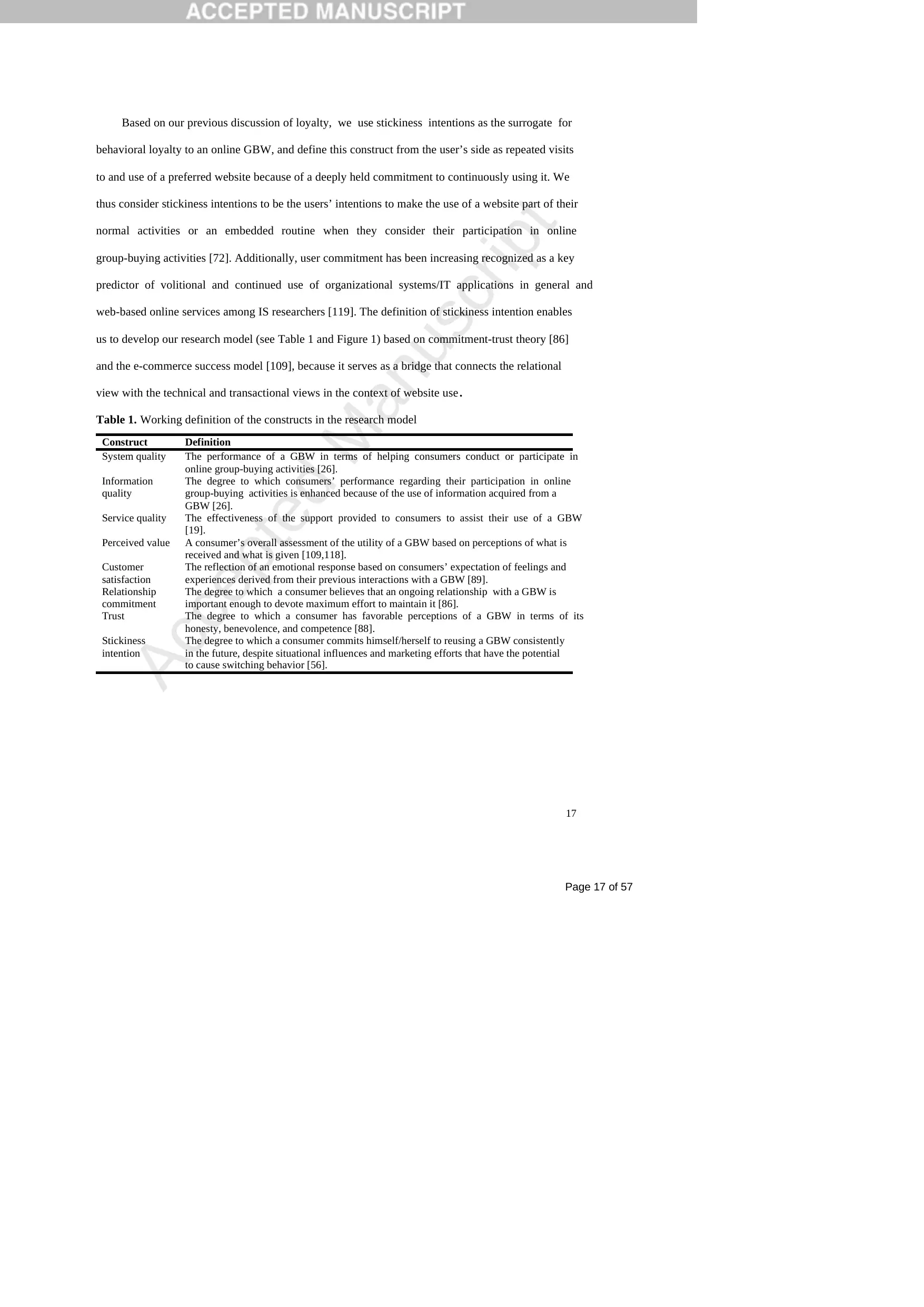
Page 17 of 57
Accepted Manuscript
17
Based on our previous discussion of loyalty, we use stickiness intentions as the surrogate for
behavioral loyalty to an online GBW, and define this construct from the user’s side as repeated visits
to and use of a preferred website because of a deeply held commitment to continuously using it. We
thus consider stickiness intentions to be the users’ intentions to make the use of a website part of their
normal activities or an embedded routine when they consider their participation in online
group-buying activities [72]. Additionally, user commitment has been increasing recognized as a key
predictor of volitional and continued use of organizational systems/IT applications in general and
web-based online services among IS researchers [119]. The definition of stickiness intention enables
us to develop our research model (see Table 1 and Figure 1) based on commitment-trust theory [86]
and the e-commerce success model [109], because it serves as a bridge that connects the relational
view with the technical and transactional views in the context of website use .
Table 1. Working definition of the constructs in the research model
Construct Definition
System quality The performance of a GBW in terms of helping consumers conduct or participate in
online group-buying activities [26].
Information
quality
The degree to which consumers’ performance regarding their participation in online
group-buying activities is enhanced because of the use of information acquired from a
GBW [26].
Service quality The effectiveness of the support provided to consumers to assist their use of a GBW
[19].
Perceived value A consumer’s overall assessment of the utility of a GBW based on perceptions of what is
received and what is given [109,118].
Customer
satisfaction
The reflection of an emotional response based on consumers’ expectation of feelings and
experiences derived from their previous interactions with a GBW [89].
Relationship
commitment
The degree to which a consumer believes that an ongoing relationship with a GBW is
important enough to devote maximum effort to maintain it [86].
Trust The degree to which a consumer has favorable perceptions of a GBW in terms of its
honesty, benevolence, and competence [88].
Stickiness
intention
The degree to which a consumer commits himself/herself to reusing a GBW consistently
in the future, despite situational influences and marketing efforts that have the potential
to cause switching behavior [56].
Accepted Manuscript
17
Based on our previous discussion of loyalty, we use stickiness intentions as the surrogate for
behavioral loyalty to an online GBW, and define this construct from the user’s side as repeated visits
to and use of a preferred website because of a deeply held commitment to continuously using it. We
thus consider stickiness intentions to be the users’ intentions to make the use of a website part of their
normal activities or an embedded routine when they consider their participation in online
group-buying activities [72]. Additionally, user commitment has been increasing recognized as a key
predictor of volitional and continued use of organizational systems/IT applications in general and
web-based online services among IS researchers [119]. The definition of stickiness intention enables
us to develop our research model (see Table 1 and Figure 1) based on commitment-trust theory [86]
and the e-commerce success model [109], because it serves as a bridge that connects the relational
view with the technical and transactional views in the context of website use .
Table 1. Working definition of the constructs in the research model
Construct Definition
System quality The performance of a GBW in terms of helping consumers conduct or participate in
online group-buying activities [26].
Information
quality
The degree to which consumers’ performance regarding their participation in online
group-buying activities is enhanced because of the use of information acquired from a
GBW [26].
Service quality The effectiveness of the support provided to consumers to assist their use of a GBW
[19].
Perceived value A consumer’s overall assessment of the utility of a GBW based on perceptions of what is
received and what is given [109,118].
Customer
satisfaction
The reflection of an emotional response based on consumers’ expectation of feelings and
experiences derived from their previous interactions with a GBW [89].
Relationship
commitment
The degree to which a consumer believes that an ongoing relationship with a GBW is
important enough to devote maximum effort to maintain it [86].
Trust The degree to which a consumer has favorable perceptions of a GBW in terms of its
honesty, benevolence, and competence [88].
Stickiness
intention
The degree to which a consumer commits himself/herself to reusing a GBW consistently
in the future, despite situational influences and marketing efforts that have the potential
to cause switching behavior [56].
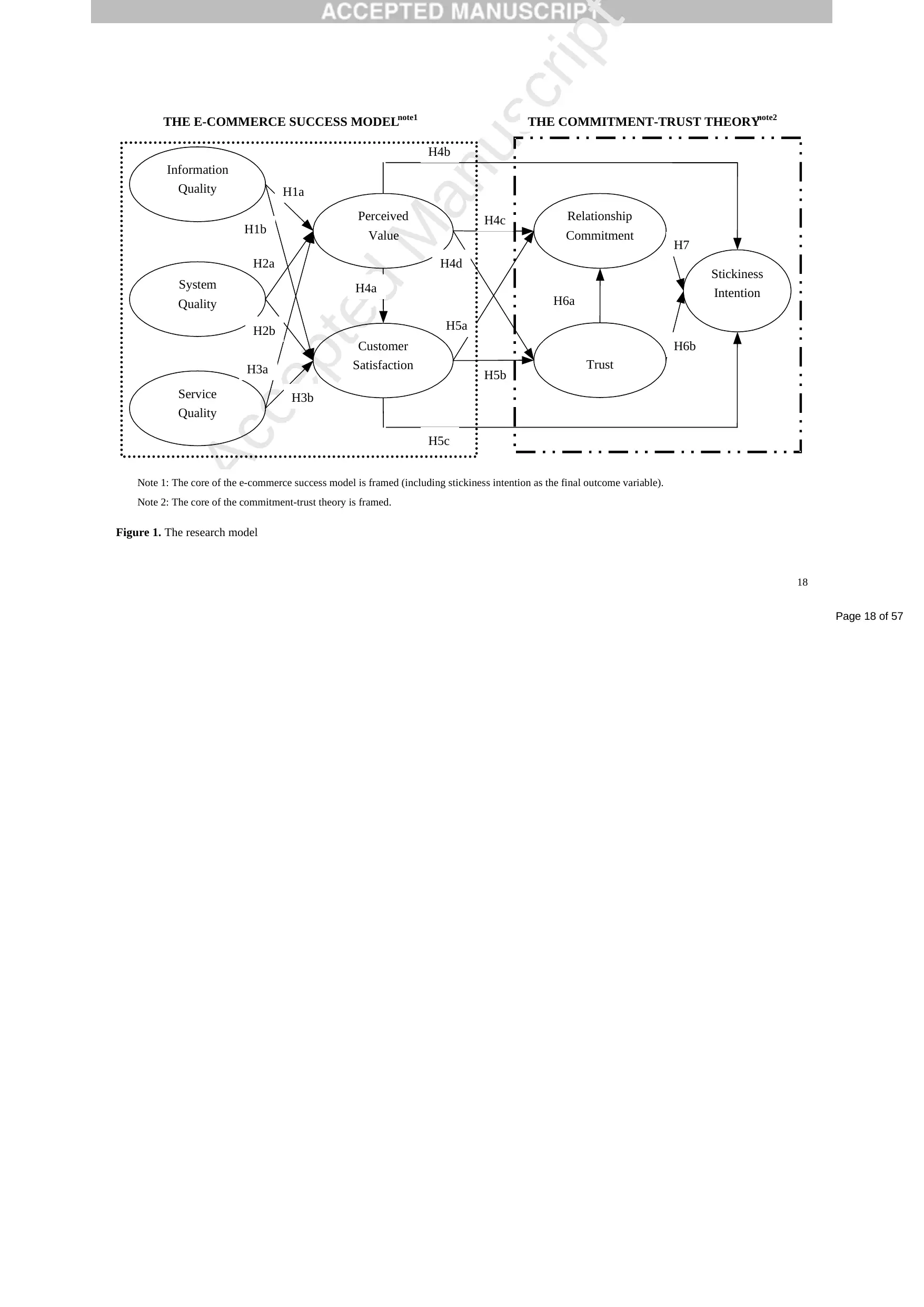
Page 18 of 57
Accepted Manuscript
18
Figure 1. The research model
H2a
Information
Quality
System
Quality
Service
Quality
Perceived
Value
Customer
Satisfaction Trust
Relationship
Commitment
Stickiness
Intention
H3a
H1a
H1b
H2b
H3b
H4a
H4c
H4d
H4b
H5a
H5b
H5c
H6a
H6b
H7
THE COMMITMENT-TRUST THEORYnote2
Note 1: The core of the e-commerce success model is framed (including stickiness intention as the final outcome variable).
Note 2: The core of the commitment-trust theory is framed.
THE E-COMMERCE SUCCESS MODELnote1
Accepted Manuscript
18
Figure 1. The research model
H2a
Information
Quality
System
Quality
Service
Quality
Perceived
Value
Customer
Satisfaction Trust
Relationship
Commitment
Stickiness
Intention
H3a
H1a
H1b
H2b
H3b
H4a
H4c
H4d
H4b
H5a
H5b
H5c
H6a
H6b
H7
THE COMMITMENT-TRUST THEORYnote2
Note 1: The core of the e-commerce success model is framed (including stickiness intention as the final outcome variable).
Note 2: The core of the commitment-trust theory is framed.
THE E-COMMERCE SUCCESS MODELnote1
Paraphrase This Document
Need a fresh take? Get an instant paraphrase of this document with our AI Paraphraser

Page 19 of 57
Accepted Manuscript
19
The development of the proposed research model involves three primary tasks. The first is to
replace the consequences of relationship commitment and trust with consumer stickiness intentions
regarding an e-commerce website, as in previous studies [55, 72, 103, 106]. The second task is related
to the positioning of relationship commitment and trust in the e-commerce success model. Beatty and
Kahle [7] argue that commitment may be treated as an emotional or psychological attachment to an
entity that is conceptually similar to, but distinct from, loyalty, because it has attitudinal implications
with no direct measures of behaviors. Prior marketing studies also indicate that commitment, as an
attitude toward a specific entity, is a direct antecedent to loyalty and a key element for distinguishing
between lasting and transitory loyalty [51, 103]. Consistent with this perspective, commitment-trust
theory views both relationship commitment and trust as having attitudinal meanings and directly
influencing intentional/behavioral factors, such as acquiescence and propensity to leave. In the area of
social psychology, continuing commitment to a relationship requires, more or less, a leap of faith (i.e.,
trust) [98]. Trust can be considered an attitude that is formed by multiple components that reflect
levels of attributional abstraction [98], and refers to a party’s willingness to be vulnerable to another
party [83]. In the context of e-commerce, trust, as an attitude, is best viewed as an aggregation of
beliefs that encompasses both cognitive and affective components [10, 34, 72]. In summary, to
comply with the appraisal emotional response coping framework [6, 70] in the e-commerce
success model, the constructs of relationship commitment and trust are considered to be
representations of attitudes, as suggested in previous studies [7, 55, 72, 103, 106, 107], that mediate
the effects of perceived value and satisfaction on consumers’ stickiness intentions. The last task is
related to the transition of the original antecedents of relationship commitment and trust in
commitment-trust theory to the belief/quality measures (i.e., system quality, information quality,
service quality, and perceived value) and the attitude measure (i.e., customer satisfaction) for the
e-commerce success model based on the appraisal emotional response coping framework [6, 70].
Accepted Manuscript
19
The development of the proposed research model involves three primary tasks. The first is to
replace the consequences of relationship commitment and trust with consumer stickiness intentions
regarding an e-commerce website, as in previous studies [55, 72, 103, 106]. The second task is related
to the positioning of relationship commitment and trust in the e-commerce success model. Beatty and
Kahle [7] argue that commitment may be treated as an emotional or psychological attachment to an
entity that is conceptually similar to, but distinct from, loyalty, because it has attitudinal implications
with no direct measures of behaviors. Prior marketing studies also indicate that commitment, as an
attitude toward a specific entity, is a direct antecedent to loyalty and a key element for distinguishing
between lasting and transitory loyalty [51, 103]. Consistent with this perspective, commitment-trust
theory views both relationship commitment and trust as having attitudinal meanings and directly
influencing intentional/behavioral factors, such as acquiescence and propensity to leave. In the area of
social psychology, continuing commitment to a relationship requires, more or less, a leap of faith (i.e.,
trust) [98]. Trust can be considered an attitude that is formed by multiple components that reflect
levels of attributional abstraction [98], and refers to a party’s willingness to be vulnerable to another
party [83]. In the context of e-commerce, trust, as an attitude, is best viewed as an aggregation of
beliefs that encompasses both cognitive and affective components [10, 34, 72]. In summary, to
comply with the appraisal emotional response coping framework [6, 70] in the e-commerce
success model, the constructs of relationship commitment and trust are considered to be
representations of attitudes, as suggested in previous studies [7, 55, 72, 103, 106, 107], that mediate
the effects of perceived value and satisfaction on consumers’ stickiness intentions. The last task is
related to the transition of the original antecedents of relationship commitment and trust in
commitment-trust theory to the belief/quality measures (i.e., system quality, information quality,
service quality, and perceived value) and the attitude measure (i.e., customer satisfaction) for the
e-commerce success model based on the appraisal emotional response coping framework [6, 70].

Page 20 of 57
Accepted Manuscript
20
3.2 IS quality factors
Jahng et al. [52] address the importance of the fit of system-quality characteristics,
information-quality characteristics, and service-quality characteristics with perceived value and
customer satisfaction. This fit may positively affect e-commerce consumers’ intentions to conduct
transactions via e-commerce websites. The well-known quality-value-loyalty chain in traditional
marketing specifies that consumer perceived quality, as a multi-dimensional concept, reflects
consumers’ assessment of the overall performance of sellers and thus serves as a key driver of
consumers’ perceived value [23, 41, 91, 118]. A number of e-commerce studies indicate that
system-related, information-related, and service-related qualities may positively influence
individuals’ perceived value of the use of information technologies [16, 20, 47, 109]. For example,
Wang [109] indicates that perceived value is the e-commerce consumers’ assessment of the ratio of
perceived quality and perceived sacrifice, and is thus positively influenced by information quality,
system quality, and service quality based on which consumers form their overall evaluation regarding
the costs and benefits of e-commerce system usage. Yoon and Kim [117] argue that the quality of the
attributes of online stores, including reliability (i.e., system quality), system output (i.e., information
quality), and responsiveness (i.e., service quality), have a positive influence on users’ perceptions of
the value of using the services that these stores offer. Wang et al. [110] argue that consumers’ value
perceptions are motivated by the utilitarian benefits of using online services. Thus, the development
of new functionality for e-commerce systems that enhance information quality, system quality, and
service quality should promote consumers’ perceived value. Thus, we hypothesized the following:
H1a. Information quality positively influences consumers’ perceived value regarding a GBW.
H2a. System quality positively influences consumers’ perceived value regarding a GBW.
H3a. Service quality positively influences consumers’ perceived value regarding a GBW.
Research indicates that information quality, system quality, and service quality (as IS
effectiveness measures) can positively affect user satisfaction (as a perceptual measure of users’
opinions of the IS) [27, 66]. Additionally, prior studies indicate that individuals perceive their use of
Accepted Manuscript
20
3.2 IS quality factors
Jahng et al. [52] address the importance of the fit of system-quality characteristics,
information-quality characteristics, and service-quality characteristics with perceived value and
customer satisfaction. This fit may positively affect e-commerce consumers’ intentions to conduct
transactions via e-commerce websites. The well-known quality-value-loyalty chain in traditional
marketing specifies that consumer perceived quality, as a multi-dimensional concept, reflects
consumers’ assessment of the overall performance of sellers and thus serves as a key driver of
consumers’ perceived value [23, 41, 91, 118]. A number of e-commerce studies indicate that
system-related, information-related, and service-related qualities may positively influence
individuals’ perceived value of the use of information technologies [16, 20, 47, 109]. For example,
Wang [109] indicates that perceived value is the e-commerce consumers’ assessment of the ratio of
perceived quality and perceived sacrifice, and is thus positively influenced by information quality,
system quality, and service quality based on which consumers form their overall evaluation regarding
the costs and benefits of e-commerce system usage. Yoon and Kim [117] argue that the quality of the
attributes of online stores, including reliability (i.e., system quality), system output (i.e., information
quality), and responsiveness (i.e., service quality), have a positive influence on users’ perceptions of
the value of using the services that these stores offer. Wang et al. [110] argue that consumers’ value
perceptions are motivated by the utilitarian benefits of using online services. Thus, the development
of new functionality for e-commerce systems that enhance information quality, system quality, and
service quality should promote consumers’ perceived value. Thus, we hypothesized the following:
H1a. Information quality positively influences consumers’ perceived value regarding a GBW.
H2a. System quality positively influences consumers’ perceived value regarding a GBW.
H3a. Service quality positively influences consumers’ perceived value regarding a GBW.
Research indicates that information quality, system quality, and service quality (as IS
effectiveness measures) can positively affect user satisfaction (as a perceptual measure of users’
opinions of the IS) [27, 66]. Additionally, prior studies indicate that individuals perceive their use of

Page 21 of 57
Accepted Manuscript
21
an e-commerce system as being satisfactory if the system provides them with quality information [71,
75, 94, 105]. Flavian et al. [33] find that e-commerce websites’ provision of useful, timely, and easily
understood information to their users is positively associated with customer satisfaction. Lin [76]
argues that information quality refers to the semantic success of e-commerce systems; thus, high
information quality is associated with high user satisfaction.
Good system quality indicates the technical success of an e-commerce system and thus may lead
to the development of favorable user satisfaction with the system’s timeliness, reliability, and
availability [71, 75, 94]. If an e-commerce website can help consumers to navigate the site or conduct
online transactions effectively, consumers will consider their use of the websites to be satisfactory [16,
33]. Lin [76] argues that system quality measures the technical success of e-commerce systems, and
thus has a positive influence on satisfaction. Ulbrich et al. [105] note that system quality measures
multiple system features, including usefulness, reliability, and flexibility, and if one of these features
is not performing to the user’s satisfaction, the user may cease to use the system.
E-commerce systems have always functioned as both information and service providers. Thus,
user-perceived performance levels for system-related services tend to have a positive effect on
satisfaction [71, 75, 94]. Consumers are dissatisfied if an e-commerce website fails to provide them
with quality services that can assist them to achieve their specific goals via the Internet, such as
gathering information or conducting online transactions [79]. Choi et al. [19] find that the
effectiveness of the assistance provided by an e-commerce website regarding questions, issues, or
problems with its use or with transactions is positively associated with customer satisfaction. Thus,
we hypothesized the following:
H1b. Information quality positively influences customer satisfaction with a GBW.
H2b. System quality positively influences customer satisfaction with a GBW.
H3b. Service quality positively influences customer satisfaction with a GBW.
Accepted Manuscript
21
an e-commerce system as being satisfactory if the system provides them with quality information [71,
75, 94, 105]. Flavian et al. [33] find that e-commerce websites’ provision of useful, timely, and easily
understood information to their users is positively associated with customer satisfaction. Lin [76]
argues that information quality refers to the semantic success of e-commerce systems; thus, high
information quality is associated with high user satisfaction.
Good system quality indicates the technical success of an e-commerce system and thus may lead
to the development of favorable user satisfaction with the system’s timeliness, reliability, and
availability [71, 75, 94]. If an e-commerce website can help consumers to navigate the site or conduct
online transactions effectively, consumers will consider their use of the websites to be satisfactory [16,
33]. Lin [76] argues that system quality measures the technical success of e-commerce systems, and
thus has a positive influence on satisfaction. Ulbrich et al. [105] note that system quality measures
multiple system features, including usefulness, reliability, and flexibility, and if one of these features
is not performing to the user’s satisfaction, the user may cease to use the system.
E-commerce systems have always functioned as both information and service providers. Thus,
user-perceived performance levels for system-related services tend to have a positive effect on
satisfaction [71, 75, 94]. Consumers are dissatisfied if an e-commerce website fails to provide them
with quality services that can assist them to achieve their specific goals via the Internet, such as
gathering information or conducting online transactions [79]. Choi et al. [19] find that the
effectiveness of the assistance provided by an e-commerce website regarding questions, issues, or
problems with its use or with transactions is positively associated with customer satisfaction. Thus,
we hypothesized the following:
H1b. Information quality positively influences customer satisfaction with a GBW.
H2b. System quality positively influences customer satisfaction with a GBW.
H3b. Service quality positively influences customer satisfaction with a GBW.
Secure Best Marks with AI Grader
Need help grading? Try our AI Grader for instant feedback on your assignments.

Page 22 of 57
Accepted Manuscript
22
3.3 Perceived value and customer satisfaction
Consumer perceived value refers to the consumer’s assessment of the ratio of perceived quality
and perceived sacrifice with regard to a product/service, and is thus important for enhancing customer
satisfaction and facilitating repatronage [118]. The multi-directional relationships between perceived
value, customer satisfaction, and intentions to purchase/repurchase/reuse are well-documented in
traditional marketing studies [23, 91, 92]. Hellier et al. [41] argue that perceived value reflects
consumers’ appraisal of the net worth of a product/service, and thus positively affects customer
satisfaction and repurchase intentions. Additionally, along with the degree of customer satisfaction
resulting from customer perceptions of the value received, perceived value has a positive influence on
customers’ continuance intentions [77]. Lam et al. [67] also find that perceived value is an
important antecedent of satisfaction, because it takes into consideration the balance of
perceived benefits and sacrifices from which customer satisfaction derives. Based on the above
discussion, we hypothesized the following:
H4a. Perceived value positively influences customer satisfaction with a GBW.
H4b. Perceived value positively influences consumers’ stickiness intentions regarding a GBW.
Consumer value is a key variable for explaining repeat purchase behavior and relationship
commitment [22, 92]. Woodruff [112] argues that consumers’ perceived value facilitates the
formation of the consumer’s trust in the seller and thereby simplifies the process of making
purchasing decisions. Singh and Sirdeshmukh [102] find that failing to meet the consumer’s
expectation regarding the value received from a purchase may engender the consumer’s distrust in the
seller. Grabner-Kraeuter [38] argues that consumers’ perceived value serves as an important
mechanism for maintaining consumers’ trust in online sellers. Garbarino and Johnson [34] argue that
perceived value, trust, and commitment are among the key constructs for understanding consumers’
purchasing decisions. These authors suggest that the trust between two exchange parties and their
commitment to their exchange relationship are characterized by factors that include the parties’
Accepted Manuscript
22
3.3 Perceived value and customer satisfaction
Consumer perceived value refers to the consumer’s assessment of the ratio of perceived quality
and perceived sacrifice with regard to a product/service, and is thus important for enhancing customer
satisfaction and facilitating repatronage [118]. The multi-directional relationships between perceived
value, customer satisfaction, and intentions to purchase/repurchase/reuse are well-documented in
traditional marketing studies [23, 91, 92]. Hellier et al. [41] argue that perceived value reflects
consumers’ appraisal of the net worth of a product/service, and thus positively affects customer
satisfaction and repurchase intentions. Additionally, along with the degree of customer satisfaction
resulting from customer perceptions of the value received, perceived value has a positive influence on
customers’ continuance intentions [77]. Lam et al. [67] also find that perceived value is an
important antecedent of satisfaction, because it takes into consideration the balance of
perceived benefits and sacrifices from which customer satisfaction derives. Based on the above
discussion, we hypothesized the following:
H4a. Perceived value positively influences customer satisfaction with a GBW.
H4b. Perceived value positively influences consumers’ stickiness intentions regarding a GBW.
Consumer value is a key variable for explaining repeat purchase behavior and relationship
commitment [22, 92]. Woodruff [112] argues that consumers’ perceived value facilitates the
formation of the consumer’s trust in the seller and thereby simplifies the process of making
purchasing decisions. Singh and Sirdeshmukh [102] find that failing to meet the consumer’s
expectation regarding the value received from a purchase may engender the consumer’s distrust in the
seller. Grabner-Kraeuter [38] argues that consumers’ perceived value serves as an important
mechanism for maintaining consumers’ trust in online sellers. Garbarino and Johnson [34] argue that
perceived value, trust, and commitment are among the key constructs for understanding consumers’
purchasing decisions. These authors suggest that the trust between two exchange parties and their
commitment to their exchange relationship are characterized by factors that include the parties’

Page 23 of 57
Accepted Manuscript
23
perceptions of the value associated with this relationship. Thus, we hypothesized the following:
H4c. Perceived value positively influences consumers’ relationship commitment to a GBW.
H4d. Perceived value positively influences consumers’ trust in a GBW.
The investment model developed in marketing indicates that satisfaction can positively
influence individuals’ commitment to a relationship by increasing the attraction of and psychological
attachment to the relationship [46]. Henning-Thurau et al. [42] propose that a high level of customer
satisfaction can facilitate the development of commitment-inducing emotional bonds with sellers,
which may contribute to customer loyalty. Thatcher and George [103] validate the chain of
relationships between satisfaction, commitment, and customer loyalty in the context of e-commerce.
The trust development process in e-commerce contexts has been closely associated with
consumer satisfaction [93]. Lee et al. [71] argue that a high degree of satisfaction contributes to the
development of a high level of trust in the provider. Flavian et al. [33] conclude that the degree of
trust is a consequence of the capacity of a business/website to satisfy the needs of its clients. Finally,
Garbarino and Johnson [34] find that overall consumer satisfaction has a positive influence on both
trust and commitment. Thus, we hypothesized the following:
H5a. Customer satisfaction positively influences consumers’ relationship commitment to a GBW.
H5b. Customer satisfaction positively influences consumers’ trust in a GBW.
Satisfaction is a reliable predictor of repurchase intentions [23, 91, 92]. Perceived value reflects
consumers’ evaluation of the worthiness of making a transaction regarding a product/service, and thus
positively affects repurchase intentions directly or indirectly via customer satisfaction [41]. This
value-satisfaction-intention paradigm has been empirically validated by e-commerce researchers [4,
20, 77, 109], and implies the direct positive effect of customer satisfaction regarding a GBW on the
online customers’ intention to stick with the GBW. Additionally, customer satisfaction can strengthen
the relationship between customers and GBWs, and is thus very important for enhancing customer
intentions to stick with the GBWs to carry out purchases [100]. Consequently, we hypothesized the
following:
Accepted Manuscript
23
perceptions of the value associated with this relationship. Thus, we hypothesized the following:
H4c. Perceived value positively influences consumers’ relationship commitment to a GBW.
H4d. Perceived value positively influences consumers’ trust in a GBW.
The investment model developed in marketing indicates that satisfaction can positively
influence individuals’ commitment to a relationship by increasing the attraction of and psychological
attachment to the relationship [46]. Henning-Thurau et al. [42] propose that a high level of customer
satisfaction can facilitate the development of commitment-inducing emotional bonds with sellers,
which may contribute to customer loyalty. Thatcher and George [103] validate the chain of
relationships between satisfaction, commitment, and customer loyalty in the context of e-commerce.
The trust development process in e-commerce contexts has been closely associated with
consumer satisfaction [93]. Lee et al. [71] argue that a high degree of satisfaction contributes to the
development of a high level of trust in the provider. Flavian et al. [33] conclude that the degree of
trust is a consequence of the capacity of a business/website to satisfy the needs of its clients. Finally,
Garbarino and Johnson [34] find that overall consumer satisfaction has a positive influence on both
trust and commitment. Thus, we hypothesized the following:
H5a. Customer satisfaction positively influences consumers’ relationship commitment to a GBW.
H5b. Customer satisfaction positively influences consumers’ trust in a GBW.
Satisfaction is a reliable predictor of repurchase intentions [23, 91, 92]. Perceived value reflects
consumers’ evaluation of the worthiness of making a transaction regarding a product/service, and thus
positively affects repurchase intentions directly or indirectly via customer satisfaction [41]. This
value-satisfaction-intention paradigm has been empirically validated by e-commerce researchers [4,
20, 77, 109], and implies the direct positive effect of customer satisfaction regarding a GBW on the
online customers’ intention to stick with the GBW. Additionally, customer satisfaction can strengthen
the relationship between customers and GBWs, and is thus very important for enhancing customer
intentions to stick with the GBWs to carry out purchases [100]. Consequently, we hypothesized the
following:

Page 24 of 57
Accepted Manuscript
24
H5c. Customer satisfaction positively influences consumers’ stickiness intentions regarding a GBW.
3.4 Relationship commitment, trust, and stickiness intention
The positive influence of trust on relationship commitment and directly or indirectly on the
outcome variables via the mediation of relationship commitment is the central premise of
commitment-trust theory [86]. This positive influence has been empirically validated in previous
studies [72, 87, 102, 106]. For example, Henning-Thurau and Klee [43] argue that trust promotes
relationship commitment because it improves relationship efficiency and addresses the central social
needs of consumers when building relationships with others. Jang et al. [53] argue that if online users’
experiences interacting with others in an online community lead them to define those others as being
trustworthy, they will develop strong commitments to the community.
Trust is considered essential to various types of behaviors involving social interactions [65],
such as consumers’ behavioral intentions regarding online vendors/websites [1, 56, 66, 71, 80, 117]. A
number of e-commerce studies find that trust has a positive influence on the behavioral intentions of
online consumers with regard to a website/online seller via the mediation of relationship commitment
[72, 87, 106]. Trust is a mechanism for assessing the extent to which individuals expect positive
outcomes from a specific action or decision [88], and thus consumers’ trust in the initiators and
GBWs of group-buying activities can motivate consumers to participate in online group-buying
activities [24, 48, 58, 66, 78]. Based on the discussion above, we hypothesized the following:
H6a. Trust positively influences consumers’ relationship commitment to a GBW.
H6b. Trust positively influences consumers’ stickiness intentions regarding a GBW.
Relationship commitment is a critical factor that distinguishes lasting loyalty from temporary
loyalty [103]. A relationship commitment between two exchange parties implies a shared assumption
that the relationship is valuable and worth maintaining by avoiding opportunistic behaviors by both
parties, and may thus lead to continued exchange behaviors in the future [106]. Liet al. [72] also
argue that highly committed consumers are more psychologically attached to a particular website
Accepted Manuscript
24
H5c. Customer satisfaction positively influences consumers’ stickiness intentions regarding a GBW.
3.4 Relationship commitment, trust, and stickiness intention
The positive influence of trust on relationship commitment and directly or indirectly on the
outcome variables via the mediation of relationship commitment is the central premise of
commitment-trust theory [86]. This positive influence has been empirically validated in previous
studies [72, 87, 102, 106]. For example, Henning-Thurau and Klee [43] argue that trust promotes
relationship commitment because it improves relationship efficiency and addresses the central social
needs of consumers when building relationships with others. Jang et al. [53] argue that if online users’
experiences interacting with others in an online community lead them to define those others as being
trustworthy, they will develop strong commitments to the community.
Trust is considered essential to various types of behaviors involving social interactions [65],
such as consumers’ behavioral intentions regarding online vendors/websites [1, 56, 66, 71, 80, 117]. A
number of e-commerce studies find that trust has a positive influence on the behavioral intentions of
online consumers with regard to a website/online seller via the mediation of relationship commitment
[72, 87, 106]. Trust is a mechanism for assessing the extent to which individuals expect positive
outcomes from a specific action or decision [88], and thus consumers’ trust in the initiators and
GBWs of group-buying activities can motivate consumers to participate in online group-buying
activities [24, 48, 58, 66, 78]. Based on the discussion above, we hypothesized the following:
H6a. Trust positively influences consumers’ relationship commitment to a GBW.
H6b. Trust positively influences consumers’ stickiness intentions regarding a GBW.
Relationship commitment is a critical factor that distinguishes lasting loyalty from temporary
loyalty [103]. A relationship commitment between two exchange parties implies a shared assumption
that the relationship is valuable and worth maintaining by avoiding opportunistic behaviors by both
parties, and may thus lead to continued exchange behaviors in the future [106]. Liet al. [72] also
argue that highly committed consumers are more psychologically attached to a particular website
Paraphrase This Document
Need a fresh take? Get an instant paraphrase of this document with our AI Paraphraser

Page 25 of 57
Accepted Manuscript
25
because of the mutual benefits of maintaining this relationship, and thus they are more likely to
continue to use the website. Thus, we hypothesized the following:
H7. Relationship commitment positively influences consumers’ stickiness intentions regarding a
GBW.
4. Research Method
4.1 Development of instruments
We adapted 43 items relevant to the eight constructs of the research model from the literature
and refined them based on the specific topic of this study. We measured all of the constructs of
interest as first-order reflective constructs except for trust. As discussed previously, the construct of
trust, as an attitude, is modeled as a second-order formative construct that is measured by three
first-order reflective sub-constructs of integrity, ability, and benevolence in this study.
All of the survey items were pilot-tested using samples collected from 32 participants in online
group-buying activities. We considered the 36 items included in the final questionnaire to be highly
reliable because the individual Cronbach’s alpha coefficients of all ten first-order constructs reached
the recommended level of 0.7 (ranging from 0.77 to 0.96) [61]. These items were measured using a
seven-point Likert scale ranging from (1) strongly disagree to (7) strongly agree (see Appendix B).
4.2 Data collection
We collected the data for this study using a survey questionnaire. We randomly selected a
number of web forums for group-buying on the two most popular group-buying forum hosting
systems in Taiwan, the PTT Bulletin Board System (www.ptt.cc) and ihergo (www.ihergo.com.tw), as
the survey distribution channels. We sent invitation letters to the forum administrators, asking their
permission to post information about the online survey in their forums. With the permission of the
administrators of 13 web forums, the URL for the online questionnaire was posted on the discussion
Accepted Manuscript
25
because of the mutual benefits of maintaining this relationship, and thus they are more likely to
continue to use the website. Thus, we hypothesized the following:
H7. Relationship commitment positively influences consumers’ stickiness intentions regarding a
GBW.
4. Research Method
4.1 Development of instruments
We adapted 43 items relevant to the eight constructs of the research model from the literature
and refined them based on the specific topic of this study. We measured all of the constructs of
interest as first-order reflective constructs except for trust. As discussed previously, the construct of
trust, as an attitude, is modeled as a second-order formative construct that is measured by three
first-order reflective sub-constructs of integrity, ability, and benevolence in this study.
All of the survey items were pilot-tested using samples collected from 32 participants in online
group-buying activities. We considered the 36 items included in the final questionnaire to be highly
reliable because the individual Cronbach’s alpha coefficients of all ten first-order constructs reached
the recommended level of 0.7 (ranging from 0.77 to 0.96) [61]. These items were measured using a
seven-point Likert scale ranging from (1) strongly disagree to (7) strongly agree (see Appendix B).
4.2 Data collection
We collected the data for this study using a survey questionnaire. We randomly selected a
number of web forums for group-buying on the two most popular group-buying forum hosting
systems in Taiwan, the PTT Bulletin Board System (www.ptt.cc) and ihergo (www.ihergo.com.tw), as
the survey distribution channels. We sent invitation letters to the forum administrators, asking their
permission to post information about the online survey in their forums. With the permission of the
administrators of 13 web forums, the URL for the online questionnaire was posted on the discussion

Page 26 of 57
Accepted Manuscript
26
boards to invite potential respondents to participate in the survey. The respondents were users of
GBWs who had experience in purchasing goods via GBWs within the previous year. The IP and
email addresses of the respondents were recorded and screened to rule out repeated responses. Among
the 305 responses that were received, 25 problematic responses were later removed due to repeat
responses or the respondents’ failure to pass an examination of the reverse questions that were
included in the survey. A total of 280 valid responses were finally received.
We assessed potential non-response bias by comparing the early respondents with later ones
based on demographic variables, including gender, age, level of education, and monthly income using
independent sample t tests. The results indicated no statistically significant differences between these
two data sets (with 149 and 131 respondents, respectively) in terms of gender ( p = 0.36), age (p =
0.41), or level of education (p = 0.15). The constructs of interest for early and late respondents were
also compared using an independent samples t test. The results indicated that there were no
statistically significant differences between these two data sets in terms of system quality ( p = 0.24),
information quality (p = 0.43), service quality (p = 0.09), perceived value (p = 0.47), customer
satisfaction (p = 0.35), relationship commitment (p = 0.93), trust (p = 0.30), or stickiness intention (p
= 0.36). Thus, non-response bias was not a serious concern.
Additionally, we assessed the overall homogeneity of the sample by comparing respondents
from the two different hosting systems mentioned previously based on demographic variables and the
constructs of interest using an independent sample t test [40]. The results indicated that there were no
statistically significant differences between these two data sets in terms of demographic variables,
including gender (p = 0.51), age (p = 0.78), or level of education (p = 0.58), or in the constructs of
interest, including system quality (p = 0.27), information quality (p = 0.44), service quality (p = 0.09),
perceived value (p = 0.94), customer satisfaction (p = 0.12), relationship commitment (p = 0.66), trust
(p = 0.34), or stickiness intention (p = 0.48). These results indicated that the 280 valid survey
responses could be used as a single data set in the subsequent analysis.
The demographic profile of the sample population indicated that 76.1% of the respondents were
Accepted Manuscript
26
boards to invite potential respondents to participate in the survey. The respondents were users of
GBWs who had experience in purchasing goods via GBWs within the previous year. The IP and
email addresses of the respondents were recorded and screened to rule out repeated responses. Among
the 305 responses that were received, 25 problematic responses were later removed due to repeat
responses or the respondents’ failure to pass an examination of the reverse questions that were
included in the survey. A total of 280 valid responses were finally received.
We assessed potential non-response bias by comparing the early respondents with later ones
based on demographic variables, including gender, age, level of education, and monthly income using
independent sample t tests. The results indicated no statistically significant differences between these
two data sets (with 149 and 131 respondents, respectively) in terms of gender ( p = 0.36), age (p =
0.41), or level of education (p = 0.15). The constructs of interest for early and late respondents were
also compared using an independent samples t test. The results indicated that there were no
statistically significant differences between these two data sets in terms of system quality ( p = 0.24),
information quality (p = 0.43), service quality (p = 0.09), perceived value (p = 0.47), customer
satisfaction (p = 0.35), relationship commitment (p = 0.93), trust (p = 0.30), or stickiness intention (p
= 0.36). Thus, non-response bias was not a serious concern.
Additionally, we assessed the overall homogeneity of the sample by comparing respondents
from the two different hosting systems mentioned previously based on demographic variables and the
constructs of interest using an independent sample t test [40]. The results indicated that there were no
statistically significant differences between these two data sets in terms of demographic variables,
including gender (p = 0.51), age (p = 0.78), or level of education (p = 0.58), or in the constructs of
interest, including system quality (p = 0.27), information quality (p = 0.44), service quality (p = 0.09),
perceived value (p = 0.94), customer satisfaction (p = 0.12), relationship commitment (p = 0.66), trust
(p = 0.34), or stickiness intention (p = 0.48). These results indicated that the 280 valid survey
responses could be used as a single data set in the subsequent analysis.
The demographic profile of the sample population indicated that 76.1% of the respondents were

Page 27 of 57
Accepted Manuscript
27
females and that the majority were between 21 and 35 years old (87.1%) and had a college-level
education or above (93.6%). These findings are consistent with the available statistics for the online
group-buying market in Taiwan, which indicate that approximately 70% of the participants of online
group-buying activities in Taiwan are females who are between 26 and 35 years old and have a desk
jobs (e.g., secretaries, administrative staff, etc.) or are housewives [5]. The data also indicated that the
majority of the respondents frequently make purchases via GBWs (approximately six transactions per
respondent per year), with the average amount each respondent spent on group-buying activities listed
at 21 US dollars per month. Approximately one-fourth of the respondents had experience being the
voluntary originator/coordinator of a group-buying campaign conducted via GBWs. A majority of the
respondents were users of the two most popular platforms for group-buying services in Taiwan:
ihergo (www.ihergo.com) and BuyTogether (www.facebook.com/BuyTogether). Overall, the
collected sample closely resembled the population of users for GBWs in Taiwan [74].
4.3 Data analysis method
We adopted component-based structural equation modeling (SEM), namely partial least squares
(PLS), for data analysis for constructing the second-order formative construct, trust, in our research
model. Researchers have frequently demonstrated that covariance-based SEM may suffer from the
identification problems associated with formative constructs. Although methods have been developed
to enable researchers to avoid the identification problems associated with the evaluation of formative
constructs when using the covariance-based SEM, these methods are difficult to use in various
situations, including those in which a formative construct is measured purely by formative indicators,
has a single subsequent variable, or is the ultimate dependent variable in the research model analyzed
[54, 81, 97]. The use of PLS can prevent the problem of identification [18].
Accepted Manuscript
27
females and that the majority were between 21 and 35 years old (87.1%) and had a college-level
education or above (93.6%). These findings are consistent with the available statistics for the online
group-buying market in Taiwan, which indicate that approximately 70% of the participants of online
group-buying activities in Taiwan are females who are between 26 and 35 years old and have a desk
jobs (e.g., secretaries, administrative staff, etc.) or are housewives [5]. The data also indicated that the
majority of the respondents frequently make purchases via GBWs (approximately six transactions per
respondent per year), with the average amount each respondent spent on group-buying activities listed
at 21 US dollars per month. Approximately one-fourth of the respondents had experience being the
voluntary originator/coordinator of a group-buying campaign conducted via GBWs. A majority of the
respondents were users of the two most popular platforms for group-buying services in Taiwan:
ihergo (www.ihergo.com) and BuyTogether (www.facebook.com/BuyTogether). Overall, the
collected sample closely resembled the population of users for GBWs in Taiwan [74].
4.3 Data analysis method
We adopted component-based structural equation modeling (SEM), namely partial least squares
(PLS), for data analysis for constructing the second-order formative construct, trust, in our research
model. Researchers have frequently demonstrated that covariance-based SEM may suffer from the
identification problems associated with formative constructs. Although methods have been developed
to enable researchers to avoid the identification problems associated with the evaluation of formative
constructs when using the covariance-based SEM, these methods are difficult to use in various
situations, including those in which a formative construct is measured purely by formative indicators,
has a single subsequent variable, or is the ultimate dependent variable in the research model analyzed
[54, 81, 97]. The use of PLS can prevent the problem of identification [18].
Secure Best Marks with AI Grader
Need help grading? Try our AI Grader for instant feedback on your assignments.

Page 28 of 57
Accepted Manuscript
28
5. Data Analysis and Results
5.1 Measurement model
We first tested the reliability of the measures for each of the ten first-order constructs by
examining the individual Cronbach’s alpha coefficients. All of the Cronbach’s alpha coefficients of
the ten first-order constructs were greater than the recommended level of 0.7 (ranging from 0.78 to
0.96). Then, using the SmartPLS 2.0 software package, we assessed the psychometric properties of
the measurement model in terms of convergent and discriminant validity [32,40]. We used three
primary measures to evaluate the convergent validity of the measurement model[32, 40]: (a) the
factor loadings of the indicators must be statistically significant with values greater than 0.6; (b)
composite reliability (CR), with values greater than 0.6; and (c) average variance extracted (AVE)
estimates, with values greater than 0.5. Based on these three criteria, we determine the measurement
model exhibited adequate convergent validity (see Table 2). We also examined the discriminant
validity of the measurement model. As shown in Table 3, the squared correlations between the factors
were smaller than the corresponding AVE estimates. This result indicates that the constructs were
more strongly related to their respective indicators than to the other constructs in the model [32].
We modeled the construct of trust as a second-order formative construct that was formed as the
weighted sum of its three first-order reflective constructs. Therefore, an examination of the weights in
the principal component analysis is recommended [95]. The results of the analysis showed that the
weights were all significant (see Table 4). Additionally, a variance inflation factor (VIF) test was used
to examine whether the indicators for the construct of trust exhibited significant multicollinearity [40,
95]. As presented in Table 4, the VIFs for the first-order indicators of trust were smaller than the
cutoff value of 3.3 [95]. We thus determined that high multicollinearity was not present. The content
validity of trust was also assessed. As shown in Table 4, the magnitude of the error terms for the three
indicators of the formative construct of trust were small, and all of the indicator coefficients were
significant, indicating that the construct of trust was well described by its first-order indicators [95].
Accepted Manuscript
28
5. Data Analysis and Results
5.1 Measurement model
We first tested the reliability of the measures for each of the ten first-order constructs by
examining the individual Cronbach’s alpha coefficients. All of the Cronbach’s alpha coefficients of
the ten first-order constructs were greater than the recommended level of 0.7 (ranging from 0.78 to
0.96). Then, using the SmartPLS 2.0 software package, we assessed the psychometric properties of
the measurement model in terms of convergent and discriminant validity [32,40]. We used three
primary measures to evaluate the convergent validity of the measurement model[32, 40]: (a) the
factor loadings of the indicators must be statistically significant with values greater than 0.6; (b)
composite reliability (CR), with values greater than 0.6; and (c) average variance extracted (AVE)
estimates, with values greater than 0.5. Based on these three criteria, we determine the measurement
model exhibited adequate convergent validity (see Table 2). We also examined the discriminant
validity of the measurement model. As shown in Table 3, the squared correlations between the factors
were smaller than the corresponding AVE estimates. This result indicates that the constructs were
more strongly related to their respective indicators than to the other constructs in the model [32].
We modeled the construct of trust as a second-order formative construct that was formed as the
weighted sum of its three first-order reflective constructs. Therefore, an examination of the weights in
the principal component analysis is recommended [95]. The results of the analysis showed that the
weights were all significant (see Table 4). Additionally, a variance inflation factor (VIF) test was used
to examine whether the indicators for the construct of trust exhibited significant multicollinearity [40,
95]. As presented in Table 4, the VIFs for the first-order indicators of trust were smaller than the
cutoff value of 3.3 [95]. We thus determined that high multicollinearity was not present. The content
validity of trust was also assessed. As shown in Table 4, the magnitude of the error terms for the three
indicators of the formative construct of trust were small, and all of the indicator coefficients were
significant, indicating that the construct of trust was well described by its first-order indicators [95].
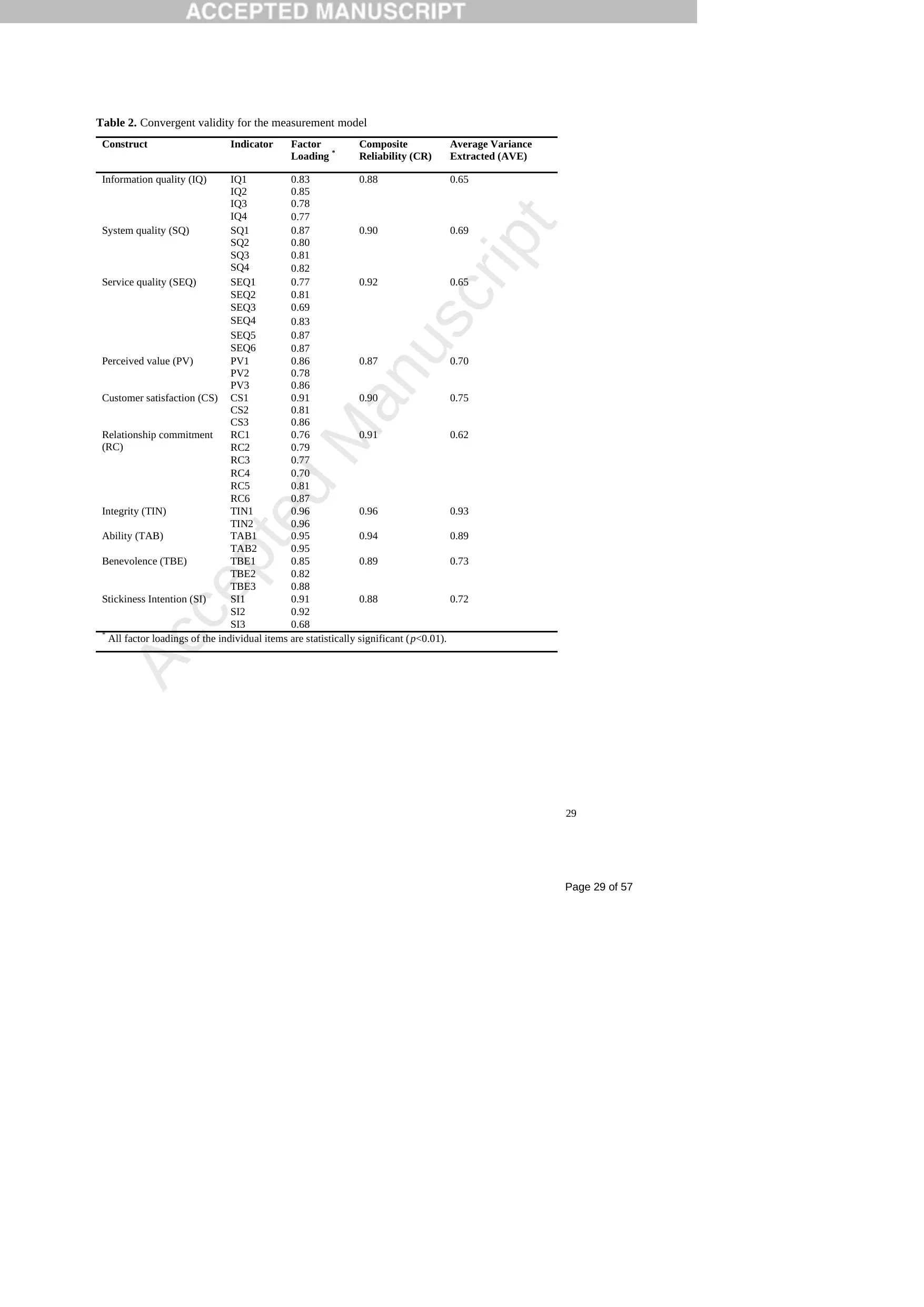
Page 29 of 57
Accepted Manuscript
29
Table 2. Convergent validity for the measurement model
Construct Indicator Factor
Loading *
Composite
Reliability (CR)
Average Variance
Extracted (AVE)
IQ1 0.83
IQ2 0.85
IQ3 0.78
Information quality (IQ)
IQ4 0.77
0.88 0.65
SQ1 0.87
SQ2 0.80
SQ3 0.81
System quality (SQ)
SQ4 0.82
0.90 0.69
SEQ1 0.77
SEQ2 0.81
SEQ3 0.69
SEQ4 0.83
SEQ5 0.87
Service quality (SEQ)
SEQ6 0.87
0.92 0.65
PV1 0.86
PV2 0.78
Perceived value (PV)
PV3 0.86
0.87 0.70
CS1 0.91
CS2 0.81
Customer satisfaction (CS)
CS3 0.86
0.90 0.75
RC1 0.76
RC2 0.79
RC3 0.77
RC4 0.70
RC5 0.81
Relationship commitment
(RC)
RC6 0.87
0.91 0.62
TIN1 0.96Integrity (TIN)
TIN2 0.96
0.96 0.93
TAB1 0.95Ability (TAB)
TAB2 0.95
0.94 0.89
TBE1 0.85
TBE2 0.82
Benevolence (TBE)
TBE3 0.88
0.89 0.73
SI1 0.91
SI2 0.92
Stickiness Intention (SI)
SI3 0.68
0.88 0.72
* All factor loadings of the individual items are statistically significant (p<0.01).
Accepted Manuscript
29
Table 2. Convergent validity for the measurement model
Construct Indicator Factor
Loading *
Composite
Reliability (CR)
Average Variance
Extracted (AVE)
IQ1 0.83
IQ2 0.85
IQ3 0.78
Information quality (IQ)
IQ4 0.77
0.88 0.65
SQ1 0.87
SQ2 0.80
SQ3 0.81
System quality (SQ)
SQ4 0.82
0.90 0.69
SEQ1 0.77
SEQ2 0.81
SEQ3 0.69
SEQ4 0.83
SEQ5 0.87
Service quality (SEQ)
SEQ6 0.87
0.92 0.65
PV1 0.86
PV2 0.78
Perceived value (PV)
PV3 0.86
0.87 0.70
CS1 0.91
CS2 0.81
Customer satisfaction (CS)
CS3 0.86
0.90 0.75
RC1 0.76
RC2 0.79
RC3 0.77
RC4 0.70
RC5 0.81
Relationship commitment
(RC)
RC6 0.87
0.91 0.62
TIN1 0.96Integrity (TIN)
TIN2 0.96
0.96 0.93
TAB1 0.95Ability (TAB)
TAB2 0.95
0.94 0.89
TBE1 0.85
TBE2 0.82
Benevolence (TBE)
TBE3 0.88
0.89 0.73
SI1 0.91
SI2 0.92
Stickiness Intention (SI)
SI3 0.68
0.88 0.72
* All factor loadings of the individual items are statistically significant (p<0.01).
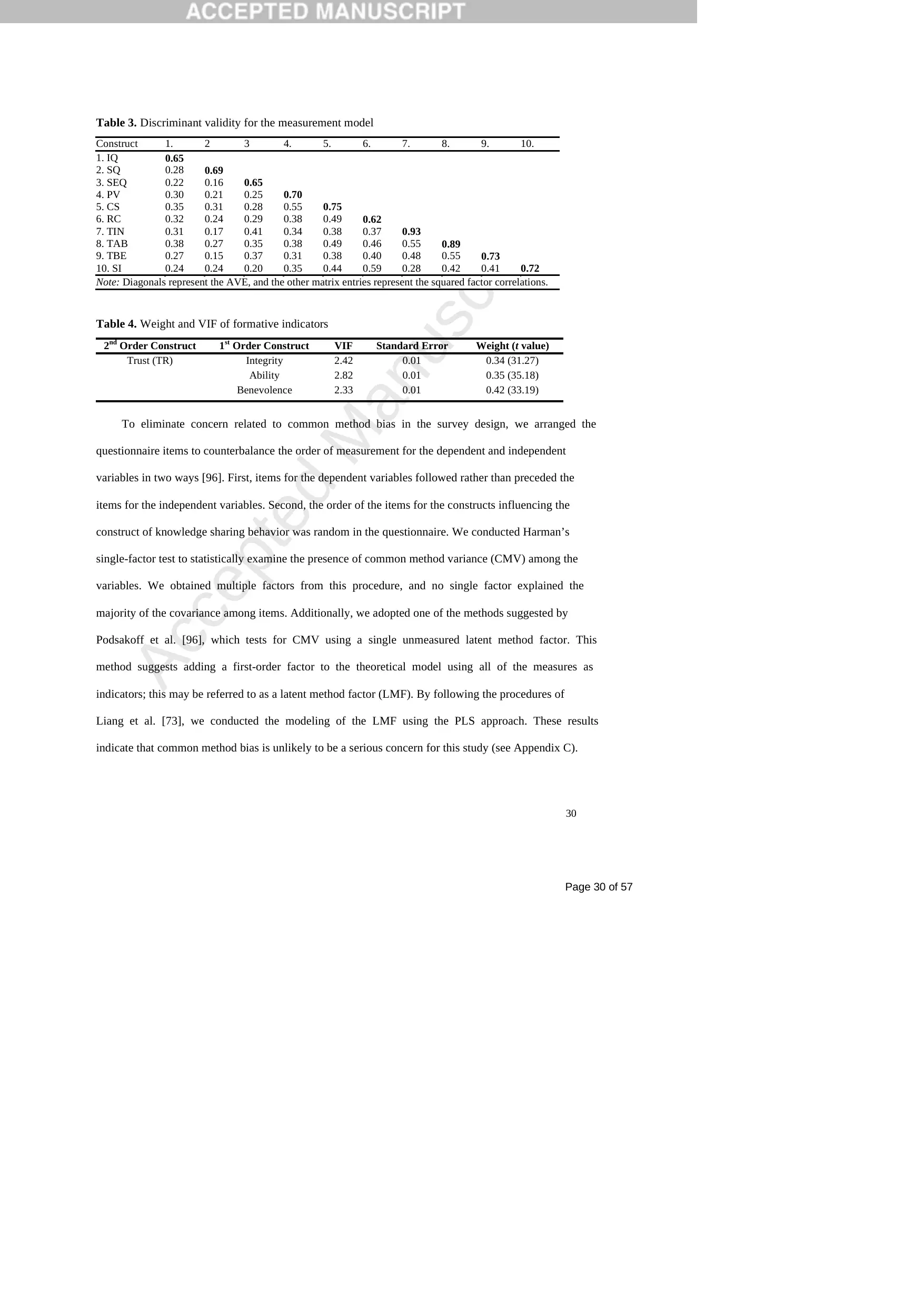
Page 30 of 57
Accepted Manuscript
30
Table 3. Discriminant validity for the measurement model
Construct 1. 2 3 4. 5. 6. 7. 8. 9. 10.
1. IQ 0.65
2. SQ 0.28 0.69
3. SEQ 0.22 0.16 0.65
4. PV 0.30 0.21 0.25 0.70
5. CS 0.35 0.31 0.28 0.55 0.75
6. RC 0.32 0.24 0.29 0.38 0.49 0.62
7. TIN 0.31 0.17 0.41 0.34 0.38 0.37 0.93
8. TAB 0.38 0.27 0.35 0.38 0.49 0.46 0.55 0.89
9. TBE 0.27 0.15 0.37 0.31 0.38 0.40 0.48 0.55 0.73
10. SI 0.24 0.24 0.20 0.35 0.44 0.59 0.28 0.42 0.41 0.72
Note: Diagonals represent the AVE, and the other matrix entries represent the squared factor correlations.
Table 4. Weight and VIF of formative indicators
2nd Order Construct 1st Order Construct VIF Standard Error Weight (t value)
Integrity 2.42 0.01 0.34 (31.27)
Ability 2.82 0.01 0.35 (35.18)
Trust (TR)
Benevolence 2.33 0.01 0.42 (33.19)
To eliminate concern related to common method bias in the survey design, we arranged the
questionnaire items to counterbalance the order of measurement for the dependent and independent
variables in two ways [96]. First, items for the dependent variables followed rather than preceded the
items for the independent variables. Second, the order of the items for the constructs influencing the
construct of knowledge sharing behavior was random in the questionnaire. We conducted Harman’s
single-factor test to statistically examine the presence of common method variance (CMV) among the
variables. We obtained multiple factors from this procedure, and no single factor explained the
majority of the covariance among items. Additionally, we adopted one of the methods suggested by
Podsakoff et al. [96], which tests for CMV using a single unmeasured latent method factor. This
method suggests adding a first-order factor to the theoretical model using all of the measures as
indicators; this may be referred to as a latent method factor (LMF). By following the procedures of
Liang et al. [73], we conducted the modeling of the LMF using the PLS approach. These results
indicate that common method bias is unlikely to be a serious concern for this study (see Appendix C).
Accepted Manuscript
30
Table 3. Discriminant validity for the measurement model
Construct 1. 2 3 4. 5. 6. 7. 8. 9. 10.
1. IQ 0.65
2. SQ 0.28 0.69
3. SEQ 0.22 0.16 0.65
4. PV 0.30 0.21 0.25 0.70
5. CS 0.35 0.31 0.28 0.55 0.75
6. RC 0.32 0.24 0.29 0.38 0.49 0.62
7. TIN 0.31 0.17 0.41 0.34 0.38 0.37 0.93
8. TAB 0.38 0.27 0.35 0.38 0.49 0.46 0.55 0.89
9. TBE 0.27 0.15 0.37 0.31 0.38 0.40 0.48 0.55 0.73
10. SI 0.24 0.24 0.20 0.35 0.44 0.59 0.28 0.42 0.41 0.72
Note: Diagonals represent the AVE, and the other matrix entries represent the squared factor correlations.
Table 4. Weight and VIF of formative indicators
2nd Order Construct 1st Order Construct VIF Standard Error Weight (t value)
Integrity 2.42 0.01 0.34 (31.27)
Ability 2.82 0.01 0.35 (35.18)
Trust (TR)
Benevolence 2.33 0.01 0.42 (33.19)
To eliminate concern related to common method bias in the survey design, we arranged the
questionnaire items to counterbalance the order of measurement for the dependent and independent
variables in two ways [96]. First, items for the dependent variables followed rather than preceded the
items for the independent variables. Second, the order of the items for the constructs influencing the
construct of knowledge sharing behavior was random in the questionnaire. We conducted Harman’s
single-factor test to statistically examine the presence of common method variance (CMV) among the
variables. We obtained multiple factors from this procedure, and no single factor explained the
majority of the covariance among items. Additionally, we adopted one of the methods suggested by
Podsakoff et al. [96], which tests for CMV using a single unmeasured latent method factor. This
method suggests adding a first-order factor to the theoretical model using all of the measures as
indicators; this may be referred to as a latent method factor (LMF). By following the procedures of
Liang et al. [73], we conducted the modeling of the LMF using the PLS approach. These results
indicate that common method bias is unlikely to be a serious concern for this study (see Appendix C).
Paraphrase This Document
Need a fresh take? Get an instant paraphrase of this document with our AI Paraphraser

Page 31 of 57
Accepted Manuscript
31
5.2 Structural model and hypotheses testing
We assessed the fit of the structural model by evaluating the explained variance (R2) for the
endogenous constructs and a global fit measure, namely the goodness-of-fit index (GoF) [111]. The
proposed model explained a considerable proportion of the variance of the endogenous latent
constructs (see Figure 2). In addition, the geometric mean of the average communality (for exogenous
constructs) and average R2 (for endogenous constructs) were 0.66 and 0.56, respectively. A GoF value
(as the square root of the product of the average communality and average R 2) of 0.61 was obtained,
which is larger than the cutoff value of 0.36 for large effect sizes of R 2 [111]. These results indicate
support for the fit of the structural model. Given an adequate structural model, bootstrapping of the
280 cases was conducted with 5000 samples to test the research hypotheses (see Figure 2).
Hypotheses H1a, H1b, H2a, H2b, H3a, and H3b were all supported, indicating that the
information quality, system quality, and service quality of the GBWs are positively associated with
the perceived value and satisfaction of their customers. These results indicate that information quality,
system quality, and service quality accounted for 40% of the variance (R2) in perceived value and
64% of the variance in customer satisfaction. Hypothesis H4a was supported, indicating that
perceived value positively affects customer satisfaction. The four antecedents of customer satisfaction
account for 64% of its variance. Hypotheses H4c and H4d were supported, whereas hypothesis H4b
was rejected. These results indicate that perceived value has a direct positive influence on relationship
commitment and trust, but not on stickiness intention. Hypotheses H5a, H5b, and H5c are all
supported, indicating the significant positive influence of customer satisfaction on relationship
commitment, trust, and stickiness intention. Hypotheses H6a and H6b were confirmed, indicating the
significant positive influence of trust on relationship commitment and stickiness intention. Overall, all
the constructs that directly or indirectly influenced relationship commitment and trust accounted for
58% and 54% of the variance, respectively. Hypothesis H7 was supported, indicating the positive
influence of relationship commitment on stickiness intention. All the constructs that directly or
indirectly influenced stickiness intention accounted for 64% of its variance.
Accepted Manuscript
31
5.2 Structural model and hypotheses testing
We assessed the fit of the structural model by evaluating the explained variance (R2) for the
endogenous constructs and a global fit measure, namely the goodness-of-fit index (GoF) [111]. The
proposed model explained a considerable proportion of the variance of the endogenous latent
constructs (see Figure 2). In addition, the geometric mean of the average communality (for exogenous
constructs) and average R2 (for endogenous constructs) were 0.66 and 0.56, respectively. A GoF value
(as the square root of the product of the average communality and average R 2) of 0.61 was obtained,
which is larger than the cutoff value of 0.36 for large effect sizes of R 2 [111]. These results indicate
support for the fit of the structural model. Given an adequate structural model, bootstrapping of the
280 cases was conducted with 5000 samples to test the research hypotheses (see Figure 2).
Hypotheses H1a, H1b, H2a, H2b, H3a, and H3b were all supported, indicating that the
information quality, system quality, and service quality of the GBWs are positively associated with
the perceived value and satisfaction of their customers. These results indicate that information quality,
system quality, and service quality accounted for 40% of the variance (R2) in perceived value and
64% of the variance in customer satisfaction. Hypothesis H4a was supported, indicating that
perceived value positively affects customer satisfaction. The four antecedents of customer satisfaction
account for 64% of its variance. Hypotheses H4c and H4d were supported, whereas hypothesis H4b
was rejected. These results indicate that perceived value has a direct positive influence on relationship
commitment and trust, but not on stickiness intention. Hypotheses H5a, H5b, and H5c are all
supported, indicating the significant positive influence of customer satisfaction on relationship
commitment, trust, and stickiness intention. Hypotheses H6a and H6b were confirmed, indicating the
significant positive influence of trust on relationship commitment and stickiness intention. Overall, all
the constructs that directly or indirectly influenced relationship commitment and trust accounted for
58% and 54% of the variance, respectively. Hypothesis H7 was supported, indicating the positive
influence of relationship commitment on stickiness intention. All the constructs that directly or
indirectly influenced stickiness intention accounted for 64% of its variance.
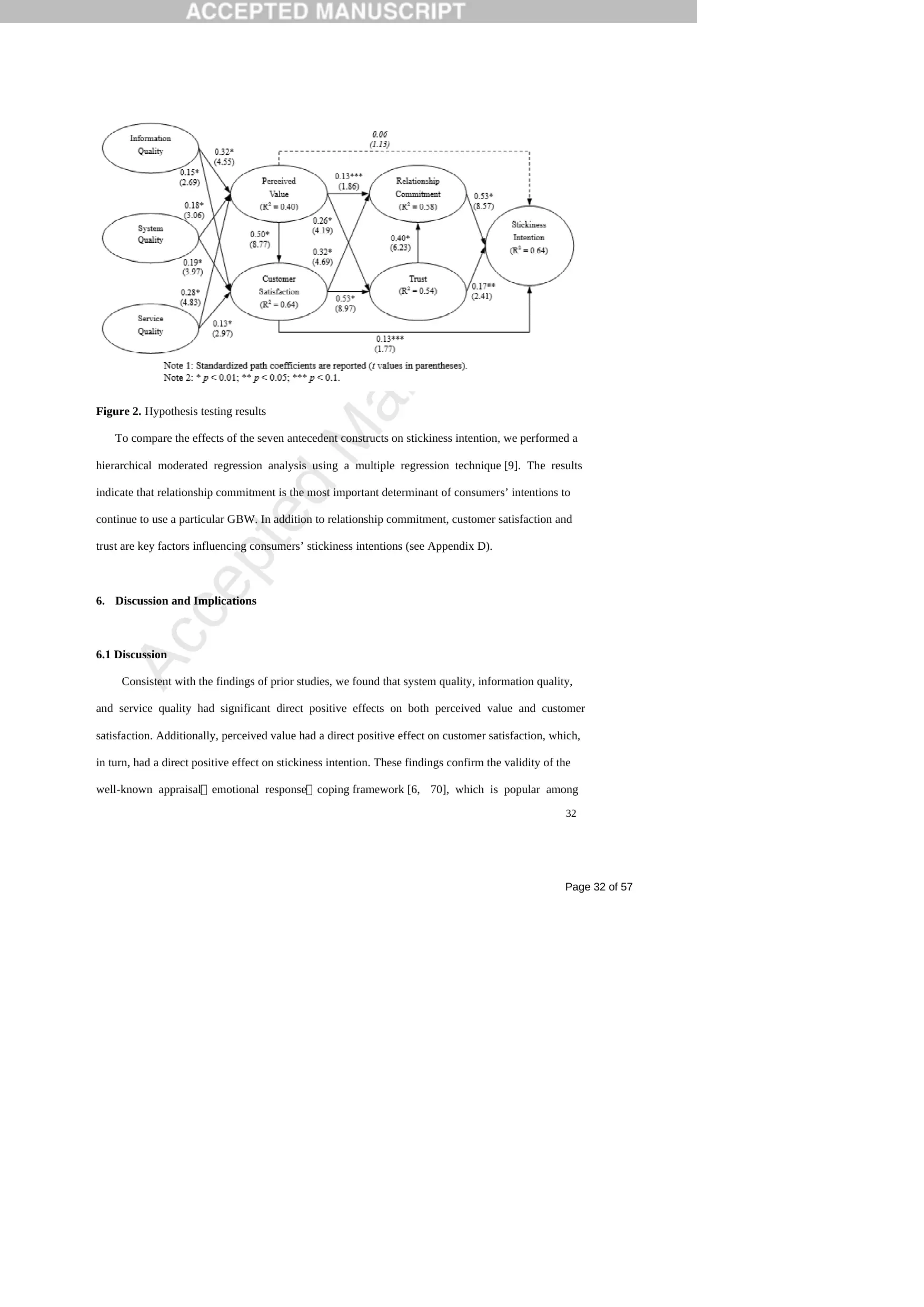
Page 32 of 57
Accepted Manuscript
32
Figure 2. Hypothesis testing results
To compare the effects of the seven antecedent constructs on stickiness intention, we performed a
hierarchical moderated regression analysis using a multiple regression technique [9]. The results
indicate that relationship commitment is the most important determinant of consumers’ intentions to
continue to use a particular GBW. In addition to relationship commitment, customer satisfaction and
trust are key factors influencing consumers’ stickiness intentions (see Appendix D).
6. Discussion and Implications
6.1 Discussion
Consistent with the findings of prior studies, we found that system quality, information quality,
and service quality had significant direct positive effects on both perceived value and customer
satisfaction. Additionally, perceived value had a direct positive effect on customer satisfaction, which,
in turn, had a direct positive effect on stickiness intention. These findings confirm the validity of the
well-known appraisal emotional response coping framework [6, 70], which is popular among
Accepted Manuscript
32
Figure 2. Hypothesis testing results
To compare the effects of the seven antecedent constructs on stickiness intention, we performed a
hierarchical moderated regression analysis using a multiple regression technique [9]. The results
indicate that relationship commitment is the most important determinant of consumers’ intentions to
continue to use a particular GBW. In addition to relationship commitment, customer satisfaction and
trust are key factors influencing consumers’ stickiness intentions (see Appendix D).
6. Discussion and Implications
6.1 Discussion
Consistent with the findings of prior studies, we found that system quality, information quality,
and service quality had significant direct positive effects on both perceived value and customer
satisfaction. Additionally, perceived value had a direct positive effect on customer satisfaction, which,
in turn, had a direct positive effect on stickiness intention. These findings confirm the validity of the
well-known appraisal emotional response coping framework [6, 70], which is popular among

Page 33 of 57
Accepted Manuscript
33
marketing and e-commerce researchers [4, 20, 77, 109]. This study thus provides support for the use
of this framework to comprehend consumer behaviors in a C2B context, which is a relatively less
researched area, by taking the participants of online group-buying activities as an example.
However, perceived value did not have a significant direct effect on stickiness intention. The
absence of face-to-face interactions between consumers and the representatives of GBWs may
contribute to this phenomenon, because decisions related to participation in online group-buying
activities via a particular website tend to be dependent on the consumers’ trust in the website. The
formation of this trust tends to be contingent on consumers’ knowledge of the procedures and
mechanisms enforced by the website to ensure a positive use experience, which may only be acquired
through physical interactions [52]. Therefore, a high level of consumer perceived value based on prior
experience with the website may not directly increase consumer intentions to stick with the website in
the future. Additionally, this finding suggests that perceived value cannot directly affect the stickiness
intention of GBW users, because perceived value must be converted to satisfaction. Perceived value
represents GBW users’ assessment of the net worth of a product/service. When the perceived value
fails to reach GBW consumers’ required level, those consumers may not plan to stay with the GBW,
even though sometimes the perceived value regarding their use of the GBW is high.
We found that both perceived value and customer satisfaction had significant positive influences
on consumers’ relationship commitment to and trust in e-commerce websites. These findings are
consistent with the findings of prior studies [4, 22, 33, 42, 71, 66, 92, 93], and imply that although the
online switching cost are generally believed to be lower than those in traditional offline contexts [72],
GBW users are still concerned about the sunk costs that are associated with their switching behaviors.
When the users of a GBW perceive their interactions with the GBW to be valuable, in that the
corresponding outcomes meet their expectations, they are likely to consider the cost of ceasing their
relationship with the GBW to be high or unacceptable, and are thus more committed to maintaining
this relationship. Additionally, in evaluating the trustworthiness of a GBW, consumers are likely to be
concerned with whether the GBW are capable of fulfilling their needs (trust in one’s ability),
Accepted Manuscript
33
marketing and e-commerce researchers [4, 20, 77, 109]. This study thus provides support for the use
of this framework to comprehend consumer behaviors in a C2B context, which is a relatively less
researched area, by taking the participants of online group-buying activities as an example.
However, perceived value did not have a significant direct effect on stickiness intention. The
absence of face-to-face interactions between consumers and the representatives of GBWs may
contribute to this phenomenon, because decisions related to participation in online group-buying
activities via a particular website tend to be dependent on the consumers’ trust in the website. The
formation of this trust tends to be contingent on consumers’ knowledge of the procedures and
mechanisms enforced by the website to ensure a positive use experience, which may only be acquired
through physical interactions [52]. Therefore, a high level of consumer perceived value based on prior
experience with the website may not directly increase consumer intentions to stick with the website in
the future. Additionally, this finding suggests that perceived value cannot directly affect the stickiness
intention of GBW users, because perceived value must be converted to satisfaction. Perceived value
represents GBW users’ assessment of the net worth of a product/service. When the perceived value
fails to reach GBW consumers’ required level, those consumers may not plan to stay with the GBW,
even though sometimes the perceived value regarding their use of the GBW is high.
We found that both perceived value and customer satisfaction had significant positive influences
on consumers’ relationship commitment to and trust in e-commerce websites. These findings are
consistent with the findings of prior studies [4, 22, 33, 42, 71, 66, 92, 93], and imply that although the
online switching cost are generally believed to be lower than those in traditional offline contexts [72],
GBW users are still concerned about the sunk costs that are associated with their switching behaviors.
When the users of a GBW perceive their interactions with the GBW to be valuable, in that the
corresponding outcomes meet their expectations, they are likely to consider the cost of ceasing their
relationship with the GBW to be high or unacceptable, and are thus more committed to maintaining
this relationship. Additionally, in evaluating the trustworthiness of a GBW, consumers are likely to be
concerned with whether the GBW are capable of fulfilling their needs (trust in one’s ability),
Secure Best Marks with AI Grader
Need help grading? Try our AI Grader for instant feedback on your assignments.

Page 34 of 57
Accepted Manuscript
34
considering their best interest (trust in one’s benevolence), and complying with adequate rules (trust
in one’s integrity) to a satisfactory degree. Such consumer trust in the GBW may lead consumers to
put efforts into maintaining their relationships with the GBW (i.e., relationship commitment). In
summary, these findings indicate the importance of developing a continuum of customer relationships
in e-commerce contexts, ranging from the transactional (i.e., perceived value and customer
satisfaction) to the relational orientation (i.e., relationship commitment and trust) to increase customer
retention rates [34, 38].
The confirmation of the causal paths between relationship commitment, trust, and stickiness
intention (i.e., H6a, H6b, and H7) provides empirical support for the central premise of
commitment-trust theory in C2B contexts, as in previous studies that adopted this theory for B2C or
B2B contexts [72, 87, 102, 106]. Additionally, while satisfaction, trust, and relationship commitment
significantly affect GBW users’ stickiness intention, relationship commitment appears to have a
stronger influence. These results highlight the importance of relationship commitment in terms of
strengthening the bonds between GBWs and their users from a relational perspective, because
committed GBW users may be less sensitive or responsive to the information regarding alternative
GBWs even though there may be abundant marketing messages that aim to encourage their switching
behaviors. To conclude, the findings of this study imply that policies/strategies that aim to enhance
the performance of technical/IS and transactional measures may be considered to be effective for
retaining consumers only if they contribute to the development and maintenance of online consumers’
relational commitment to and trust in the e-commerce website.
6.2 Implications for research
The results of this study have a number of implications for research. First, they indicate the
significant explanatory power of our research model for the behaviors of online consumers. The
research results thus contribute to the current understanding of e-commerce by simultaneously
examining the relative importance of the technical, transactional, and relational views, which have not
Accepted Manuscript
34
considering their best interest (trust in one’s benevolence), and complying with adequate rules (trust
in one’s integrity) to a satisfactory degree. Such consumer trust in the GBW may lead consumers to
put efforts into maintaining their relationships with the GBW (i.e., relationship commitment). In
summary, these findings indicate the importance of developing a continuum of customer relationships
in e-commerce contexts, ranging from the transactional (i.e., perceived value and customer
satisfaction) to the relational orientation (i.e., relationship commitment and trust) to increase customer
retention rates [34, 38].
The confirmation of the causal paths between relationship commitment, trust, and stickiness
intention (i.e., H6a, H6b, and H7) provides empirical support for the central premise of
commitment-trust theory in C2B contexts, as in previous studies that adopted this theory for B2C or
B2B contexts [72, 87, 102, 106]. Additionally, while satisfaction, trust, and relationship commitment
significantly affect GBW users’ stickiness intention, relationship commitment appears to have a
stronger influence. These results highlight the importance of relationship commitment in terms of
strengthening the bonds between GBWs and their users from a relational perspective, because
committed GBW users may be less sensitive or responsive to the information regarding alternative
GBWs even though there may be abundant marketing messages that aim to encourage their switching
behaviors. To conclude, the findings of this study imply that policies/strategies that aim to enhance
the performance of technical/IS and transactional measures may be considered to be effective for
retaining consumers only if they contribute to the development and maintenance of online consumers’
relational commitment to and trust in the e-commerce website.
6.2 Implications for research
The results of this study have a number of implications for research. First, they indicate the
significant explanatory power of our research model for the behaviors of online consumers. The
research results thus contribute to the current understanding of e-commerce by simultaneously
examining the relative importance of the technical, transactional, and relational views, which have not

Page 35 of 57
Accepted Manuscript
35
been comprehensively addressed in the e-commerce literature. This study thus contributes to the
theoretical development of existing e-commerce literature by integrating the IS-oriented theory (i.e.,
e-commerce success model) with the consumer-behavior theory (i.e., commitment-trust theory) to
appropriately incorporate the key premises of the technical, transactional, and relational views to
understand e-commerce consumer behaviors in the context of online group buying. Of all of the
constructs that influence consumer stickiness intentions toward GBWs, relationship commitment,
trust, and customer satisfaction had relatively greater effects. These findings extend those of prior
e-commerce studies that have adopted the transactional and relational views by further demonstrating
the importance of relationship commitment, trust, and customer satisfaction in interpreting and
predicting consumer behaviors in the context of online group-buying.
Second, e-commerce studies have adopted commitment-trust theory to investigate consumer
behaviors in online contexts, but these studies have mostly focused on B2C or B2B contexts [62, 72,
87, 103, 106]. Few studies have adopted commitment-trust theory by jointly considering relationship
commitment and trust to investigate online consumer behaviors in C2B contexts. In an online context,
trust does not necessary guarantee the formation of sustainable relationships that facilitate new social
interactions, because of the perceived risks associated with the lack of face-to-face contacts [30]. Our
research findings can thus provide researchers with insights into the adoption of commitment-trust
theory to effectively identify and investigate the key success factors of e-commerce websites in a
variety of C2B contexts from a relational perspective.
Third, we found that relationship commitment and trust mediates the effects of perceived value
and customer satisfaction on consumers’ stickiness intentions toward a particular website. Thus, these
research results provide empirical support for the central premise of commitment-trust theory, namely
the significant mediational roles of relationship commitment and trust in the indirect relationships
between antecedent and outcome variables for relationship building and maintenance in an
e-commerce context. In other words, we find that relationship commitment and trust can be built
through the implementation of quality e-commerce systems, and positively influence consumers’
Accepted Manuscript
35
been comprehensively addressed in the e-commerce literature. This study thus contributes to the
theoretical development of existing e-commerce literature by integrating the IS-oriented theory (i.e.,
e-commerce success model) with the consumer-behavior theory (i.e., commitment-trust theory) to
appropriately incorporate the key premises of the technical, transactional, and relational views to
understand e-commerce consumer behaviors in the context of online group buying. Of all of the
constructs that influence consumer stickiness intentions toward GBWs, relationship commitment,
trust, and customer satisfaction had relatively greater effects. These findings extend those of prior
e-commerce studies that have adopted the transactional and relational views by further demonstrating
the importance of relationship commitment, trust, and customer satisfaction in interpreting and
predicting consumer behaviors in the context of online group-buying.
Second, e-commerce studies have adopted commitment-trust theory to investigate consumer
behaviors in online contexts, but these studies have mostly focused on B2C or B2B contexts [62, 72,
87, 103, 106]. Few studies have adopted commitment-trust theory by jointly considering relationship
commitment and trust to investigate online consumer behaviors in C2B contexts. In an online context,
trust does not necessary guarantee the formation of sustainable relationships that facilitate new social
interactions, because of the perceived risks associated with the lack of face-to-face contacts [30]. Our
research findings can thus provide researchers with insights into the adoption of commitment-trust
theory to effectively identify and investigate the key success factors of e-commerce websites in a
variety of C2B contexts from a relational perspective.
Third, we found that relationship commitment and trust mediates the effects of perceived value
and customer satisfaction on consumers’ stickiness intentions toward a particular website. Thus, these
research results provide empirical support for the central premise of commitment-trust theory, namely
the significant mediational roles of relationship commitment and trust in the indirect relationships
between antecedent and outcome variables for relationship building and maintenance in an
e-commerce context. In other words, we find that relationship commitment and trust can be built
through the implementation of quality e-commerce systems, and positively influence consumers’

Page 36 of 57
Accepted Manuscript
36
stickiness intentions by reducing consumers’ concerns caused by the uncertainty and risks involved in
online transaction processes. Overall, this study verify the importance of the simultaneous adoption of
relationship commitment and trust, which have not received the attention they deserve from
e-commerce professionals, as inseparable critical factors for the formation and maintenance of
relationships between business parties, especially in C2B contexts.
Finally, the e-commerce success model has been frequently applied to studies in various online
contexts because of its unique merits in integrating technical and transactional views into one single
model [20, 105, 109]. However, to the best of our knowledge, no previous studies have adopted this
model to investigate online consumer behavior`s in C2B contexts. Consequently, our research results
further validate the usefulness of this model in terms of investigating the success of C2B websites.
6.3 Implications for practice
Relationship commitment and trust exhibit a relatively stronger influence on consumers’
stickiness intentions than the other key e-commerce success factors included in the research model.
These findings indicate that although the switching costs of consumers are decreasing due to intensive
competition in e-commerce markets, website managers may be able to retain customers if they take
advantage of the critical factors that help to establish and maintain favorable social relationships with
consumers [72]. GBWs should provide their customers with mechanisms that decrease their
perceived uncertainty and the risks associated with the use of these websites to build and maintain
good reputations that could lead to higher levels of trust from those customers. These mechanisms
may include robust authentication procedures for verifying the identities of participants in online
group-buying transactions and actively publishing or distributing positive textual comments or
word-of-mouth from website participants.
Additionally, GBWs can develop rating systems for information related to the credibility and
integrity of online sellers and other potential participants in online group-buying transactions. These
rating systems can help potential participants in online group-buying to reduce their perceived
Accepted Manuscript
36
stickiness intentions by reducing consumers’ concerns caused by the uncertainty and risks involved in
online transaction processes. Overall, this study verify the importance of the simultaneous adoption of
relationship commitment and trust, which have not received the attention they deserve from
e-commerce professionals, as inseparable critical factors for the formation and maintenance of
relationships between business parties, especially in C2B contexts.
Finally, the e-commerce success model has been frequently applied to studies in various online
contexts because of its unique merits in integrating technical and transactional views into one single
model [20, 105, 109]. However, to the best of our knowledge, no previous studies have adopted this
model to investigate online consumer behavior`s in C2B contexts. Consequently, our research results
further validate the usefulness of this model in terms of investigating the success of C2B websites.
6.3 Implications for practice
Relationship commitment and trust exhibit a relatively stronger influence on consumers’
stickiness intentions than the other key e-commerce success factors included in the research model.
These findings indicate that although the switching costs of consumers are decreasing due to intensive
competition in e-commerce markets, website managers may be able to retain customers if they take
advantage of the critical factors that help to establish and maintain favorable social relationships with
consumers [72]. GBWs should provide their customers with mechanisms that decrease their
perceived uncertainty and the risks associated with the use of these websites to build and maintain
good reputations that could lead to higher levels of trust from those customers. These mechanisms
may include robust authentication procedures for verifying the identities of participants in online
group-buying transactions and actively publishing or distributing positive textual comments or
word-of-mouth from website participants.
Additionally, GBWs can develop rating systems for information related to the credibility and
integrity of online sellers and other potential participants in online group-buying transactions. These
rating systems can help potential participants in online group-buying to reduce their perceived
Paraphrase This Document
Need a fresh take? Get an instant paraphrase of this document with our AI Paraphraser

Page 37 of 57
Accepted Manuscript
37
uncertainty and the risks associated with the initiators and other participants, thereby facilitating the
development of trusting relationships between the websites and their consumers and enhancing
consumers’ long-term commitment to maintaining these relationships. GBWs may also use discussion
forums to facilitate the exchange of information among sellers, consumers, and staff of the website to
better understand what motivates consumers to continue to participate in online group-buying via the
websites. This knowledge may help managers of the GBWs to respond to these motivations
effectively and then enhance favorable relationships between the GBWs and their potential
participants. The research results also indicate that consumers’ stickiness intentions toward a
particular website can be enhanced if the formation of perceived value, customer satisfaction,
relationship commitment, and trust are effectively managed. Thus, it is necessary forGBWs to
implement strategies that facilitate the development and maintenance of the indicated psychological
processes to increase their consumers’ relationship commitment to and trust in them.
Finally, the confirmation of the importance of high information quality, system quality, and
service quality highlights the importance of designing e-commerce systems that are capable of
providing consumers with reliable and convenient system functions, quality information, and
exceptional system-related services. These services can be provided by complying with critical
system design features, including an interactive and intuitive system design and the provision of
customized and/or personalized information and/or system-related services. Well-designed
e-commerce systems can increase consumers’ perceived value and satisfaction by minimizing the
perceived uncertainty and risks that may arise from consumer concerns about the operational
complexity, convenience, reliability, and trustworthiness of the online group-buying processes.
7. Conclusion
This study attempts to advance the understanding of the success of e-commerce websites from a
holistic perspective by integrating the technical, transactional, and relational perspectives. To achieve
Accepted Manuscript
37
uncertainty and the risks associated with the initiators and other participants, thereby facilitating the
development of trusting relationships between the websites and their consumers and enhancing
consumers’ long-term commitment to maintaining these relationships. GBWs may also use discussion
forums to facilitate the exchange of information among sellers, consumers, and staff of the website to
better understand what motivates consumers to continue to participate in online group-buying via the
websites. This knowledge may help managers of the GBWs to respond to these motivations
effectively and then enhance favorable relationships between the GBWs and their potential
participants. The research results also indicate that consumers’ stickiness intentions toward a
particular website can be enhanced if the formation of perceived value, customer satisfaction,
relationship commitment, and trust are effectively managed. Thus, it is necessary forGBWs to
implement strategies that facilitate the development and maintenance of the indicated psychological
processes to increase their consumers’ relationship commitment to and trust in them.
Finally, the confirmation of the importance of high information quality, system quality, and
service quality highlights the importance of designing e-commerce systems that are capable of
providing consumers with reliable and convenient system functions, quality information, and
exceptional system-related services. These services can be provided by complying with critical
system design features, including an interactive and intuitive system design and the provision of
customized and/or personalized information and/or system-related services. Well-designed
e-commerce systems can increase consumers’ perceived value and satisfaction by minimizing the
perceived uncertainty and risks that may arise from consumer concerns about the operational
complexity, convenience, reliability, and trustworthiness of the online group-buying processes.
7. Conclusion
This study attempts to advance the understanding of the success of e-commerce websites from a
holistic perspective by integrating the technical, transactional, and relational perspectives. To achieve

Page 38 of 57
Accepted Manuscript
38
this purpose, a multi-view research model that integrates the key concepts of the e-commerce success
model and commitment-trust theory is developed. The proposed multi-view model is examined in the
C2B context of GBWs. Consequently, the research results provide managers with significant insights
into effective methods for designing their websites and managing their relationships with customers
to encourage customers to continue to use their websites to conduct online business activities.
However, this study has some limitations. The first limitation is the generalizability of the
research findings. The research findings were based on a nonrandom sample collected only from
experienced consumers of online GBWs in Taiwan. Future studies are advised to examine the
proposed research model or its extension to a variety of e-commerce contexts using samples that are
collected from other areas with better sampling procedures. Second, in this study, trust was treated as
a trusting belief. However, trust is a construct with multiple aspects that have significantly different
influences on behavior. Consequently, future research should focus on the influence of other aspects
of trust, such as the disposition of trust, institution-based trust, and trusting intentions [84], on the
behavior of online consumers. Third, although the research results indicate the usefulness of adopting
relationship commitment as an important factor for evaluating online consumers’ behaviors, studies
have demonstrated the merits of distinguishing between types of commitment, including cognitive,
affective, normative, and continuance commitment [43, 87]. Thus, the contributions of this study can
be extended through future research that aims to investigate similar issues by considering these
distinctions. Finally, we use the construct of stickiness intention as a surrogate for behavioral loyalty
in the context of website use. Future research may concentrate on examining the effects of the
antecedents in our research model on other dimensions of loyalty, such as cognitive, affective, and
attitudinal loyalty [11, 89, 90], in the same or similar research contexts.
Accepted Manuscript
38
this purpose, a multi-view research model that integrates the key concepts of the e-commerce success
model and commitment-trust theory is developed. The proposed multi-view model is examined in the
C2B context of GBWs. Consequently, the research results provide managers with significant insights
into effective methods for designing their websites and managing their relationships with customers
to encourage customers to continue to use their websites to conduct online business activities.
However, this study has some limitations. The first limitation is the generalizability of the
research findings. The research findings were based on a nonrandom sample collected only from
experienced consumers of online GBWs in Taiwan. Future studies are advised to examine the
proposed research model or its extension to a variety of e-commerce contexts using samples that are
collected from other areas with better sampling procedures. Second, in this study, trust was treated as
a trusting belief. However, trust is a construct with multiple aspects that have significantly different
influences on behavior. Consequently, future research should focus on the influence of other aspects
of trust, such as the disposition of trust, institution-based trust, and trusting intentions [84], on the
behavior of online consumers. Third, although the research results indicate the usefulness of adopting
relationship commitment as an important factor for evaluating online consumers’ behaviors, studies
have demonstrated the merits of distinguishing between types of commitment, including cognitive,
affective, normative, and continuance commitment [43, 87]. Thus, the contributions of this study can
be extended through future research that aims to investigate similar issues by considering these
distinctions. Finally, we use the construct of stickiness intention as a surrogate for behavioral loyalty
in the context of website use. Future research may concentrate on examining the effects of the
antecedents in our research model on other dimensions of loyalty, such as cognitive, affective, and
attitudinal loyalty [11, 89, 90], in the same or similar research contexts.
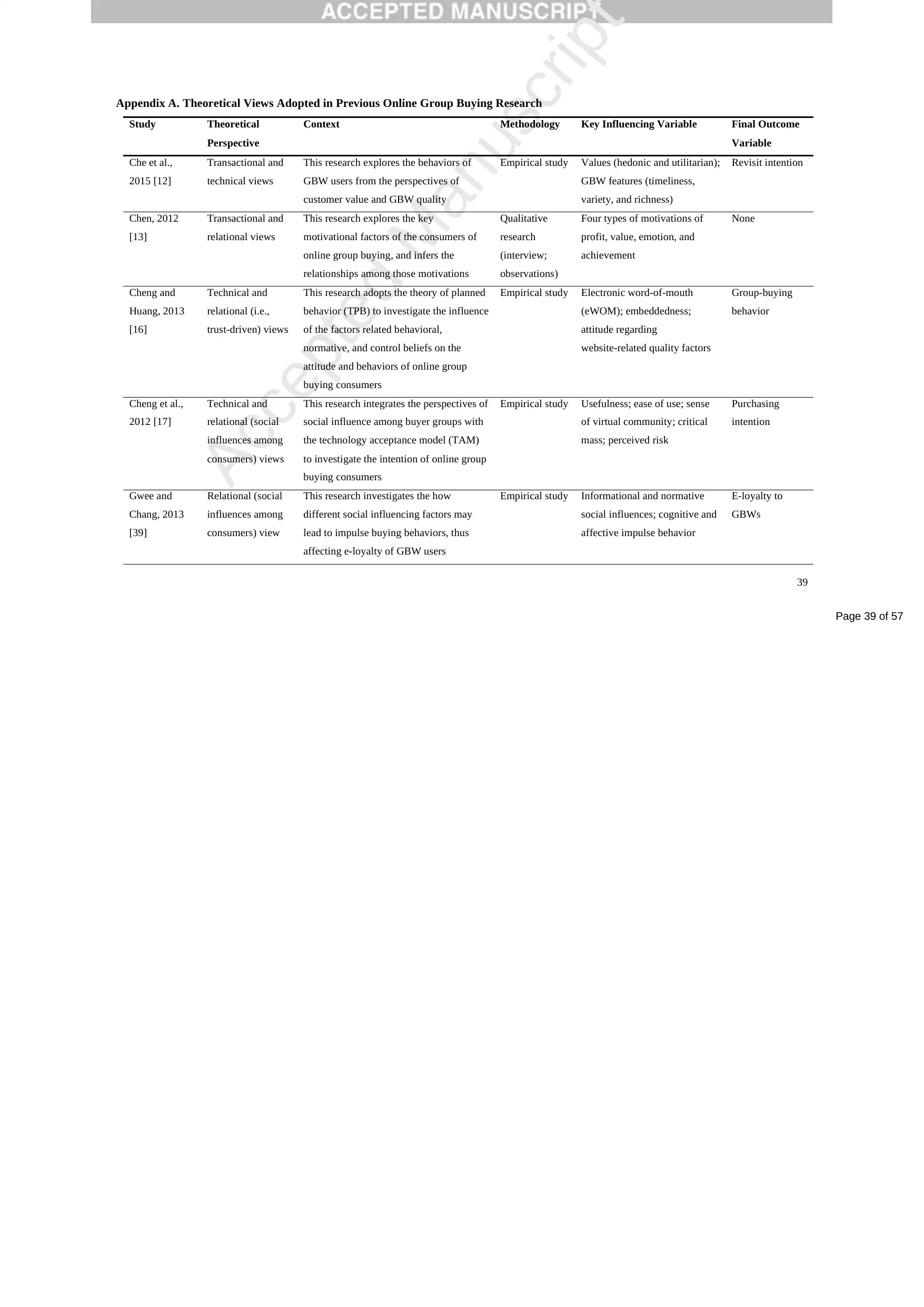
Page 39 of 57
Accepted Manuscript
39
Appendix A. Theoretical Views Adopted in Previous Online Group Buying Research
Study Theoretical
Perspective
Context Methodology Key Influencing Variable Final Outcome
Variable
Che et al.,
2015 [12]
Transactional and
technical views
This research explores the behaviors of
GBW users from the perspectives of
customer value and GBW quality
Empirical study Values (hedonic and utilitarian);
GBW features (timeliness,
variety, and richness)
Revisit intention
Chen, 2012
[13]
Transactional and
relational views
This research explores the key
motivational factors of the consumers of
online group buying, and infers the
relationships among those motivations
Qualitative
research
(interview;
observations)
Four types of motivations of
profit, value, emotion, and
achievement
None
Cheng and
Huang, 2013
[16]
Technical and
relational (i.e.,
trust-driven) views
This research adopts the theory of planned
behavior (TPB) to investigate the influence
of the factors related behavioral,
normative, and control beliefs on the
attitude and behaviors of online group
buying consumers
Empirical study Electronic word-of-mouth
(eWOM); embeddedness;
attitude regarding
website-related quality factors
Group-buying
behavior
Cheng et al.,
2012 [17]
Technical and
relational (social
influences among
consumers) views
This research integrates the perspectives of
social influence among buyer groups with
the technology acceptance model (TAM)
to investigate the intention of online group
buying consumers
Empirical study Usefulness; ease of use; sense
of virtual community; critical
mass; perceived risk
Purchasing
intention
Gwee and
Chang, 2013
[39]
Relational (social
influences among
consumers) view
This research investigates the how
different social influencing factors may
lead to impulse buying behaviors, thus
affecting e-loyalty of GBW users
Empirical study Informational and normative
social influences; cognitive and
affective impulse behavior
E-loyalty to
GBWs
Accepted Manuscript
39
Appendix A. Theoretical Views Adopted in Previous Online Group Buying Research
Study Theoretical
Perspective
Context Methodology Key Influencing Variable Final Outcome
Variable
Che et al.,
2015 [12]
Transactional and
technical views
This research explores the behaviors of
GBW users from the perspectives of
customer value and GBW quality
Empirical study Values (hedonic and utilitarian);
GBW features (timeliness,
variety, and richness)
Revisit intention
Chen, 2012
[13]
Transactional and
relational views
This research explores the key
motivational factors of the consumers of
online group buying, and infers the
relationships among those motivations
Qualitative
research
(interview;
observations)
Four types of motivations of
profit, value, emotion, and
achievement
None
Cheng and
Huang, 2013
[16]
Technical and
relational (i.e.,
trust-driven) views
This research adopts the theory of planned
behavior (TPB) to investigate the influence
of the factors related behavioral,
normative, and control beliefs on the
attitude and behaviors of online group
buying consumers
Empirical study Electronic word-of-mouth
(eWOM); embeddedness;
attitude regarding
website-related quality factors
Group-buying
behavior
Cheng et al.,
2012 [17]
Technical and
relational (social
influences among
consumers) views
This research integrates the perspectives of
social influence among buyer groups with
the technology acceptance model (TAM)
to investigate the intention of online group
buying consumers
Empirical study Usefulness; ease of use; sense
of virtual community; critical
mass; perceived risk
Purchasing
intention
Gwee and
Chang, 2013
[39]
Relational (social
influences among
consumers) view
This research investigates the how
different social influencing factors may
lead to impulse buying behaviors, thus
affecting e-loyalty of GBW users
Empirical study Informational and normative
social influences; cognitive and
affective impulse behavior
E-loyalty to
GBWs
Secure Best Marks with AI Grader
Need help grading? Try our AI Grader for instant feedback on your assignments.
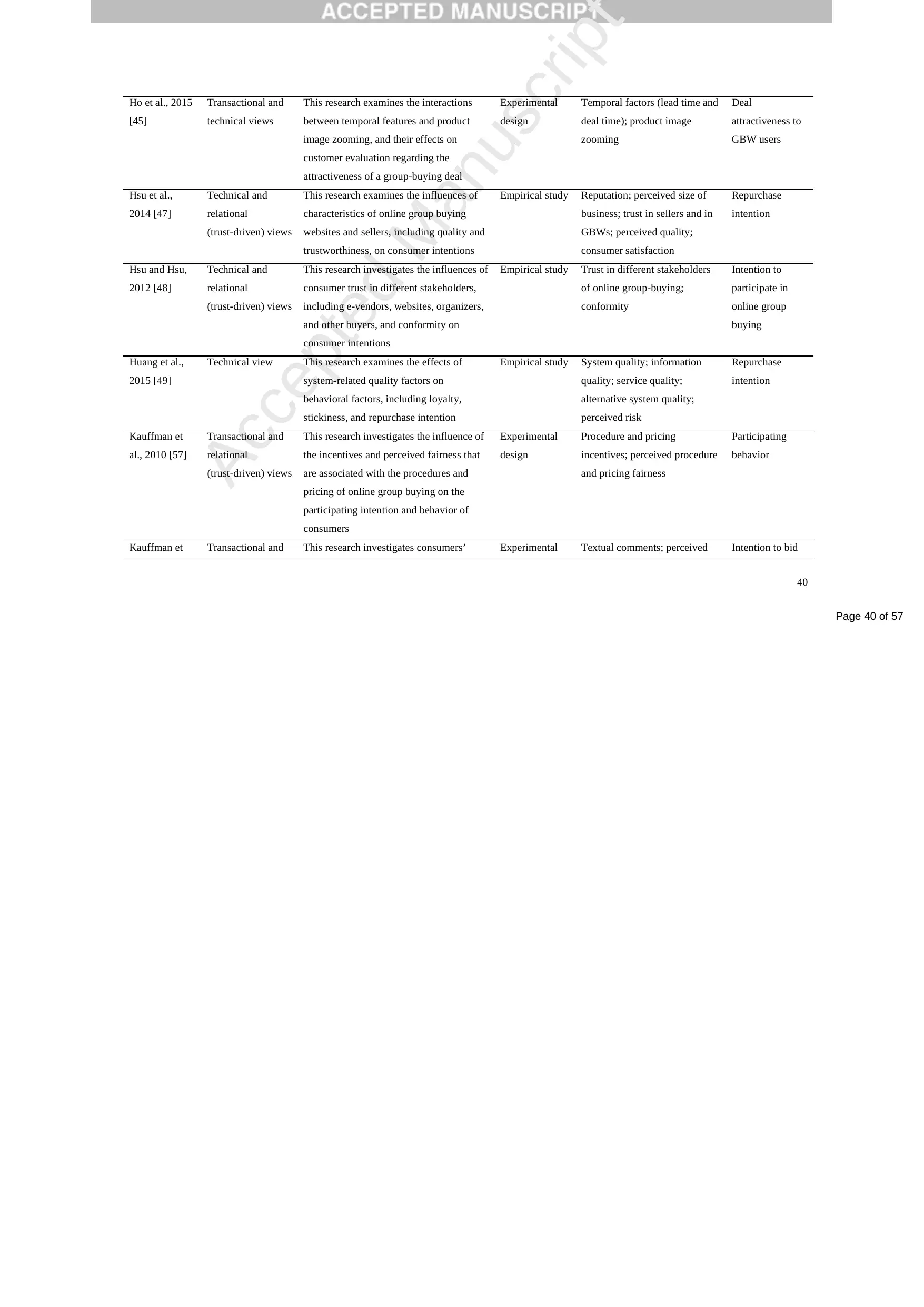
Page 40 of 57
Accepted Manuscript
40
Ho et al., 2015
[45]
Transactional and
technical views
This research examines the interactions
between temporal features and product
image zooming, and their effects on
customer evaluation regarding the
attractiveness of a group-buying deal
Experimental
design
Temporal factors (lead time and
deal time); product image
zooming
Deal
attractiveness to
GBW users
Hsu et al.,
2014 [47]
Technical and
relational
(trust-driven) views
This research examines the influences of
characteristics of online group buying
websites and sellers, including quality and
trustworthiness, on consumer intentions
Empirical study Reputation; perceived size of
business; trust in sellers and in
GBWs; perceived quality;
consumer satisfaction
Repurchase
intention
Hsu and Hsu,
2012 [48]
Technical and
relational
(trust-driven) views
This research investigates the influences of
consumer trust in different stakeholders,
including e-vendors, websites, organizers,
and other buyers, and conformity on
consumer intentions
Empirical study Trust in different stakeholders
of online group-buying;
conformity
Intention to
participate in
online group
buying
Huang et al.,
2015 [49]
Technical view This research examines the effects of
system-related quality factors on
behavioral factors, including loyalty,
stickiness, and repurchase intention
Empirical study System quality; information
quality; service quality;
alternative system quality;
perceived risk
Repurchase
intention
Kauffman et
al., 2010 [57]
Transactional and
relational
(trust-driven) views
This research investigates the influence of
the incentives and perceived fairness that
are associated with the procedures and
pricing of online group buying on the
participating intention and behavior of
consumers
Experimental
design
Procedure and pricing
incentives; perceived procedure
and pricing fairness
Participating
behavior
Kauffman et Transactional and This research investigates consumers’ Experimental Textual comments; perceived Intention to bid
Accepted Manuscript
40
Ho et al., 2015
[45]
Transactional and
technical views
This research examines the interactions
between temporal features and product
image zooming, and their effects on
customer evaluation regarding the
attractiveness of a group-buying deal
Experimental
design
Temporal factors (lead time and
deal time); product image
zooming
Deal
attractiveness to
GBW users
Hsu et al.,
2014 [47]
Technical and
relational
(trust-driven) views
This research examines the influences of
characteristics of online group buying
websites and sellers, including quality and
trustworthiness, on consumer intentions
Empirical study Reputation; perceived size of
business; trust in sellers and in
GBWs; perceived quality;
consumer satisfaction
Repurchase
intention
Hsu and Hsu,
2012 [48]
Technical and
relational
(trust-driven) views
This research investigates the influences of
consumer trust in different stakeholders,
including e-vendors, websites, organizers,
and other buyers, and conformity on
consumer intentions
Empirical study Trust in different stakeholders
of online group-buying;
conformity
Intention to
participate in
online group
buying
Huang et al.,
2015 [49]
Technical view This research examines the effects of
system-related quality factors on
behavioral factors, including loyalty,
stickiness, and repurchase intention
Empirical study System quality; information
quality; service quality;
alternative system quality;
perceived risk
Repurchase
intention
Kauffman et
al., 2010 [57]
Transactional and
relational
(trust-driven) views
This research investigates the influence of
the incentives and perceived fairness that
are associated with the procedures and
pricing of online group buying on the
participating intention and behavior of
consumers
Experimental
design
Procedure and pricing
incentives; perceived procedure
and pricing fairness
Participating
behavior
Kauffman et Transactional and This research investigates consumers’ Experimental Textual comments; perceived Intention to bid
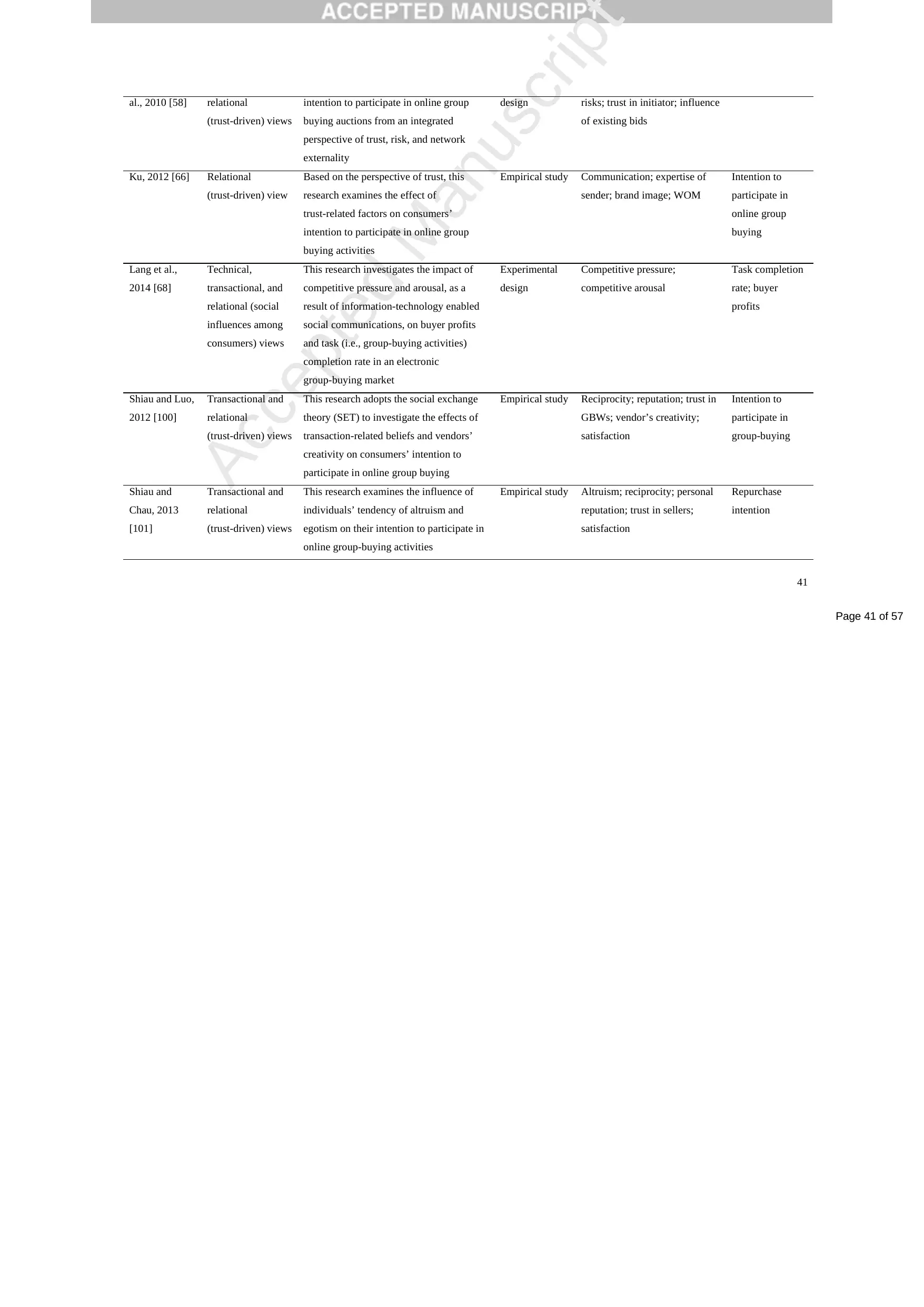
Page 41 of 57
Accepted Manuscript
41
al., 2010 [58] relational
(trust-driven) views
intention to participate in online group
buying auctions from an integrated
perspective of trust, risk, and network
externality
design risks; trust in initiator; influence
of existing bids
Ku, 2012 [66] Relational
(trust-driven) view
Based on the perspective of trust, this
research examines the effect of
trust-related factors on consumers’
intention to participate in online group
buying activities
Empirical study Communication; expertise of
sender; brand image; WOM
Intention to
participate in
online group
buying
Lang et al.,
2014 [68]
Technical,
transactional, and
relational (social
influences among
consumers) views
This research investigates the impact of
competitive pressure and arousal, as a
result of information-technology enabled
social communications, on buyer profits
and task (i.e., group-buying activities)
completion rate in an electronic
group-buying market
Experimental
design
Competitive pressure;
competitive arousal
Task completion
rate; buyer
profits
Shiau and Luo,
2012 [100]
Transactional and
relational
(trust-driven) views
This research adopts the social exchange
theory (SET) to investigate the effects of
transaction-related beliefs and vendors’
creativity on consumers’ intention to
participate in online group buying
Empirical study Reciprocity; reputation; trust in
GBWs; vendor’s creativity;
satisfaction
Intention to
participate in
group-buying
Shiau and
Chau, 2013
[101]
Transactional and
relational
(trust-driven) views
This research examines the influence of
individuals’ tendency of altruism and
egotism on their intention to participate in
online group-buying activities
Empirical study Altruism; reciprocity; personal
reputation; trust in sellers;
satisfaction
Repurchase
intention
Accepted Manuscript
41
al., 2010 [58] relational
(trust-driven) views
intention to participate in online group
buying auctions from an integrated
perspective of trust, risk, and network
externality
design risks; trust in initiator; influence
of existing bids
Ku, 2012 [66] Relational
(trust-driven) view
Based on the perspective of trust, this
research examines the effect of
trust-related factors on consumers’
intention to participate in online group
buying activities
Empirical study Communication; expertise of
sender; brand image; WOM
Intention to
participate in
online group
buying
Lang et al.,
2014 [68]
Technical,
transactional, and
relational (social
influences among
consumers) views
This research investigates the impact of
competitive pressure and arousal, as a
result of information-technology enabled
social communications, on buyer profits
and task (i.e., group-buying activities)
completion rate in an electronic
group-buying market
Experimental
design
Competitive pressure;
competitive arousal
Task completion
rate; buyer
profits
Shiau and Luo,
2012 [100]
Transactional and
relational
(trust-driven) views
This research adopts the social exchange
theory (SET) to investigate the effects of
transaction-related beliefs and vendors’
creativity on consumers’ intention to
participate in online group buying
Empirical study Reciprocity; reputation; trust in
GBWs; vendor’s creativity;
satisfaction
Intention to
participate in
group-buying
Shiau and
Chau, 2013
[101]
Transactional and
relational
(trust-driven) views
This research examines the influence of
individuals’ tendency of altruism and
egotism on their intention to participate in
online group-buying activities
Empirical study Altruism; reciprocity; personal
reputation; trust in sellers;
satisfaction
Repurchase
intention
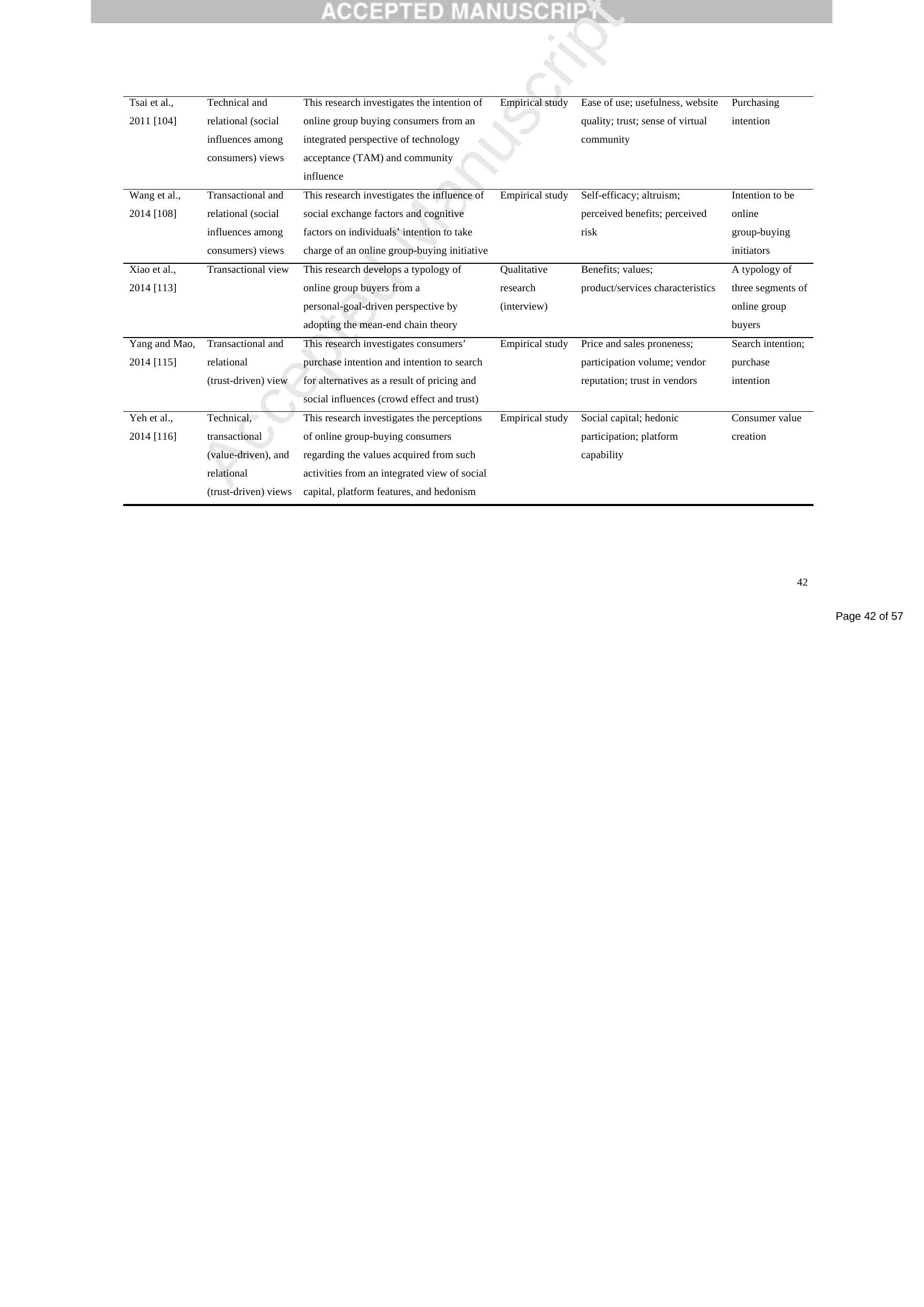
Page 42 of 57
Accepted Manuscript
42
Tsai et al.,
2011 [104]
Technical and
relational (social
influences among
consumers) views
This research investigates the intention of
online group buying consumers from an
integrated perspective of technology
acceptance (TAM) and community
influence
Empirical study Ease of use; usefulness, website
quality; trust; sense of virtual
community
Purchasing
intention
Wang et al.,
2014 [108]
Transactional and
relational (social
influences among
consumers) views
This research investigates the influence of
social exchange factors and cognitive
factors on individuals’ intention to take
charge of an online group-buying initiative
Empirical study Self-efficacy; altruism;
perceived benefits; perceived
risk
Intention to be
online
group-buying
initiators
Xiao et al.,
2014 [113]
Transactional view This research develops a typology of
online group buyers from a
personal-goal-driven perspective by
adopting the mean-end chain theory
Qualitative
research
(interview)
Benefits; values;
product/services characteristics
A typology of
three segments of
online group
buyers
Yang and Mao,
2014 [115]
Transactional and
relational
(trust-driven) view
This research investigates consumers’
purchase intention and intention to search
for alternatives as a result of pricing and
social influences (crowd effect and trust)
Empirical study Price and sales proneness;
participation volume; vendor
reputation; trust in vendors
Search intention;
purchase
intention
Yeh et al.,
2014 [116]
Technical,
transactional
(value-driven), and
relational
(trust-driven) views
This research investigates the perceptions
of online group-buying consumers
regarding the values acquired from such
activities from an integrated view of social
capital, platform features, and hedonism
Empirical study Social capital; hedonic
participation; platform
capability
Consumer value
creation
Accepted Manuscript
42
Tsai et al.,
2011 [104]
Technical and
relational (social
influences among
consumers) views
This research investigates the intention of
online group buying consumers from an
integrated perspective of technology
acceptance (TAM) and community
influence
Empirical study Ease of use; usefulness, website
quality; trust; sense of virtual
community
Purchasing
intention
Wang et al.,
2014 [108]
Transactional and
relational (social
influences among
consumers) views
This research investigates the influence of
social exchange factors and cognitive
factors on individuals’ intention to take
charge of an online group-buying initiative
Empirical study Self-efficacy; altruism;
perceived benefits; perceived
risk
Intention to be
online
group-buying
initiators
Xiao et al.,
2014 [113]
Transactional view This research develops a typology of
online group buyers from a
personal-goal-driven perspective by
adopting the mean-end chain theory
Qualitative
research
(interview)
Benefits; values;
product/services characteristics
A typology of
three segments of
online group
buyers
Yang and Mao,
2014 [115]
Transactional and
relational
(trust-driven) view
This research investigates consumers’
purchase intention and intention to search
for alternatives as a result of pricing and
social influences (crowd effect and trust)
Empirical study Price and sales proneness;
participation volume; vendor
reputation; trust in vendors
Search intention;
purchase
intention
Yeh et al.,
2014 [116]
Technical,
transactional
(value-driven), and
relational
(trust-driven) views
This research investigates the perceptions
of online group-buying consumers
regarding the values acquired from such
activities from an integrated view of social
capital, platform features, and hedonism
Empirical study Social capital; hedonic
participation; platform
capability
Consumer value
creation
Paraphrase This Document
Need a fresh take? Get an instant paraphrase of this document with our AI Paraphraser

Page 43 of 57
Accepted Manuscript
43
Appendix B. List of Survey Items by Construct
Information Quality (adapted from [28, 109])
IQ1: This group-buying website provides me with the precise information I need.
IQ2: The information content provided by this group-buying website meets my needs.
IQ3: I think the information content provided by this group-buying website is reliable.
IQ4: This group-buying website provides me with up-to-date information.
System Quality (adapted from [109])
SQ1: This group-buying website is easy to use.
SQ2: The interfaces of this group-buying website are user friendly.
SQ3: It is easy for me to become skillful at using this group-buying website.
SQ4: I find it easy to get this group-buying website to do what I want it to do.
Service Quality (adapted from [109])
SEQ1: When I have a problem, this group-buying website service shows a sincere interest in solving it.
SEQ2: This group-buying website service is always willing to help me.
SEQ3: I feel safe in my transactions with this group-buying website service in terms of security and
privacy protection.
SEQ4: This group-buying website service has the knowledge to answer my questions.
SEQ5: This group-buying website service gives me individual attention.
SEQ6: This group-buying website service understands my specific needs.
Perceived Value (adapted from [109])
PV1: The product/service of this group-buying website is a good value for the money.
PV2: The product/service of this group-buying website is acceptable.
PV3: The product/service of this group-buying website is considered a good buy.
Customer Satisfaction (adapted from [72, 109])
CS1: I am satisfied with this group-buying website.
CS2: My experience with this group-buying website is very pleasing.
CS3: This group-buying website has met my expectations.
Relationship Commitment (adapted from [72, 87, 106])
RC1: I want this group-buying website to be available for a long time.
RC2: The relationship that I have with this group-buying website is worth my maximum effort to maintain.
RC3: I would feel very upset if this group-buying website were to disappear in the future.
RC4: I feel a sense of belonging to this group-buying website.
RC5: I feel attached to this group-buying website.
RC6: I am oriented toward the long-term future of this group-buying website.
Integrity (adapted from [72, 80])
TIN1: This group-buying website is honest.
TIN2: This group-buying website has high integrity.
Ability (adapted from [72, 80])
TAB1: I believe that this group-buying website has the skills and expertise to meet my needs.
TAB2: I believe that this group-buying website has the skills and expertise to provide quality service to me.
Benevolence (adapted from [72, 80])
TBE1: I believe that this group-buying website is open and receptive to my needs.
TBE2: I believe that this group-buying website keeps my interests in mind during my transactions with it.
TBE3: I believe that this group-buying website makes good-faith efforts to address my concerns.
Stickiness Intention (adapted from [72])
SI1 : I intend to continue using this group-buying website rather than discontinue its use.
SI2 : My intention is to continue using this group-buying website rather than to use any alternative
group-buying means.
SI3 : I expect to discontinue my use of this group-buying website in the future. (reverse coded)
Appendix C. Assessment of the Potential Common Method Variance
By following the procedures of Liang et al. [73], the modeling of the LMF was conducted using
Accepted Manuscript
43
Appendix B. List of Survey Items by Construct
Information Quality (adapted from [28, 109])
IQ1: This group-buying website provides me with the precise information I need.
IQ2: The information content provided by this group-buying website meets my needs.
IQ3: I think the information content provided by this group-buying website is reliable.
IQ4: This group-buying website provides me with up-to-date information.
System Quality (adapted from [109])
SQ1: This group-buying website is easy to use.
SQ2: The interfaces of this group-buying website are user friendly.
SQ3: It is easy for me to become skillful at using this group-buying website.
SQ4: I find it easy to get this group-buying website to do what I want it to do.
Service Quality (adapted from [109])
SEQ1: When I have a problem, this group-buying website service shows a sincere interest in solving it.
SEQ2: This group-buying website service is always willing to help me.
SEQ3: I feel safe in my transactions with this group-buying website service in terms of security and
privacy protection.
SEQ4: This group-buying website service has the knowledge to answer my questions.
SEQ5: This group-buying website service gives me individual attention.
SEQ6: This group-buying website service understands my specific needs.
Perceived Value (adapted from [109])
PV1: The product/service of this group-buying website is a good value for the money.
PV2: The product/service of this group-buying website is acceptable.
PV3: The product/service of this group-buying website is considered a good buy.
Customer Satisfaction (adapted from [72, 109])
CS1: I am satisfied with this group-buying website.
CS2: My experience with this group-buying website is very pleasing.
CS3: This group-buying website has met my expectations.
Relationship Commitment (adapted from [72, 87, 106])
RC1: I want this group-buying website to be available for a long time.
RC2: The relationship that I have with this group-buying website is worth my maximum effort to maintain.
RC3: I would feel very upset if this group-buying website were to disappear in the future.
RC4: I feel a sense of belonging to this group-buying website.
RC5: I feel attached to this group-buying website.
RC6: I am oriented toward the long-term future of this group-buying website.
Integrity (adapted from [72, 80])
TIN1: This group-buying website is honest.
TIN2: This group-buying website has high integrity.
Ability (adapted from [72, 80])
TAB1: I believe that this group-buying website has the skills and expertise to meet my needs.
TAB2: I believe that this group-buying website has the skills and expertise to provide quality service to me.
Benevolence (adapted from [72, 80])
TBE1: I believe that this group-buying website is open and receptive to my needs.
TBE2: I believe that this group-buying website keeps my interests in mind during my transactions with it.
TBE3: I believe that this group-buying website makes good-faith efforts to address my concerns.
Stickiness Intention (adapted from [72])
SI1 : I intend to continue using this group-buying website rather than discontinue its use.
SI2 : My intention is to continue using this group-buying website rather than to use any alternative
group-buying means.
SI3 : I expect to discontinue my use of this group-buying website in the future. (reverse coded)
Appendix C. Assessment of the Potential Common Method Variance
By following the procedures of Liang et al. [73], the modeling of the LMF was conducted using
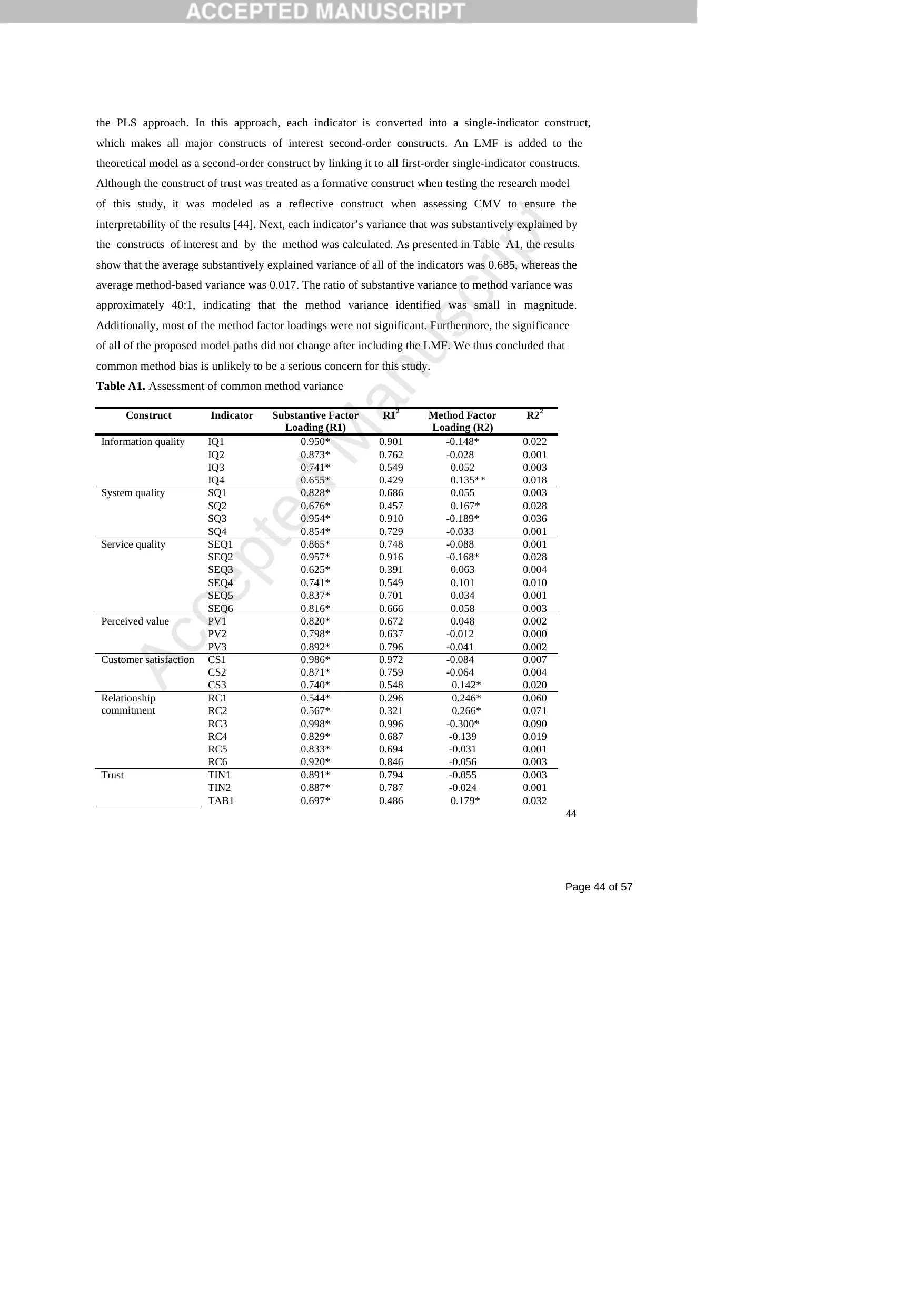
Page 44 of 57
Accepted Manuscript
44
the PLS approach. In this approach, each indicator is converted into a single-indicator construct,
which makes all major constructs of interest second-order constructs. An LMF is added to the
theoretical model as a second-order construct by linking it to all first-order single-indicator constructs.
Although the construct of trust was treated as a formative construct when testing the research model
of this study, it was modeled as a reflective construct when assessing CMV to ensure the
interpretability of the results [44]. Next, each indicator’s variance that was substantively explained by
the constructs of interest and by the method was calculated. As presented in Table A1, the results
show that the average substantively explained variance of all of the indicators was 0.685, whereas the
average method-based variance was 0.017. The ratio of substantive variance to method variance was
approximately 40:1, indicating that the method variance identified was small in magnitude.
Additionally, most of the method factor loadings were not significant. Furthermore, the significance
of all of the proposed model paths did not change after including the LMF. We thus concluded that
common method bias is unlikely to be a serious concern for this study.
Table A1. Assessment of common method variance
Construct Indicator Substantive Factor
Loading (R1)
R12 Method Factor
Loading (R2)
R22
IQ1 0.950* 0.901 -0.148* 0.022
IQ2 0.873* 0.762 -0.028 0.001
IQ3 0.741* 0.549 0.052 0.003
Information quality
IQ4 0.655* 0.429 0.135** 0.018
SQ1 0.828* 0.686 0.055 0.003
SQ2 0.676* 0.457 0.167* 0.028
SQ3 0.954* 0.910 -0.189* 0.036
System quality
SQ4 0.854* 0.729 -0.033 0.001
SEQ1 0.865* 0.748 -0.088 0.001
SEQ2 0.957* 0.916 -0.168* 0.028
SEQ3 0.625* 0.391 0.063 0.004
SEQ4 0.741* 0.549 0.101 0.010
SEQ5 0.837* 0.701 0.034 0.001
Service quality
SEQ6 0.816* 0.666 0.058 0.003
PV1 0.820* 0.672 0.048 0.002
PV2 0.798* 0.637 -0.012 0.000
Perceived value
PV3 0.892* 0.796 -0.041 0.002
CS1 0.986* 0.972 -0.084 0.007
CS2 0.871* 0.759 -0.064 0.004
Customer satisfaction
CS3 0.740* 0.548 0.142* 0.020
RC1 0.544* 0.296 0.246* 0.060
RC2 0.567* 0.321 0.266* 0.071
RC3 0.998* 0.996 -0.300* 0.090
RC4 0.829* 0.687 -0.139 0.019
RC5 0.833* 0.694 -0.031 0.001
Relationship
commitment
RC6 0.920* 0.846 -0.056 0.003
TIN1 0.891* 0.794 -0.055 0.003
TIN2 0.887* 0.787 -0.024 0.001
Trust
TAB1 0.697* 0.486 0.179* 0.032
Accepted Manuscript
44
the PLS approach. In this approach, each indicator is converted into a single-indicator construct,
which makes all major constructs of interest second-order constructs. An LMF is added to the
theoretical model as a second-order construct by linking it to all first-order single-indicator constructs.
Although the construct of trust was treated as a formative construct when testing the research model
of this study, it was modeled as a reflective construct when assessing CMV to ensure the
interpretability of the results [44]. Next, each indicator’s variance that was substantively explained by
the constructs of interest and by the method was calculated. As presented in Table A1, the results
show that the average substantively explained variance of all of the indicators was 0.685, whereas the
average method-based variance was 0.017. The ratio of substantive variance to method variance was
approximately 40:1, indicating that the method variance identified was small in magnitude.
Additionally, most of the method factor loadings were not significant. Furthermore, the significance
of all of the proposed model paths did not change after including the LMF. We thus concluded that
common method bias is unlikely to be a serious concern for this study.
Table A1. Assessment of common method variance
Construct Indicator Substantive Factor
Loading (R1)
R12 Method Factor
Loading (R2)
R22
IQ1 0.950* 0.901 -0.148* 0.022
IQ2 0.873* 0.762 -0.028 0.001
IQ3 0.741* 0.549 0.052 0.003
Information quality
IQ4 0.655* 0.429 0.135** 0.018
SQ1 0.828* 0.686 0.055 0.003
SQ2 0.676* 0.457 0.167* 0.028
SQ3 0.954* 0.910 -0.189* 0.036
System quality
SQ4 0.854* 0.729 -0.033 0.001
SEQ1 0.865* 0.748 -0.088 0.001
SEQ2 0.957* 0.916 -0.168* 0.028
SEQ3 0.625* 0.391 0.063 0.004
SEQ4 0.741* 0.549 0.101 0.010
SEQ5 0.837* 0.701 0.034 0.001
Service quality
SEQ6 0.816* 0.666 0.058 0.003
PV1 0.820* 0.672 0.048 0.002
PV2 0.798* 0.637 -0.012 0.000
Perceived value
PV3 0.892* 0.796 -0.041 0.002
CS1 0.986* 0.972 -0.084 0.007
CS2 0.871* 0.759 -0.064 0.004
Customer satisfaction
CS3 0.740* 0.548 0.142* 0.020
RC1 0.544* 0.296 0.246* 0.060
RC2 0.567* 0.321 0.266* 0.071
RC3 0.998* 0.996 -0.300* 0.090
RC4 0.829* 0.687 -0.139 0.019
RC5 0.833* 0.694 -0.031 0.001
Relationship
commitment
RC6 0.920* 0.846 -0.056 0.003
TIN1 0.891* 0.794 -0.055 0.003
TIN2 0.887* 0.787 -0.024 0.001
Trust
TAB1 0.697* 0.486 0.179* 0.032

Page 45 of 57
Accepted Manuscript
45
TAB2 0.753* 0.567 0.123 0.015
TBE1 0.801* 0.642 0.032 0.001
TBE2 0.868* 0.753 -0.202 0.041
TBE3 0.905* 0.819 -0.115 0.013
SI1 0.883* 0.780 -0.030 0.001
SI2 0.815* 0.664 0.118* 0.014
Stickiness intention
SI3 0.867* 0.752 -0.202* 0.041
Average
(by absolute value)
0.820 0.685 0.106 0.017
* p < .01; ** p < .05
Appendix D. Hierarchical Moderated Regression Analysis
The scales for measuring a specific construct in the research model were averaged to form a
composite to represent the construct. The potential threat of multicollinearity was checked by
examining whether the variance inflation factors (VIFs) of the constructs were smaller than the
recommended cutoff value of 10 [40]. As presented in Table A2, the VIFs of all regression models
were smaller than 10; thus, multicollinearity was not considered to be a problem. Comparing the R 2
of Model 1 to those of Models 2, 3, 4, 5, 6, 7, and 8 indicated that the exclusion of relationship
commitment from the regression model (see Model 7) significantly decreased the explained variance
of the stickiness intention. These results indicate that relationship commitment is the most important
determinant of consumers’ intentions to continue to use a particular GBW. Additionally, comparing
the R2 of Model 1 to those of Models 9, 10, 11, 12, 13, and 14, all of which had relationship
commitment excluded from the regression model, indicated that individually excluding customer
satisfaction and trust from the regression model (see Models 13 and 14) significantly decreased the
variance explained of the stickiness intention. These results suggest that, in addition to relationship
commitment, customer satisfaction and trust are key factors influencing consumers’ stickiness
intentions.
Accepted Manuscript
45
TAB2 0.753* 0.567 0.123 0.015
TBE1 0.801* 0.642 0.032 0.001
TBE2 0.868* 0.753 -0.202 0.041
TBE3 0.905* 0.819 -0.115 0.013
SI1 0.883* 0.780 -0.030 0.001
SI2 0.815* 0.664 0.118* 0.014
Stickiness intention
SI3 0.867* 0.752 -0.202* 0.041
Average
(by absolute value)
0.820 0.685 0.106 0.017
* p < .01; ** p < .05
Appendix D. Hierarchical Moderated Regression Analysis
The scales for measuring a specific construct in the research model were averaged to form a
composite to represent the construct. The potential threat of multicollinearity was checked by
examining whether the variance inflation factors (VIFs) of the constructs were smaller than the
recommended cutoff value of 10 [40]. As presented in Table A2, the VIFs of all regression models
were smaller than 10; thus, multicollinearity was not considered to be a problem. Comparing the R 2
of Model 1 to those of Models 2, 3, 4, 5, 6, 7, and 8 indicated that the exclusion of relationship
commitment from the regression model (see Model 7) significantly decreased the explained variance
of the stickiness intention. These results indicate that relationship commitment is the most important
determinant of consumers’ intentions to continue to use a particular GBW. Additionally, comparing
the R2 of Model 1 to those of Models 9, 10, 11, 12, 13, and 14, all of which had relationship
commitment excluded from the regression model, indicated that individually excluding customer
satisfaction and trust from the regression model (see Models 13 and 14) significantly decreased the
variance explained of the stickiness intention. These results suggest that, in addition to relationship
commitment, customer satisfaction and trust are key factors influencing consumers’ stickiness
intentions.
Secure Best Marks with AI Grader
Need help grading? Try our AI Grader for instant feedback on your assignments.
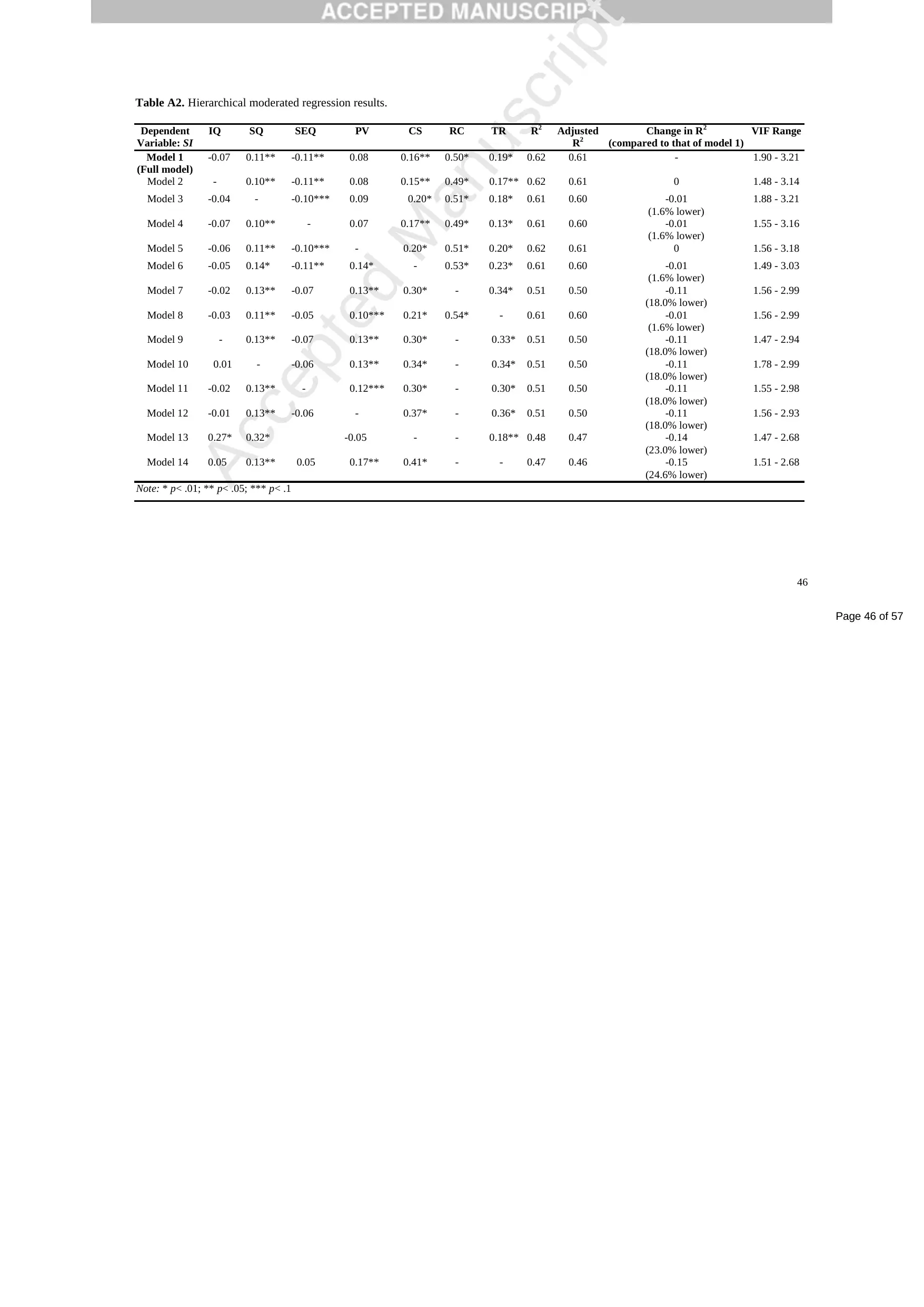
Page 46 of 57
Accepted Manuscript
46
Table A2. Hierarchical moderated regression results.
Dependent
Variable: SI
IQ SQ SEQ PV CS RC TR R2 Adjusted
R2
Change in R2
(compared to that of model 1)
VIF Range
Model 1
(Full model)
-0.07 0.11** -0.11** 0.08 0.16** 0.50* 0.19* 0.62 0.61 - 1.90 - 3.21
Model 2 - 0.10** -0.11** 0.08 0.15** 0.49* 0.17** 0.62 0.61 0 1.48 - 3.14
Model 3 -0.04 - -0.10*** 0.09 0.20* 0.51* 0.18* 0.61 0.60 -0.01
(1.6% lower)
1.88 - 3.21
Model 4 -0.07 0.10** - 0.07 0.17** 0.49* 0.13* 0.61 0.60 -0.01
(1.6% lower)
1.55 - 3.16
Model 5 -0.06 0.11** -0.10*** - 0.20* 0.51* 0.20* 0.62 0.61 0 1.56 - 3.18
Model 6 -0.05 0.14* -0.11** 0.14* - 0.53* 0.23* 0.61 0.60 -0.01
(1.6% lower)
1.49 - 3.03
Model 7 -0.02 0.13** -0.07 0.13** 0.30* - 0.34* 0.51 0.50 -0.11
(18.0% lower)
1.56 - 2.99
Model 8 -0.03 0.11** -0.05 0.10*** 0.21* 0.54* - 0.61 0.60 -0.01
(1.6% lower)
1.56 - 2.99
Model 9 - 0.13** -0.07 0.13** 0.30* - 0.33* 0.51 0.50 -0.11
(18.0% lower)
1.47 - 2.94
Model 10 0.01 - -0.06 0.13** 0.34* - 0.34* 0.51 0.50 -0.11
(18.0% lower)
1.78 - 2.99
Model 11 -0.02 0.13** - 0.12*** 0.30* - 0.30* 0.51 0.50 -0.11
(18.0% lower)
1.55 - 2.98
Model 12 -0.01 0.13** -0.06 - 0.37* - 0.36* 0.51 0.50 -0.11
(18.0% lower)
1.56 - 2.93
Model 13 0.27* 0.32* -0.05 - - 0.18** 0.48 0.47 -0.14
(23.0% lower)
1.47 - 2.68
Model 14 0.05 0.13** 0.05 0.17** 0.41* - - 0.47 0.46 -0.15
(24.6% lower)
1.51 - 2.68
Note: * p< .01; ** p< .05; *** p< .1
Accepted Manuscript
46
Table A2. Hierarchical moderated regression results.
Dependent
Variable: SI
IQ SQ SEQ PV CS RC TR R2 Adjusted
R2
Change in R2
(compared to that of model 1)
VIF Range
Model 1
(Full model)
-0.07 0.11** -0.11** 0.08 0.16** 0.50* 0.19* 0.62 0.61 - 1.90 - 3.21
Model 2 - 0.10** -0.11** 0.08 0.15** 0.49* 0.17** 0.62 0.61 0 1.48 - 3.14
Model 3 -0.04 - -0.10*** 0.09 0.20* 0.51* 0.18* 0.61 0.60 -0.01
(1.6% lower)
1.88 - 3.21
Model 4 -0.07 0.10** - 0.07 0.17** 0.49* 0.13* 0.61 0.60 -0.01
(1.6% lower)
1.55 - 3.16
Model 5 -0.06 0.11** -0.10*** - 0.20* 0.51* 0.20* 0.62 0.61 0 1.56 - 3.18
Model 6 -0.05 0.14* -0.11** 0.14* - 0.53* 0.23* 0.61 0.60 -0.01
(1.6% lower)
1.49 - 3.03
Model 7 -0.02 0.13** -0.07 0.13** 0.30* - 0.34* 0.51 0.50 -0.11
(18.0% lower)
1.56 - 2.99
Model 8 -0.03 0.11** -0.05 0.10*** 0.21* 0.54* - 0.61 0.60 -0.01
(1.6% lower)
1.56 - 2.99
Model 9 - 0.13** -0.07 0.13** 0.30* - 0.33* 0.51 0.50 -0.11
(18.0% lower)
1.47 - 2.94
Model 10 0.01 - -0.06 0.13** 0.34* - 0.34* 0.51 0.50 -0.11
(18.0% lower)
1.78 - 2.99
Model 11 -0.02 0.13** - 0.12*** 0.30* - 0.30* 0.51 0.50 -0.11
(18.0% lower)
1.55 - 2.98
Model 12 -0.01 0.13** -0.06 - 0.37* - 0.36* 0.51 0.50 -0.11
(18.0% lower)
1.56 - 2.93
Model 13 0.27* 0.32* -0.05 - - 0.18** 0.48 0.47 -0.14
(23.0% lower)
1.47 - 2.68
Model 14 0.05 0.13** 0.05 0.17** 0.41* - - 0.47 0.46 -0.15
(24.6% lower)
1.51 - 2.68
Note: * p< .01; ** p< .05; *** p< .1

Page 47 of 57
Accepted Manuscript
47
ACKNOWLEDGMENTS
The authors thank the Editor, the Associate Editor, and the anonymous reviewers for their valuable
feedback on this paper. The authors also thank the administrators of the online forums and websites
studied for their support and the survey respondents for providing valuable data. This research was funded
by Ministry of Science and Technology, Taiwan [grant number: MOST 103-2410-H-006-043].
References
[1] N.F. Awad, A. Ragowsky, Establishing trust in electronic commerce through online word of mouth:
An examination across genders, Journal of Management Information Systems 24(4) (2008) 101-121.
[2] N. Amblee, T. Bui, Harnessing the influence of social proof in online shopping: The effect of
electronic word of mouth on sales of digital microproducts, International Journal of Electronic
Commerce 16(2) (2011) 91-113.
[3] K. Anand, R. Aron, Group-buying on the web: A comparison of price-discovery mechanisms,
Management Science 49(11) (2003) 1546-1562.
[4] R.E. Anderson, S.S. Srinivasan, E-satisfaction and e-loyalty: A contingency framework, Psychology
and Marketing 20(2) (2003) 123-138.
[5] Anonym, (in Chinese). TechOrange
(2011). http://techorange.com/2011/08/02/group-buy-women-age-social-media/. Accessed
March 25th, 2013.
[6] R.P. Bagozzi, The self-regulation of attitudes, intentions, and behavior, Social Psychology Quarterly
55(2) (1992) 178-204.
[7] S.E. Beatty, L.R. Kahle, Alternative hierarchies of the attitude-behavior relationship: The impact of
brand commitment and habit, Journal of the Academy of Marketing Science 16(2) (1988) 1-10.
[8] B. Beersma, C.K.W.de Dreu, Integrative and distributive negotiation in small groups: Effects of
task structure, decision rules, and social motive, Organizational Behavior and Human Decision
Processes 87(2) (2002) 227-252.
[9] S. J. Bell, S. Auh, K. Smalley, Customer relationship dynamics: Service quality and customer
loyalty in the context of varying levels of customer expertise and switching costs, Journal of the
Academy of Marketing Science 33(2) (2005) 169-183.
[10] A. Bhattacherjee, Individual trust in online firms: Scale development and initial test, Journal of
Accepted Manuscript
47
ACKNOWLEDGMENTS
The authors thank the Editor, the Associate Editor, and the anonymous reviewers for their valuable
feedback on this paper. The authors also thank the administrators of the online forums and websites
studied for their support and the survey respondents for providing valuable data. This research was funded
by Ministry of Science and Technology, Taiwan [grant number: MOST 103-2410-H-006-043].
References
[1] N.F. Awad, A. Ragowsky, Establishing trust in electronic commerce through online word of mouth:
An examination across genders, Journal of Management Information Systems 24(4) (2008) 101-121.
[2] N. Amblee, T. Bui, Harnessing the influence of social proof in online shopping: The effect of
electronic word of mouth on sales of digital microproducts, International Journal of Electronic
Commerce 16(2) (2011) 91-113.
[3] K. Anand, R. Aron, Group-buying on the web: A comparison of price-discovery mechanisms,
Management Science 49(11) (2003) 1546-1562.
[4] R.E. Anderson, S.S. Srinivasan, E-satisfaction and e-loyalty: A contingency framework, Psychology
and Marketing 20(2) (2003) 123-138.
[5] Anonym, (in Chinese). TechOrange
(2011). http://techorange.com/2011/08/02/group-buy-women-age-social-media/. Accessed
March 25th, 2013.
[6] R.P. Bagozzi, The self-regulation of attitudes, intentions, and behavior, Social Psychology Quarterly
55(2) (1992) 178-204.
[7] S.E. Beatty, L.R. Kahle, Alternative hierarchies of the attitude-behavior relationship: The impact of
brand commitment and habit, Journal of the Academy of Marketing Science 16(2) (1988) 1-10.
[8] B. Beersma, C.K.W.de Dreu, Integrative and distributive negotiation in small groups: Effects of
task structure, decision rules, and social motive, Organizational Behavior and Human Decision
Processes 87(2) (2002) 227-252.
[9] S. J. Bell, S. Auh, K. Smalley, Customer relationship dynamics: Service quality and customer
loyalty in the context of varying levels of customer expertise and switching costs, Journal of the
Academy of Marketing Science 33(2) (2005) 169-183.
[10] A. Bhattacherjee, Individual trust in online firms: Scale development and initial test, Journal of
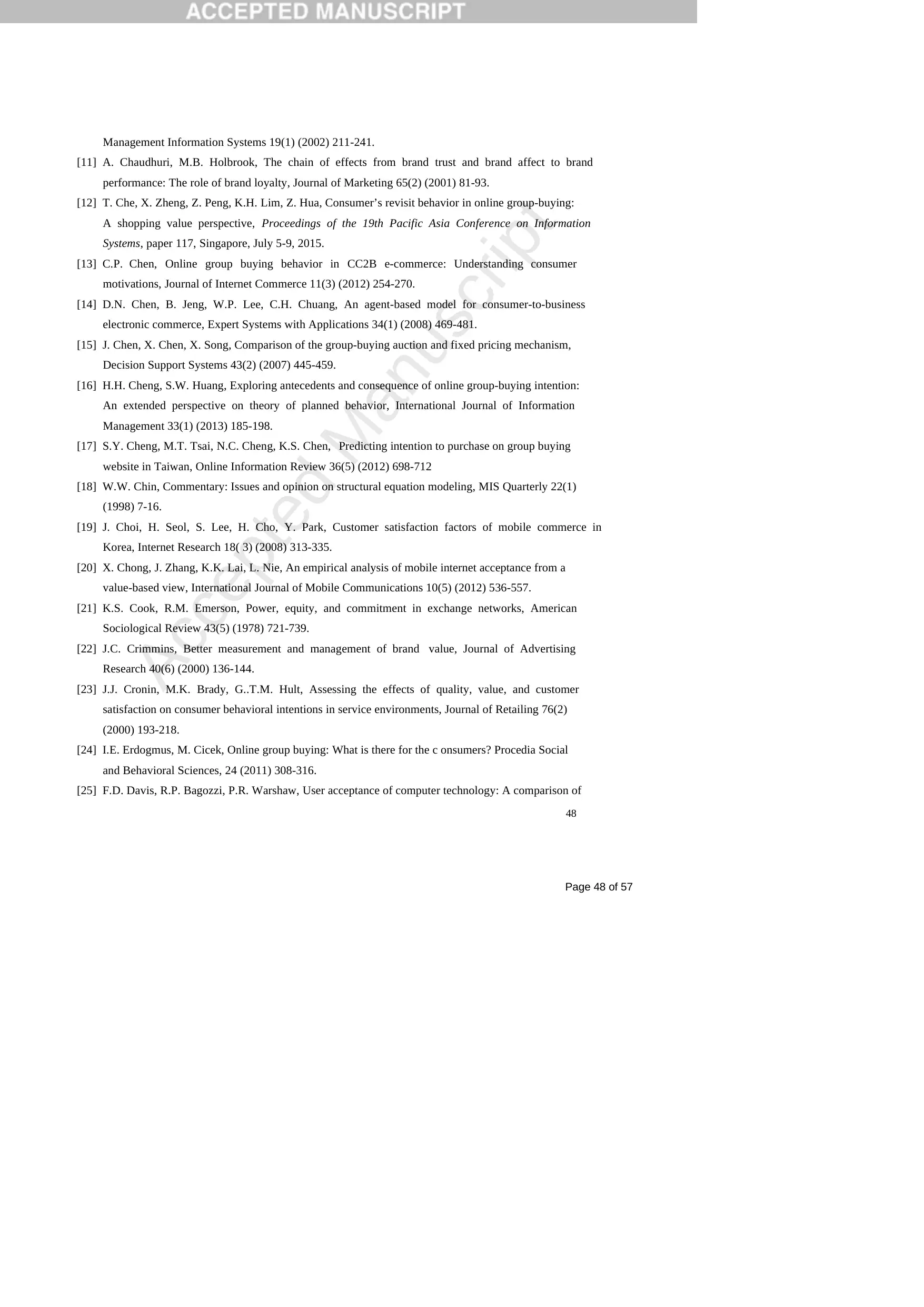
Page 48 of 57
Accepted Manuscript
48
Management Information Systems 19(1) (2002) 211-241.
[11] A. Chaudhuri, M.B. Holbrook, The chain of effects from brand trust and brand affect to brand
performance: The role of brand loyalty, Journal of Marketing 65(2) (2001) 81-93.
[12] T. Che, X. Zheng, Z. Peng, K.H. Lim, Z. Hua, Consumer’s revisit behavior in online group-buying:
A shopping value perspective, Proceedings of the 19th Pacific Asia Conference on Information
Systems, paper 117, Singapore, July 5-9, 2015.
[13] C.P. Chen, Online group buying behavior in CC2B e-commerce: Understanding consumer
motivations, Journal of Internet Commerce 11(3) (2012) 254-270.
[14] D.N. Chen, B. Jeng, W.P. Lee, C.H. Chuang, An agent-based model for consumer-to-business
electronic commerce, Expert Systems with Applications 34(1) (2008) 469-481.
[15] J. Chen, X. Chen, X. Song, Comparison of the group-buying auction and fixed pricing mechanism,
Decision Support Systems 43(2) (2007) 445-459.
[16] H.H. Cheng, S.W. Huang, Exploring antecedents and consequence of online group-buying intention:
An extended perspective on theory of planned behavior, International Journal of Information
Management 33(1) (2013) 185-198.
[17] S.Y. Cheng, M.T. Tsai, N.C. Cheng, K.S. Chen, Predicting intention to purchase on group buying
website in Taiwan, Online Information Review 36(5) (2012) 698-712
[18] W.W. Chin, Commentary: Issues and opinion on structural equation modeling, MIS Quarterly 22(1)
(1998) 7-16.
[19] J. Choi, H. Seol, S. Lee, H. Cho, Y. Park, Customer satisfaction factors of mobile commerce in
Korea, Internet Research 18( 3) (2008) 313-335.
[20] X. Chong, J. Zhang, K.K. Lai, L. Nie, An empirical analysis of mobile internet acceptance from a
value-based view, International Journal of Mobile Communications 10(5) (2012) 536-557.
[21] K.S. Cook, R.M. Emerson, Power, equity, and commitment in exchange networks, American
Sociological Review 43(5) (1978) 721-739.
[22] J.C. Crimmins, Better measurement and management of brand value, Journal of Advertising
Research 40(6) (2000) 136-144.
[23] J.J. Cronin, M.K. Brady, G..T.M. Hult, Assessing the effects of quality, value, and customer
satisfaction on consumer behavioral intentions in service environments, Journal of Retailing 76(2)
(2000) 193-218.
[24] I.E. Erdogmus, M. Cicek, Online group buying: What is there for the c onsumers? Procedia Social
and Behavioral Sciences, 24 (2011) 308-316.
[25] F.D. Davis, R.P. Bagozzi, P.R. Warshaw, User acceptance of computer technology: A comparison of
Accepted Manuscript
48
Management Information Systems 19(1) (2002) 211-241.
[11] A. Chaudhuri, M.B. Holbrook, The chain of effects from brand trust and brand affect to brand
performance: The role of brand loyalty, Journal of Marketing 65(2) (2001) 81-93.
[12] T. Che, X. Zheng, Z. Peng, K.H. Lim, Z. Hua, Consumer’s revisit behavior in online group-buying:
A shopping value perspective, Proceedings of the 19th Pacific Asia Conference on Information
Systems, paper 117, Singapore, July 5-9, 2015.
[13] C.P. Chen, Online group buying behavior in CC2B e-commerce: Understanding consumer
motivations, Journal of Internet Commerce 11(3) (2012) 254-270.
[14] D.N. Chen, B. Jeng, W.P. Lee, C.H. Chuang, An agent-based model for consumer-to-business
electronic commerce, Expert Systems with Applications 34(1) (2008) 469-481.
[15] J. Chen, X. Chen, X. Song, Comparison of the group-buying auction and fixed pricing mechanism,
Decision Support Systems 43(2) (2007) 445-459.
[16] H.H. Cheng, S.W. Huang, Exploring antecedents and consequence of online group-buying intention:
An extended perspective on theory of planned behavior, International Journal of Information
Management 33(1) (2013) 185-198.
[17] S.Y. Cheng, M.T. Tsai, N.C. Cheng, K.S. Chen, Predicting intention to purchase on group buying
website in Taiwan, Online Information Review 36(5) (2012) 698-712
[18] W.W. Chin, Commentary: Issues and opinion on structural equation modeling, MIS Quarterly 22(1)
(1998) 7-16.
[19] J. Choi, H. Seol, S. Lee, H. Cho, Y. Park, Customer satisfaction factors of mobile commerce in
Korea, Internet Research 18( 3) (2008) 313-335.
[20] X. Chong, J. Zhang, K.K. Lai, L. Nie, An empirical analysis of mobile internet acceptance from a
value-based view, International Journal of Mobile Communications 10(5) (2012) 536-557.
[21] K.S. Cook, R.M. Emerson, Power, equity, and commitment in exchange networks, American
Sociological Review 43(5) (1978) 721-739.
[22] J.C. Crimmins, Better measurement and management of brand value, Journal of Advertising
Research 40(6) (2000) 136-144.
[23] J.J. Cronin, M.K. Brady, G..T.M. Hult, Assessing the effects of quality, value, and customer
satisfaction on consumer behavioral intentions in service environments, Journal of Retailing 76(2)
(2000) 193-218.
[24] I.E. Erdogmus, M. Cicek, Online group buying: What is there for the c onsumers? Procedia Social
and Behavioral Sciences, 24 (2011) 308-316.
[25] F.D. Davis, R.P. Bagozzi, P.R. Warshaw, User acceptance of computer technology: A comparison of
Paraphrase This Document
Need a fresh take? Get an instant paraphrase of this document with our AI Paraphraser
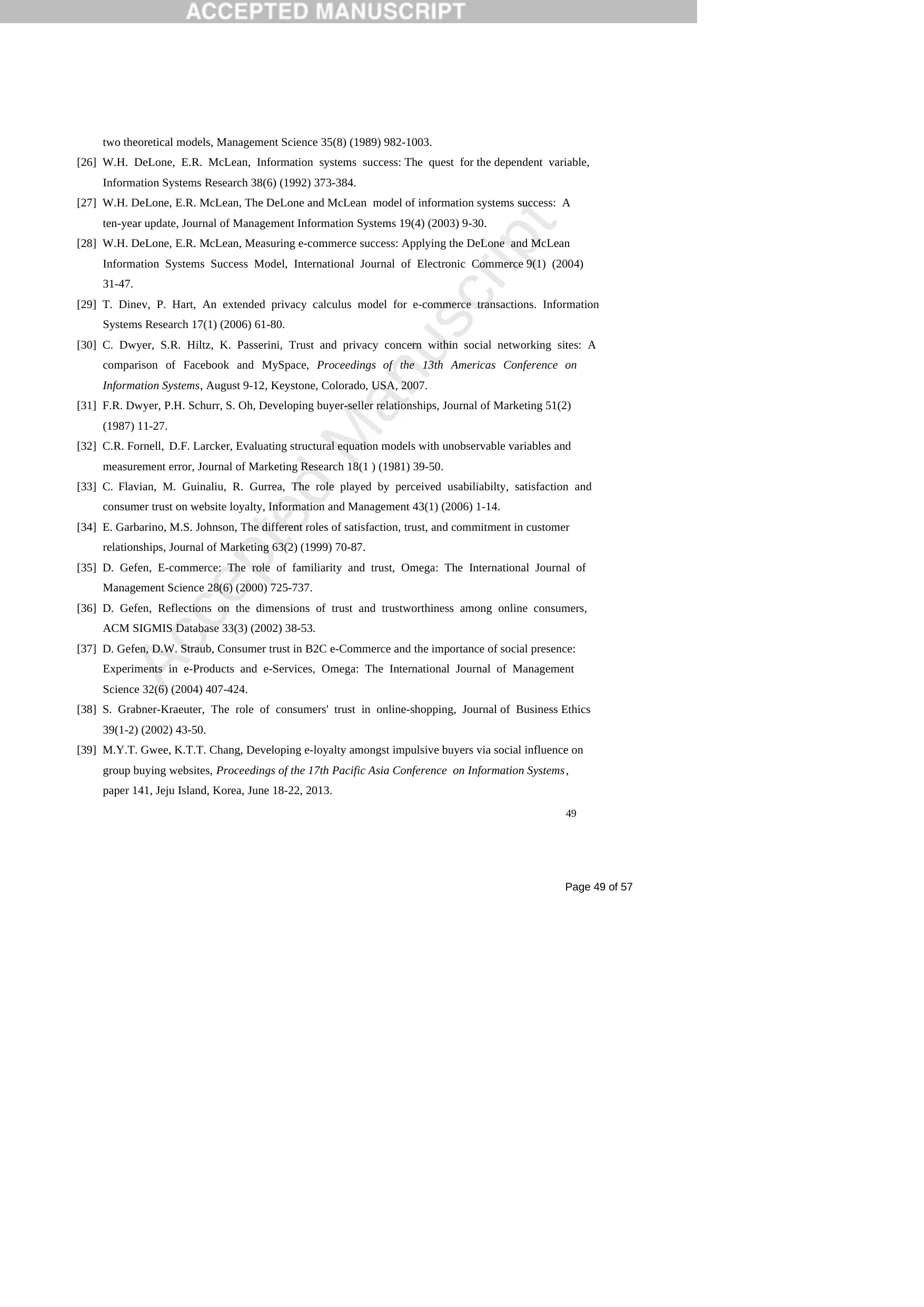
Page 49 of 57
Accepted Manuscript
49
two theoretical models, Management Science 35(8) (1989) 982-1003.
[26] W.H. DeLone, E.R. McLean, Information systems success: The quest for the dependent variable,
Information Systems Research 38(6) (1992) 373-384.
[27] W.H. DeLone, E.R. McLean, The DeLone and McLean model of information systems success: A
ten-year update, Journal of Management Information Systems 19(4) (2003) 9-30.
[28] W.H. DeLone, E.R. McLean, Measuring e-commerce success: Applying the DeLone and McLean
Information Systems Success Model, International Journal of Electronic Commerce 9(1) (2004)
31-47.
[29] T. Dinev, P. Hart, An extended privacy calculus model for e-commerce transactions. Information
Systems Research 17(1) (2006) 61-80.
[30] C. Dwyer, S.R. Hiltz, K. Passerini, Trust and privacy concern within social networking sites: A
comparison of Facebook and MySpace, Proceedings of the 13th Americas Conference on
Information Systems, August 9-12, Keystone, Colorado, USA, 2007.
[31] F.R. Dwyer, P.H. Schurr, S. Oh, Developing buyer-seller relationships, Journal of Marketing 51(2)
(1987) 11-27.
[32] C.R. Fornell, D.F. Larcker, Evaluating structural equation models with unobservable variables and
measurement error, Journal of Marketing Research 18(1 ) (1981) 39-50.
[33] C. Flavian, M. Guinaliu, R. Gurrea, The role played by perceived usabiliabilty, satisfaction and
consumer trust on website loyalty, Information and Management 43(1) (2006) 1-14.
[34] E. Garbarino, M.S. Johnson, The different roles of satisfaction, trust, and commitment in customer
relationships, Journal of Marketing 63(2) (1999) 70-87.
[35] D. Gefen, E-commerce: The role of familiarity and trust, Omega: The International Journal of
Management Science 28(6) (2000) 725-737.
[36] D. Gefen, Reflections on the dimensions of trust and trustworthiness among online consumers,
ACM SIGMIS Database 33(3) (2002) 38-53.
[37] D. Gefen, D.W. Straub, Consumer trust in B2C e-Commerce and the importance of social presence:
Experiments in e-Products and e-Services, Omega: The International Journal of Management
Science 32(6) (2004) 407-424.
[38] S. Grabner-Kraeuter, The role of consumers' trust in online-shopping, Journal of Business Ethics
39(1-2) (2002) 43-50.
[39] M.Y.T. Gwee, K.T.T. Chang, Developing e-loyalty amongst impulsive buyers via social influence on
group buying websites, Proceedings of the 17th Pacific Asia Conference on Information Systems,
paper 141, Jeju Island, Korea, June 18-22, 2013.
Accepted Manuscript
49
two theoretical models, Management Science 35(8) (1989) 982-1003.
[26] W.H. DeLone, E.R. McLean, Information systems success: The quest for the dependent variable,
Information Systems Research 38(6) (1992) 373-384.
[27] W.H. DeLone, E.R. McLean, The DeLone and McLean model of information systems success: A
ten-year update, Journal of Management Information Systems 19(4) (2003) 9-30.
[28] W.H. DeLone, E.R. McLean, Measuring e-commerce success: Applying the DeLone and McLean
Information Systems Success Model, International Journal of Electronic Commerce 9(1) (2004)
31-47.
[29] T. Dinev, P. Hart, An extended privacy calculus model for e-commerce transactions. Information
Systems Research 17(1) (2006) 61-80.
[30] C. Dwyer, S.R. Hiltz, K. Passerini, Trust and privacy concern within social networking sites: A
comparison of Facebook and MySpace, Proceedings of the 13th Americas Conference on
Information Systems, August 9-12, Keystone, Colorado, USA, 2007.
[31] F.R. Dwyer, P.H. Schurr, S. Oh, Developing buyer-seller relationships, Journal of Marketing 51(2)
(1987) 11-27.
[32] C.R. Fornell, D.F. Larcker, Evaluating structural equation models with unobservable variables and
measurement error, Journal of Marketing Research 18(1 ) (1981) 39-50.
[33] C. Flavian, M. Guinaliu, R. Gurrea, The role played by perceived usabiliabilty, satisfaction and
consumer trust on website loyalty, Information and Management 43(1) (2006) 1-14.
[34] E. Garbarino, M.S. Johnson, The different roles of satisfaction, trust, and commitment in customer
relationships, Journal of Marketing 63(2) (1999) 70-87.
[35] D. Gefen, E-commerce: The role of familiarity and trust, Omega: The International Journal of
Management Science 28(6) (2000) 725-737.
[36] D. Gefen, Reflections on the dimensions of trust and trustworthiness among online consumers,
ACM SIGMIS Database 33(3) (2002) 38-53.
[37] D. Gefen, D.W. Straub, Consumer trust in B2C e-Commerce and the importance of social presence:
Experiments in e-Products and e-Services, Omega: The International Journal of Management
Science 32(6) (2004) 407-424.
[38] S. Grabner-Kraeuter, The role of consumers' trust in online-shopping, Journal of Business Ethics
39(1-2) (2002) 43-50.
[39] M.Y.T. Gwee, K.T.T. Chang, Developing e-loyalty amongst impulsive buyers via social influence on
group buying websites, Proceedings of the 17th Pacific Asia Conference on Information Systems,
paper 141, Jeju Island, Korea, June 18-22, 2013.
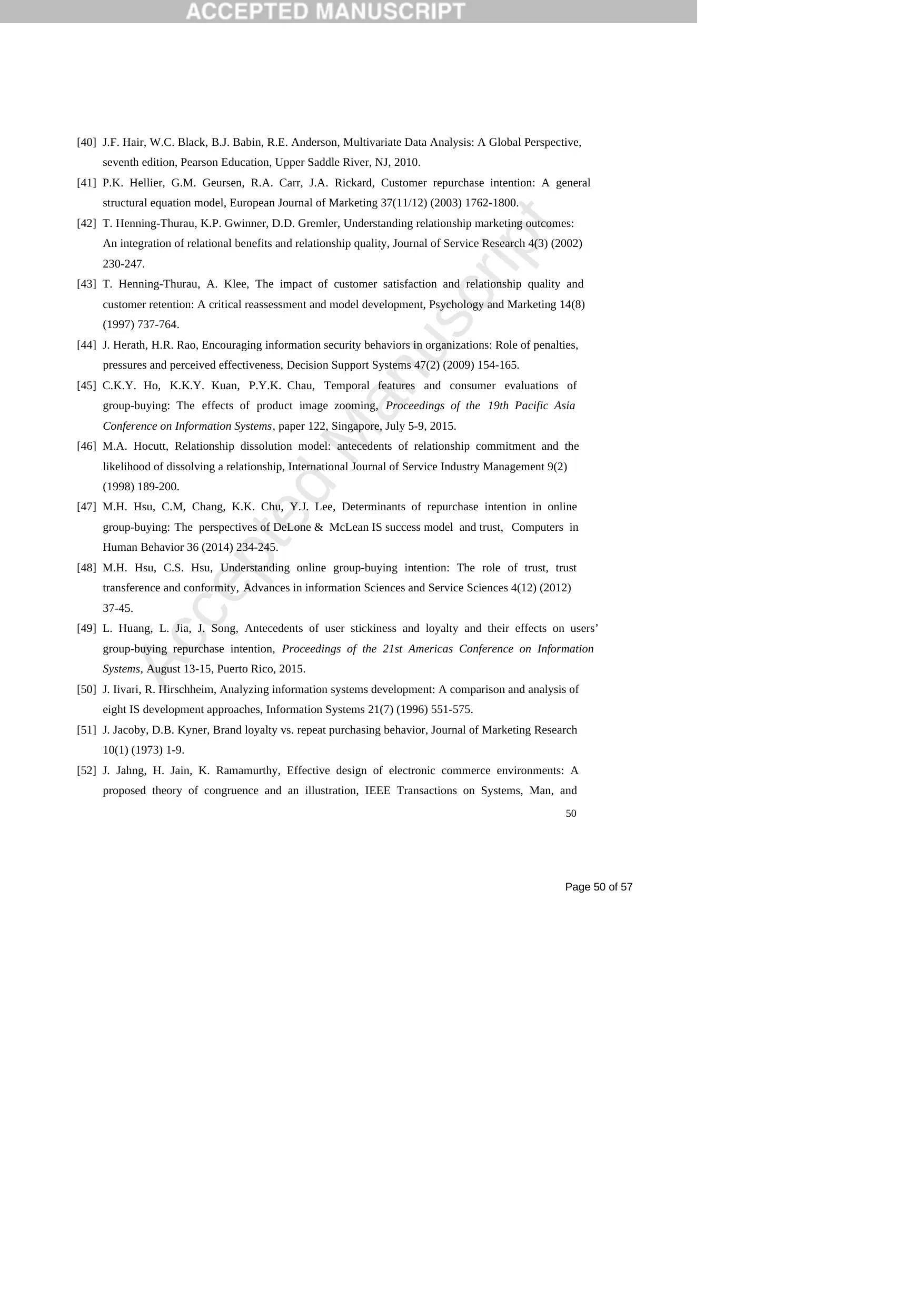
Page 50 of 57
Accepted Manuscript
50
[40] J.F. Hair, W.C. Black, B.J. Babin, R.E. Anderson, Multivariate Data Analysis: A Global Perspective,
seventh edition, Pearson Education, Upper Saddle River, NJ, 2010.
[41] P.K. Hellier, G.M. Geursen, R.A. Carr, J.A. Rickard, Customer repurchase intention: A general
structural equation model, European Journal of Marketing 37(11/12) (2003) 1762-1800.
[42] T. Henning-Thurau, K.P. Gwinner, D.D. Gremler, Understanding relationship marketing outcomes:
An integration of relational benefits and relationship quality, Journal of Service Research 4(3) (2002)
230-247.
[43] T. Henning-Thurau, A. Klee, The impact of customer satisfaction and relationship quality and
customer retention: A critical reassessment and model development, Psychology and Marketing 14(8)
(1997) 737-764.
[44] J. Herath, H.R. Rao, Encouraging information security behaviors in organizations: Role of penalties,
pressures and perceived effectiveness, Decision Support Systems 47(2) (2009) 154-165.
[45] C.K.Y. Ho, K.K.Y. Kuan, P.Y.K. Chau, Temporal features and consumer evaluations of
group-buying: The effects of product image zooming, Proceedings of the 19th Pacific Asia
Conference on Information Systems, paper 122, Singapore, July 5-9, 2015.
[46] M.A. Hocutt, Relationship dissolution model: antecedents of relationship commitment and the
likelihood of dissolving a relationship, International Journal of Service Industry Management 9(2)
(1998) 189-200.
[47] M.H. Hsu, C.M, Chang, K.K. Chu, Y.J. Lee, Determinants of repurchase intention in online
group-buying: The perspectives of DeLone & McLean IS success model and trust, Computers in
Human Behavior 36 (2014) 234-245.
[48] M.H. Hsu, C.S. Hsu, Understanding online group-buying intention: The role of trust, trust
transference and conformity, Advances in information Sciences and Service Sciences 4(12) (2012)
37-45.
[49] L. Huang, L. Jia, J. Song, Antecedents of user stickiness and loyalty and their effects on users’
group-buying repurchase intention, Proceedings of the 21st Americas Conference on Information
Systems, August 13-15, Puerto Rico, 2015.
[50] J. Iivari, R. Hirschheim, Analyzing information systems development: A comparison and analysis of
eight IS development approaches, Information Systems 21(7) (1996) 551-575.
[51] J. Jacoby, D.B. Kyner, Brand loyalty vs. repeat purchasing behavior, Journal of Marketing Research
10(1) (1973) 1-9.
[52] J. Jahng, H. Jain, K. Ramamurthy, Effective design of electronic commerce environments: A
proposed theory of congruence and an illustration, IEEE Transactions on Systems, Man, and
Accepted Manuscript
50
[40] J.F. Hair, W.C. Black, B.J. Babin, R.E. Anderson, Multivariate Data Analysis: A Global Perspective,
seventh edition, Pearson Education, Upper Saddle River, NJ, 2010.
[41] P.K. Hellier, G.M. Geursen, R.A. Carr, J.A. Rickard, Customer repurchase intention: A general
structural equation model, European Journal of Marketing 37(11/12) (2003) 1762-1800.
[42] T. Henning-Thurau, K.P. Gwinner, D.D. Gremler, Understanding relationship marketing outcomes:
An integration of relational benefits and relationship quality, Journal of Service Research 4(3) (2002)
230-247.
[43] T. Henning-Thurau, A. Klee, The impact of customer satisfaction and relationship quality and
customer retention: A critical reassessment and model development, Psychology and Marketing 14(8)
(1997) 737-764.
[44] J. Herath, H.R. Rao, Encouraging information security behaviors in organizations: Role of penalties,
pressures and perceived effectiveness, Decision Support Systems 47(2) (2009) 154-165.
[45] C.K.Y. Ho, K.K.Y. Kuan, P.Y.K. Chau, Temporal features and consumer evaluations of
group-buying: The effects of product image zooming, Proceedings of the 19th Pacific Asia
Conference on Information Systems, paper 122, Singapore, July 5-9, 2015.
[46] M.A. Hocutt, Relationship dissolution model: antecedents of relationship commitment and the
likelihood of dissolving a relationship, International Journal of Service Industry Management 9(2)
(1998) 189-200.
[47] M.H. Hsu, C.M, Chang, K.K. Chu, Y.J. Lee, Determinants of repurchase intention in online
group-buying: The perspectives of DeLone & McLean IS success model and trust, Computers in
Human Behavior 36 (2014) 234-245.
[48] M.H. Hsu, C.S. Hsu, Understanding online group-buying intention: The role of trust, trust
transference and conformity, Advances in information Sciences and Service Sciences 4(12) (2012)
37-45.
[49] L. Huang, L. Jia, J. Song, Antecedents of user stickiness and loyalty and their effects on users’
group-buying repurchase intention, Proceedings of the 21st Americas Conference on Information
Systems, August 13-15, Puerto Rico, 2015.
[50] J. Iivari, R. Hirschheim, Analyzing information systems development: A comparison and analysis of
eight IS development approaches, Information Systems 21(7) (1996) 551-575.
[51] J. Jacoby, D.B. Kyner, Brand loyalty vs. repeat purchasing behavior, Journal of Marketing Research
10(1) (1973) 1-9.
[52] J. Jahng, H. Jain, K. Ramamurthy, Effective design of electronic commerce environments: A
proposed theory of congruence and an illustration, IEEE Transactions on Systems, Man, and
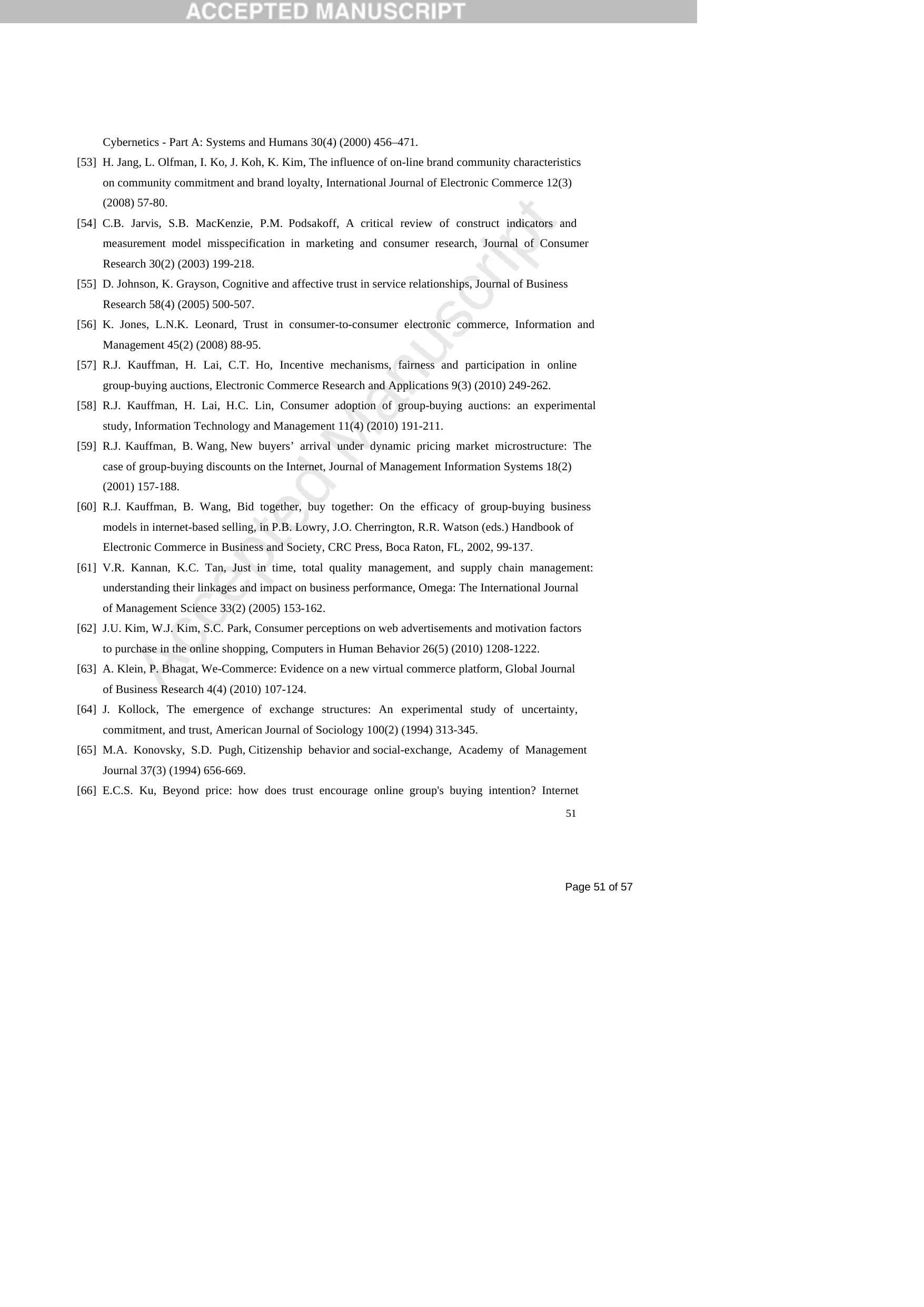
Page 51 of 57
Accepted Manuscript
51
Cybernetics - Part A: Systems and Humans 30(4) (2000) 456–471.
[53] H. Jang, L. Olfman, I. Ko, J. Koh, K. Kim, The influence of on-line brand community characteristics
on community commitment and brand loyalty, International Journal of Electronic Commerce 12(3)
(2008) 57-80.
[54] C.B. Jarvis, S.B. MacKenzie, P.M. Podsakoff, A critical review of construct indicators and
measurement model misspecification in marketing and consumer research, Journal of Consumer
Research 30(2) (2003) 199-218.
[55] D. Johnson, K. Grayson, Cognitive and affective trust in service relationships, Journal of Business
Research 58(4) (2005) 500-507.
[56] K. Jones, L.N.K. Leonard, Trust in consumer-to-consumer electronic commerce, Information and
Management 45(2) (2008) 88-95.
[57] R.J. Kauffman, H. Lai, C.T. Ho, Incentive mechanisms, fairness and participation in online
group-buying auctions, Electronic Commerce Research and Applications 9(3) (2010) 249-262.
[58] R.J. Kauffman, H. Lai, H.C. Lin, Consumer adoption of group-buying auctions: an experimental
study, Information Technology and Management 11(4) (2010) 191-211.
[59] R.J. Kauffman, B. Wang, New buyers’ arrival under dynamic pricing market microstructure: The
case of group-buying discounts on the Internet, Journal of Management Information Systems 18(2)
(2001) 157-188.
[60] R.J. Kauffman, B. Wang, Bid together, buy together: On the efficacy of group-buying business
models in internet-based selling, in P.B. Lowry, J.O. Cherrington, R.R. Watson (eds.) Handbook of
Electronic Commerce in Business and Society, CRC Press, Boca Raton, FL, 2002, 99-137.
[61] V.R. Kannan, K.C. Tan, Just in time, total quality management, and supply chain management:
understanding their linkages and impact on business performance, Omega: The International Journal
of Management Science 33(2) (2005) 153-162.
[62] J.U. Kim, W.J. Kim, S.C. Park, Consumer perceptions on web advertisements and motivation factors
to purchase in the online shopping, Computers in Human Behavior 26(5) (2010) 1208-1222.
[63] A. Klein, P. Bhagat, We-Commerce: Evidence on a new virtual commerce platform, Global Journal
of Business Research 4(4) (2010) 107-124.
[64] J. Kollock, The emergence of exchange structures: An experimental study of uncertainty,
commitment, and trust, American Journal of Sociology 100(2) (1994) 313-345.
[65] M.A. Konovsky, S.D. Pugh, Citizenship behavior and social-exchange, Academy of Management
Journal 37(3) (1994) 656-669.
[66] E.C.S. Ku, Beyond price: how does trust encourage online group's buying intention? Internet
Accepted Manuscript
51
Cybernetics - Part A: Systems and Humans 30(4) (2000) 456–471.
[53] H. Jang, L. Olfman, I. Ko, J. Koh, K. Kim, The influence of on-line brand community characteristics
on community commitment and brand loyalty, International Journal of Electronic Commerce 12(3)
(2008) 57-80.
[54] C.B. Jarvis, S.B. MacKenzie, P.M. Podsakoff, A critical review of construct indicators and
measurement model misspecification in marketing and consumer research, Journal of Consumer
Research 30(2) (2003) 199-218.
[55] D. Johnson, K. Grayson, Cognitive and affective trust in service relationships, Journal of Business
Research 58(4) (2005) 500-507.
[56] K. Jones, L.N.K. Leonard, Trust in consumer-to-consumer electronic commerce, Information and
Management 45(2) (2008) 88-95.
[57] R.J. Kauffman, H. Lai, C.T. Ho, Incentive mechanisms, fairness and participation in online
group-buying auctions, Electronic Commerce Research and Applications 9(3) (2010) 249-262.
[58] R.J. Kauffman, H. Lai, H.C. Lin, Consumer adoption of group-buying auctions: an experimental
study, Information Technology and Management 11(4) (2010) 191-211.
[59] R.J. Kauffman, B. Wang, New buyers’ arrival under dynamic pricing market microstructure: The
case of group-buying discounts on the Internet, Journal of Management Information Systems 18(2)
(2001) 157-188.
[60] R.J. Kauffman, B. Wang, Bid together, buy together: On the efficacy of group-buying business
models in internet-based selling, in P.B. Lowry, J.O. Cherrington, R.R. Watson (eds.) Handbook of
Electronic Commerce in Business and Society, CRC Press, Boca Raton, FL, 2002, 99-137.
[61] V.R. Kannan, K.C. Tan, Just in time, total quality management, and supply chain management:
understanding their linkages and impact on business performance, Omega: The International Journal
of Management Science 33(2) (2005) 153-162.
[62] J.U. Kim, W.J. Kim, S.C. Park, Consumer perceptions on web advertisements and motivation factors
to purchase in the online shopping, Computers in Human Behavior 26(5) (2010) 1208-1222.
[63] A. Klein, P. Bhagat, We-Commerce: Evidence on a new virtual commerce platform, Global Journal
of Business Research 4(4) (2010) 107-124.
[64] J. Kollock, The emergence of exchange structures: An experimental study of uncertainty,
commitment, and trust, American Journal of Sociology 100(2) (1994) 313-345.
[65] M.A. Konovsky, S.D. Pugh, Citizenship behavior and social-exchange, Academy of Management
Journal 37(3) (1994) 656-669.
[66] E.C.S. Ku, Beyond price: how does trust encourage online group's buying intention? Internet
Secure Best Marks with AI Grader
Need help grading? Try our AI Grader for instant feedback on your assignments.
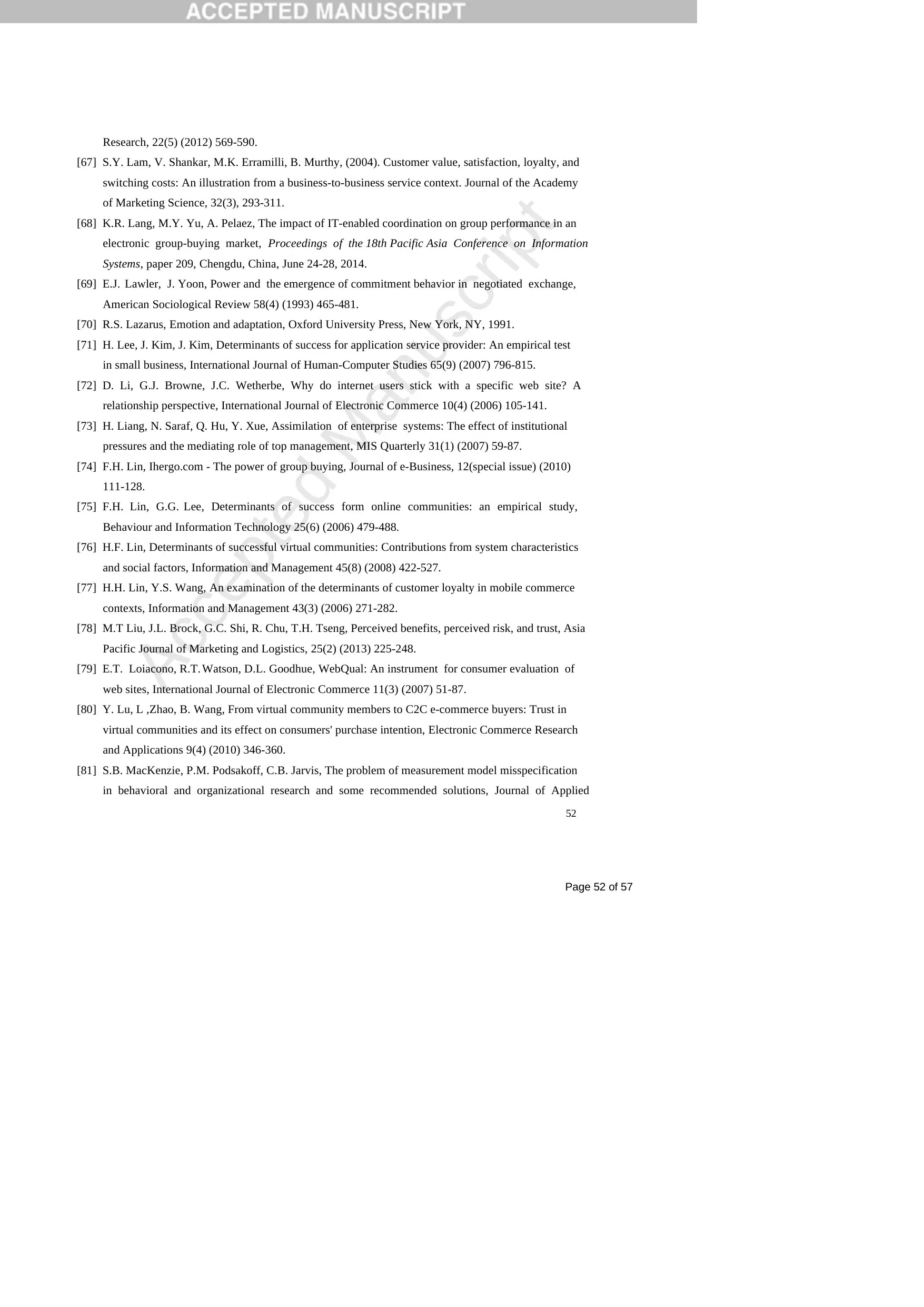
Page 52 of 57
Accepted Manuscript
52
Research, 22(5) (2012) 569-590.
[67] S.Y. Lam, V. Shankar, M.K. Erramilli, B. Murthy, (2004). Customer value, satisfaction, loyalty, and
switching costs: An illustration from a business-to-business service context. Journal of the Academy
of Marketing Science, 32(3), 293-311.
[68] K.R. Lang, M.Y. Yu, A. Pelaez, The impact of IT-enabled coordination on group performance in an
electronic group-buying market, Proceedings of the 18th Pacific Asia Conference on Information
Systems, paper 209, Chengdu, China, June 24-28, 2014.
[69] E.J. Lawler, J. Yoon, Power and the emergence of commitment behavior in negotiated exchange,
American Sociological Review 58(4) (1993) 465-481.
[70] R.S. Lazarus, Emotion and adaptation, Oxford University Press, New York, NY, 1991.
[71] H. Lee, J. Kim, J. Kim, Determinants of success for application service provider: An empirical test
in small business, International Journal of Human-Computer Studies 65(9) (2007) 796-815.
[72] D. Li, G.J. Browne, J.C. Wetherbe, Why do internet users stick with a specific web site? A
relationship perspective, International Journal of Electronic Commerce 10(4) (2006) 105-141.
[73] H. Liang, N. Saraf, Q. Hu, Y. Xue, Assimilation of enterprise systems: The effect of institutional
pressures and the mediating role of top management, MIS Quarterly 31(1) (2007) 59-87.
[74] F.H. Lin, Ihergo.com - The power of group buying, Journal of e-Business, 12(special issue) (2010)
111-128.
[75] F.H. Lin, G.G. Lee, Determinants of success form online communities: an empirical study,
Behaviour and Information Technology 25(6) (2006) 479-488.
[76] H.F. Lin, Determinants of successful virtual communities: Contributions from system characteristics
and social factors, Information and Management 45(8) (2008) 422-527.
[77] H.H. Lin, Y.S. Wang, An examination of the determinants of customer loyalty in mobile commerce
contexts, Information and Management 43(3) (2006) 271-282.
[78] M.T Liu, J.L. Brock, G.C. Shi, R. Chu, T.H. Tseng, Perceived benefits, perceived risk, and trust, Asia
Pacific Journal of Marketing and Logistics, 25(2) (2013) 225-248.
[79] E.T. Loiacono, R.T. Watson, D.L. Goodhue, WebQual: An instrument for consumer evaluation of
web sites, International Journal of Electronic Commerce 11(3) (2007) 51-87.
[80] Y. Lu, L ,Zhao, B. Wang, From virtual community members to C2C e-commerce buyers: Trust in
virtual communities and its effect on consumers' purchase intention, Electronic Commerce Research
and Applications 9(4) (2010) 346-360.
[81] S.B. MacKenzie, P.M. Podsakoff, C.B. Jarvis, The problem of measurement model misspecification
in behavioral and organizational research and some recommended solutions, Journal of Applied
Accepted Manuscript
52
Research, 22(5) (2012) 569-590.
[67] S.Y. Lam, V. Shankar, M.K. Erramilli, B. Murthy, (2004). Customer value, satisfaction, loyalty, and
switching costs: An illustration from a business-to-business service context. Journal of the Academy
of Marketing Science, 32(3), 293-311.
[68] K.R. Lang, M.Y. Yu, A. Pelaez, The impact of IT-enabled coordination on group performance in an
electronic group-buying market, Proceedings of the 18th Pacific Asia Conference on Information
Systems, paper 209, Chengdu, China, June 24-28, 2014.
[69] E.J. Lawler, J. Yoon, Power and the emergence of commitment behavior in negotiated exchange,
American Sociological Review 58(4) (1993) 465-481.
[70] R.S. Lazarus, Emotion and adaptation, Oxford University Press, New York, NY, 1991.
[71] H. Lee, J. Kim, J. Kim, Determinants of success for application service provider: An empirical test
in small business, International Journal of Human-Computer Studies 65(9) (2007) 796-815.
[72] D. Li, G.J. Browne, J.C. Wetherbe, Why do internet users stick with a specific web site? A
relationship perspective, International Journal of Electronic Commerce 10(4) (2006) 105-141.
[73] H. Liang, N. Saraf, Q. Hu, Y. Xue, Assimilation of enterprise systems: The effect of institutional
pressures and the mediating role of top management, MIS Quarterly 31(1) (2007) 59-87.
[74] F.H. Lin, Ihergo.com - The power of group buying, Journal of e-Business, 12(special issue) (2010)
111-128.
[75] F.H. Lin, G.G. Lee, Determinants of success form online communities: an empirical study,
Behaviour and Information Technology 25(6) (2006) 479-488.
[76] H.F. Lin, Determinants of successful virtual communities: Contributions from system characteristics
and social factors, Information and Management 45(8) (2008) 422-527.
[77] H.H. Lin, Y.S. Wang, An examination of the determinants of customer loyalty in mobile commerce
contexts, Information and Management 43(3) (2006) 271-282.
[78] M.T Liu, J.L. Brock, G.C. Shi, R. Chu, T.H. Tseng, Perceived benefits, perceived risk, and trust, Asia
Pacific Journal of Marketing and Logistics, 25(2) (2013) 225-248.
[79] E.T. Loiacono, R.T. Watson, D.L. Goodhue, WebQual: An instrument for consumer evaluation of
web sites, International Journal of Electronic Commerce 11(3) (2007) 51-87.
[80] Y. Lu, L ,Zhao, B. Wang, From virtual community members to C2C e-commerce buyers: Trust in
virtual communities and its effect on consumers' purchase intention, Electronic Commerce Research
and Applications 9(4) (2010) 346-360.
[81] S.B. MacKenzie, P.M. Podsakoff, C.B. Jarvis, The problem of measurement model misspecification
in behavioral and organizational research and some recommended solutions, Journal of Applied

Page 53 of 57
Accepted Manuscript
53
Psychology 90(4) (2005) 710-730.
[82] S.R. Marks, Multiple roles and role strain: Some notes on human energy, time, and commitment,
American Sociological Review 42(6) (1977) 921-936.
[83] R.C. Mayer, J.D. Davis, F.D. Schoorman, An integrative model of organizational trust, Academy of
Management Review 20(3) (1995) 709-734.
[84] D.H. McKnight, N.L. Chervany, What trust means in e-commerce customer relationships: An
interdisciplinary conceptual typology, International Journal of Electronic Commerce 6(2) (2002)
35-59.
[85] Molm, L.D., Takahashi, N., and Peterson, G. Risk and trust in social exchange: An experimental test
of a classic proposition. American Journal of Sociology, 105, 5 (2000), 1396-1427.
[86] R.M. Morgan, S.D. Hunt, The commitment-trust theory of relationship marketing, Journal of
Marketing 58(3) (1994) 20-38.
[87] A. Mukherjee, P. Nath, Role of electronic trust in online retailing: A re-examination of the
commitment-trust theory, European Journal of Marketing 41(9/10) (2007) 1173-1202.
[88] A.I. Nicolaou, D.H. McKnight, Perceived information quality in data exchanges: Effects on risk,
trust, and intention to use, Information Systems Research 17(4) (2006) 332–351.
[89] R.L. Oliver, Satisfaction: A Behavioral Perspective on the Consumer, McGraw-Hill, New York, NY,
1997.
[90] Y. Pan, S. Sheng, F.T. Xie, Antecedents of customer loyalty: An empirical synthesis and
reexamination, Journal of Retailing and Consumer Services 19(1) (2012) 150-158.
[91] A. Parasuraman, D. Grewal, The impact of technology on the quality-value-loyalty chain: A research
agenda, Journal of the Academy of Marketing Science 28(1) (2000) 168-174.
[92] P.G. Patterson, R.A. Spreng, Modelling the relationship between perceived value, satisfaction and
repurchase intentions in a business-business, services context: an empirical examination,
International Journal of Service Industry Management 8(5) (1997) 414-434.
[93] P.A. Pavlou, Consumer acceptance of electronic commerce: Integrating trust and risk with the
Technology Acceptance Model, International Journal of Electronic Commerce 7(3) (2003) 101-134.
[94] S. Petter, W. DeLone, E.R. McLean, The past, present, and future of “IS success,” Journal of the
Association for Information Systems 13 (2012) 341-362.
[95] S. Petter, D. Straub, A. Rai, Specifying formative constructs in information systems research, MIS
Quarterly 31(4) (2007) 623-656.
[96] P.M. Podsakoff, S.B. MacKenzie, J.Y. Lee, N.P. Podsakoff, Common method biases in behavioral
research: A critical review of the literature and recommended remedies, Journal of Applied
Accepted Manuscript
53
Psychology 90(4) (2005) 710-730.
[82] S.R. Marks, Multiple roles and role strain: Some notes on human energy, time, and commitment,
American Sociological Review 42(6) (1977) 921-936.
[83] R.C. Mayer, J.D. Davis, F.D. Schoorman, An integrative model of organizational trust, Academy of
Management Review 20(3) (1995) 709-734.
[84] D.H. McKnight, N.L. Chervany, What trust means in e-commerce customer relationships: An
interdisciplinary conceptual typology, International Journal of Electronic Commerce 6(2) (2002)
35-59.
[85] Molm, L.D., Takahashi, N., and Peterson, G. Risk and trust in social exchange: An experimental test
of a classic proposition. American Journal of Sociology, 105, 5 (2000), 1396-1427.
[86] R.M. Morgan, S.D. Hunt, The commitment-trust theory of relationship marketing, Journal of
Marketing 58(3) (1994) 20-38.
[87] A. Mukherjee, P. Nath, Role of electronic trust in online retailing: A re-examination of the
commitment-trust theory, European Journal of Marketing 41(9/10) (2007) 1173-1202.
[88] A.I. Nicolaou, D.H. McKnight, Perceived information quality in data exchanges: Effects on risk,
trust, and intention to use, Information Systems Research 17(4) (2006) 332–351.
[89] R.L. Oliver, Satisfaction: A Behavioral Perspective on the Consumer, McGraw-Hill, New York, NY,
1997.
[90] Y. Pan, S. Sheng, F.T. Xie, Antecedents of customer loyalty: An empirical synthesis and
reexamination, Journal of Retailing and Consumer Services 19(1) (2012) 150-158.
[91] A. Parasuraman, D. Grewal, The impact of technology on the quality-value-loyalty chain: A research
agenda, Journal of the Academy of Marketing Science 28(1) (2000) 168-174.
[92] P.G. Patterson, R.A. Spreng, Modelling the relationship between perceived value, satisfaction and
repurchase intentions in a business-business, services context: an empirical examination,
International Journal of Service Industry Management 8(5) (1997) 414-434.
[93] P.A. Pavlou, Consumer acceptance of electronic commerce: Integrating trust and risk with the
Technology Acceptance Model, International Journal of Electronic Commerce 7(3) (2003) 101-134.
[94] S. Petter, W. DeLone, E.R. McLean, The past, present, and future of “IS success,” Journal of the
Association for Information Systems 13 (2012) 341-362.
[95] S. Petter, D. Straub, A. Rai, Specifying formative constructs in information systems research, MIS
Quarterly 31(4) (2007) 623-656.
[96] P.M. Podsakoff, S.B. MacKenzie, J.Y. Lee, N.P. Podsakoff, Common method biases in behavioral
research: A critical review of the literature and recommended remedies, Journal of Applied

Page 54 of 57
Accepted Manuscript
54
Psychology 88(5) (2003) 879-903.
[97] I. Qureshi, D. Compeau, Assessing between-group differences in information systems research: A
comparison of covariance- and component-base SEM, MIS Quarterly 33(3) (2009) 197-214.
[98] J.K. Rempel, J.G. Holmes, M.P. Zanna, Trust in close relationship, Journal of Personality and Social
Psychology 49(1) (1985) 95-112.
[99] Seddon, P.B. (1997). A respecification and extension of the DeLone and McLean model of IS
success. Information Systems Research, 8(3), 240-253.
[100]W.L. Shiau, M.M. Luo, Factors affecting online group buying intention and satisfaction: A social
exchange theory perspective, Computers in Human Behavior, 28(6) (2012) 2431-2444.
[101]W.L. Shiau, P.Y.K. Chau, Does altruism matter on online group buying? Perspectives from egotistic
and altruistic behavior, Proceedings of the 17th Pacific Asia Conference on Information Systems ,
paper 229, Jeju Island, Korea, June 18-22, 2013.
[102]J. Singh, D. Sirdeshmukh, Agency and trust mechanisms in consumer satisfaction and loyalty
judgments, Journal of the Academy of Marketing Science 28(1) (2000) 150-167.
[103]J.B. Thatcher, J.F. George, Commitment, trust, and social involvement: An exploratory study of
antecedents to web shopper loyalty, Journal of Organizational Computing and Electronic Commerce
14(4) (2004) 243-268.
[104]M.T. Tsai, N.C. Cheng, K.S. Chen, Understanding online group buying intention: the roles of sense
of virtual community and technology acceptance factors, Total Quality Management & Business
Excellence 22(10) (2011) 1091-1104.
[105]F. Ulbrich, T. Christensen, L. Stankus, Gender-specific on-line shopping preferences, Electronic
Commerce Research 11(2) (2011) 181-199.
[106]B. Vatanasombut, M. Igbaria, A.C. Stylianou, W. Rodgers, Information systems continuance
intention of web-based applications customers: The case of online banking, Information and
Management 45(7) (2008) 419-428.
[107]P.C. Verhoef, Understanding the effect of customer relationship management efforts on customer
retention and customer share development, Journal of Marketing 67(4) (2003) 30-45.
[108]K. Wang, J.C.F. Tai, L.T. Liu, Y.P. Cheng, Altruism or benefit seeking? Examining the effects of
personal characteristics and behavioral beliefs on online shopper’s attitude and intention to be an
online group buying initiator, Proceedings of the 18th Pacific Asia Conference on Information
Systems, paper 104, Chengdu, China, June 24-28, 2014.
[109]Y.S. Wang, Assessing e-commerce systems success: a respecification and validation of the DeLone
and McLean model of IS success, Information Systems Journal 18(5) (2008) 529-557.
Accepted Manuscript
54
Psychology 88(5) (2003) 879-903.
[97] I. Qureshi, D. Compeau, Assessing between-group differences in information systems research: A
comparison of covariance- and component-base SEM, MIS Quarterly 33(3) (2009) 197-214.
[98] J.K. Rempel, J.G. Holmes, M.P. Zanna, Trust in close relationship, Journal of Personality and Social
Psychology 49(1) (1985) 95-112.
[99] Seddon, P.B. (1997). A respecification and extension of the DeLone and McLean model of IS
success. Information Systems Research, 8(3), 240-253.
[100]W.L. Shiau, M.M. Luo, Factors affecting online group buying intention and satisfaction: A social
exchange theory perspective, Computers in Human Behavior, 28(6) (2012) 2431-2444.
[101]W.L. Shiau, P.Y.K. Chau, Does altruism matter on online group buying? Perspectives from egotistic
and altruistic behavior, Proceedings of the 17th Pacific Asia Conference on Information Systems ,
paper 229, Jeju Island, Korea, June 18-22, 2013.
[102]J. Singh, D. Sirdeshmukh, Agency and trust mechanisms in consumer satisfaction and loyalty
judgments, Journal of the Academy of Marketing Science 28(1) (2000) 150-167.
[103]J.B. Thatcher, J.F. George, Commitment, trust, and social involvement: An exploratory study of
antecedents to web shopper loyalty, Journal of Organizational Computing and Electronic Commerce
14(4) (2004) 243-268.
[104]M.T. Tsai, N.C. Cheng, K.S. Chen, Understanding online group buying intention: the roles of sense
of virtual community and technology acceptance factors, Total Quality Management & Business
Excellence 22(10) (2011) 1091-1104.
[105]F. Ulbrich, T. Christensen, L. Stankus, Gender-specific on-line shopping preferences, Electronic
Commerce Research 11(2) (2011) 181-199.
[106]B. Vatanasombut, M. Igbaria, A.C. Stylianou, W. Rodgers, Information systems continuance
intention of web-based applications customers: The case of online banking, Information and
Management 45(7) (2008) 419-428.
[107]P.C. Verhoef, Understanding the effect of customer relationship management efforts on customer
retention and customer share development, Journal of Marketing 67(4) (2003) 30-45.
[108]K. Wang, J.C.F. Tai, L.T. Liu, Y.P. Cheng, Altruism or benefit seeking? Examining the effects of
personal characteristics and behavioral beliefs on online shopper’s attitude and intention to be an
online group buying initiator, Proceedings of the 18th Pacific Asia Conference on Information
Systems, paper 104, Chengdu, China, June 24-28, 2014.
[109]Y.S. Wang, Assessing e-commerce systems success: a respecification and validation of the DeLone
and McLean model of IS success, Information Systems Journal 18(5) (2008) 529-557.
Paraphrase This Document
Need a fresh take? Get an instant paraphrase of this document with our AI Paraphraser

Page 55 of 57
Accepted Manuscript
55
[110]Y.S. Wang, C.H. Yeh, Y.W. Liao, What drives purchase intention in the context of online content
services? The moderating role of ethical self-efficacy for online piracy, International Journal of
Information Management 33(1) (2013) 199-208.
[111]M. Wetzels, G. Odekerken-Schroder, C. van Oppen, Using PLS path modeling for assessing
hierarchical construct models: Guidelines and empirical illustration, MIS Quarterly 33(1) (2009)
177-195.
[112]R.B. Woodruff, Customer value: The next source for competitive advantage, Journal of the Academy
of Marketing Science 25(2) (1997) 139-153.
[113]L. Xiao, Z. Guo, J. D’Ambra, A typology of online group buyers: Using means-end structures for
benefit segmentation, Proceedings of the 35th International Conference on Information Systems ,
Auckland, New Zealand, December 14-17, 2014.
[114]T. Yamagishi, K.S. Cook, M. Watabe, Uncertainty, trust, and commitment formation in the United
States and Japan, American Journal of Sociology 104(1) (1998) 165-194.
[115]L. Yang, M. Mao, Antecedents of online group buying behavior: From price leverage and crowd
effect perspectives, Proceedings of the 18th Pacific Asia Conference on Information Systems, paper
89, Chengdu, China, June 24-28, 2014.
[116]R.C. Yeh, Y.C. Chen, L.M. Lin, J.H. Wu, Factors affecting consumer’s value creation in online
group buying, Proceedings of the 18th Pacific Asia Conference on Information Systems, paper 87,
Chengdu, China, June 24-28, 2014.
[117]C. Yoon, S. Kim, Developing the causal model of online store success, Journal of Organizational
Computing and Electronic Commerce 19(4) (2009) 265-284.
[118]V.A. Zeithaml, Consumer perceptions of price, quality, and value: a means-end model and synthesis
of evidence, Journal of Marketing 52(3) (1988) 2-22.
[119]Z. Zhou, Y. Fang, D.R. Vogel, X.L. Jin, X. Zhang, Attracted to or locked in? Predicting continuance
intention in social virtual world services, Journal of Management Information Systems 29(1) (2012)
273-305.
Accepted Manuscript
55
[110]Y.S. Wang, C.H. Yeh, Y.W. Liao, What drives purchase intention in the context of online content
services? The moderating role of ethical self-efficacy for online piracy, International Journal of
Information Management 33(1) (2013) 199-208.
[111]M. Wetzels, G. Odekerken-Schroder, C. van Oppen, Using PLS path modeling for assessing
hierarchical construct models: Guidelines and empirical illustration, MIS Quarterly 33(1) (2009)
177-195.
[112]R.B. Woodruff, Customer value: The next source for competitive advantage, Journal of the Academy
of Marketing Science 25(2) (1997) 139-153.
[113]L. Xiao, Z. Guo, J. D’Ambra, A typology of online group buyers: Using means-end structures for
benefit segmentation, Proceedings of the 35th International Conference on Information Systems ,
Auckland, New Zealand, December 14-17, 2014.
[114]T. Yamagishi, K.S. Cook, M. Watabe, Uncertainty, trust, and commitment formation in the United
States and Japan, American Journal of Sociology 104(1) (1998) 165-194.
[115]L. Yang, M. Mao, Antecedents of online group buying behavior: From price leverage and crowd
effect perspectives, Proceedings of the 18th Pacific Asia Conference on Information Systems, paper
89, Chengdu, China, June 24-28, 2014.
[116]R.C. Yeh, Y.C. Chen, L.M. Lin, J.H. Wu, Factors affecting consumer’s value creation in online
group buying, Proceedings of the 18th Pacific Asia Conference on Information Systems, paper 87,
Chengdu, China, June 24-28, 2014.
[117]C. Yoon, S. Kim, Developing the causal model of online store success, Journal of Organizational
Computing and Electronic Commerce 19(4) (2009) 265-284.
[118]V.A. Zeithaml, Consumer perceptions of price, quality, and value: a means-end model and synthesis
of evidence, Journal of Marketing 52(3) (1988) 2-22.
[119]Z. Zhou, Y. Fang, D.R. Vogel, X.L. Jin, X. Zhang, Attracted to or locked in? Predicting continuance
intention in social virtual world services, Journal of Management Information Systems 29(1) (2012)
273-305.
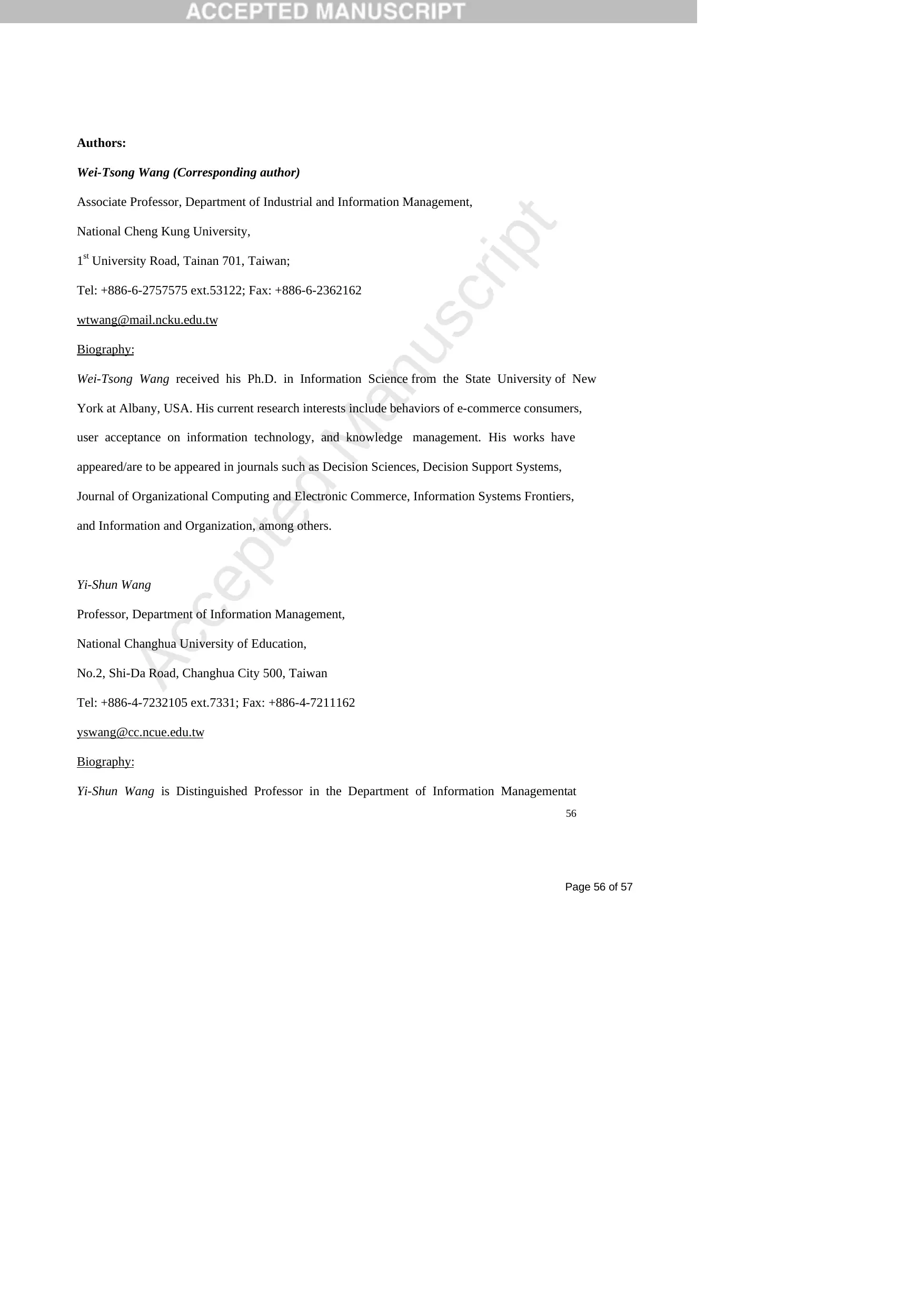
Page 56 of 57
Accepted Manuscript
56
Authors:
Wei-Tsong Wang (Corresponding author)
Associate Professor, Department of Industrial and Information Management,
National Cheng Kung University,
1st University Road, Tainan 701, Taiwan;
Tel: +886-6-2757575 ext.53122; Fax: +886-6-2362162
wtwang@mail.ncku.edu.tw
Biography:
Wei-Tsong Wang received his Ph.D. in Information Science from the State University of New
York at Albany, USA. His current research interests include behaviors of e-commerce consumers,
user acceptance on information technology, and knowledge management. His works have
appeared/are to be appeared in journals such as Decision Sciences, Decision Support Systems,
Journal of Organizational Computing and Electronic Commerce, Information Systems Frontiers,
and Information and Organization, among others.
Yi-Shun Wang
Professor, Department of Information Management,
National Changhua University of Education,
No.2, Shi-Da Road, Changhua City 500, Taiwan
Tel: +886-4-7232105 ext.7331; Fax: +886-4-7211162
yswang@cc.ncue.edu.tw
Biography:
Yi-Shun Wang is Distinguished Professor in the Department of Information Managementat
Accepted Manuscript
56
Authors:
Wei-Tsong Wang (Corresponding author)
Associate Professor, Department of Industrial and Information Management,
National Cheng Kung University,
1st University Road, Tainan 701, Taiwan;
Tel: +886-6-2757575 ext.53122; Fax: +886-6-2362162
wtwang@mail.ncku.edu.tw
Biography:
Wei-Tsong Wang received his Ph.D. in Information Science from the State University of New
York at Albany, USA. His current research interests include behaviors of e-commerce consumers,
user acceptance on information technology, and knowledge management. His works have
appeared/are to be appeared in journals such as Decision Sciences, Decision Support Systems,
Journal of Organizational Computing and Electronic Commerce, Information Systems Frontiers,
and Information and Organization, among others.
Yi-Shun Wang
Professor, Department of Information Management,
National Changhua University of Education,
No.2, Shi-Da Road, Changhua City 500, Taiwan
Tel: +886-4-7232105 ext.7331; Fax: +886-4-7211162
yswang@cc.ncue.edu.tw
Biography:
Yi-Shun Wang is Distinguished Professor in the Department of Information Managementat
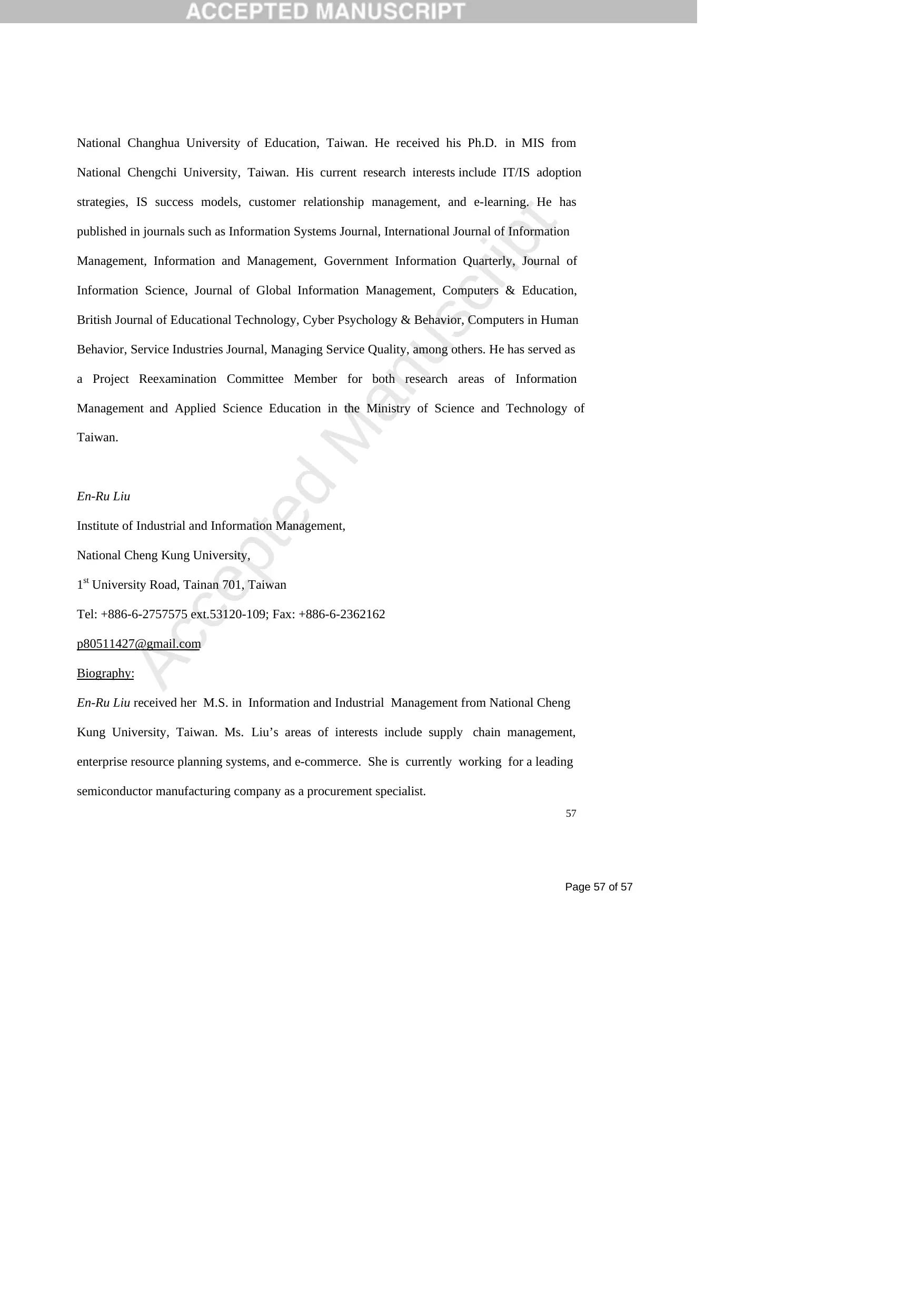
Page 57 of 57
Accepted Manuscript
57
National Changhua University of Education, Taiwan. He received his Ph.D. in MIS from
National Chengchi University, Taiwan. His current research interests include IT/IS adoption
strategies, IS success models, customer relationship management, and e-learning. He has
published in journals such as Information Systems Journal, International Journal of Information
Management, Information and Management, Government Information Quarterly, Journal of
Information Science, Journal of Global Information Management, Computers & Education,
British Journal of Educational Technology, Cyber Psychology & Behavior, Computers in Human
Behavior, Service Industries Journal, Managing Service Quality, among others. He has served as
a Project Reexamination Committee Member for both research areas of Information
Management and Applied Science Education in the Ministry of Science and Technology of
Taiwan.
En-Ru Liu
Institute of Industrial and Information Management,
National Cheng Kung University,
1st University Road, Tainan 701, Taiwan
Tel: +886-6-2757575 ext.53120-109; Fax: +886-6-2362162
p80511427@gmail.com
Biography:
En-Ru Liu received her M.S. in Information and Industrial Management from National Cheng
Kung University, Taiwan. Ms. Liu’s areas of interests include supply chain management,
enterprise resource planning systems, and e-commerce. She is currently working for a leading
semiconductor manufacturing company as a procurement specialist.
Accepted Manuscript
57
National Changhua University of Education, Taiwan. He received his Ph.D. in MIS from
National Chengchi University, Taiwan. His current research interests include IT/IS adoption
strategies, IS success models, customer relationship management, and e-learning. He has
published in journals such as Information Systems Journal, International Journal of Information
Management, Information and Management, Government Information Quarterly, Journal of
Information Science, Journal of Global Information Management, Computers & Education,
British Journal of Educational Technology, Cyber Psychology & Behavior, Computers in Human
Behavior, Service Industries Journal, Managing Service Quality, among others. He has served as
a Project Reexamination Committee Member for both research areas of Information
Management and Applied Science Education in the Ministry of Science and Technology of
Taiwan.
En-Ru Liu
Institute of Industrial and Information Management,
National Cheng Kung University,
1st University Road, Tainan 701, Taiwan
Tel: +886-6-2757575 ext.53120-109; Fax: +886-6-2362162
p80511427@gmail.com
Biography:
En-Ru Liu received her M.S. in Information and Industrial Management from National Cheng
Kung University, Taiwan. Ms. Liu’s areas of interests include supply chain management,
enterprise resource planning systems, and e-commerce. She is currently working for a leading
semiconductor manufacturing company as a procurement specialist.
1 out of 58
Your All-in-One AI-Powered Toolkit for Academic Success.
+13062052269
info@desklib.com
Available 24*7 on WhatsApp / Email
![[object Object]](/_next/static/media/star-bottom.7253800d.svg)
Unlock your academic potential
© 2024 | Zucol Services PVT LTD | All rights reserved.
